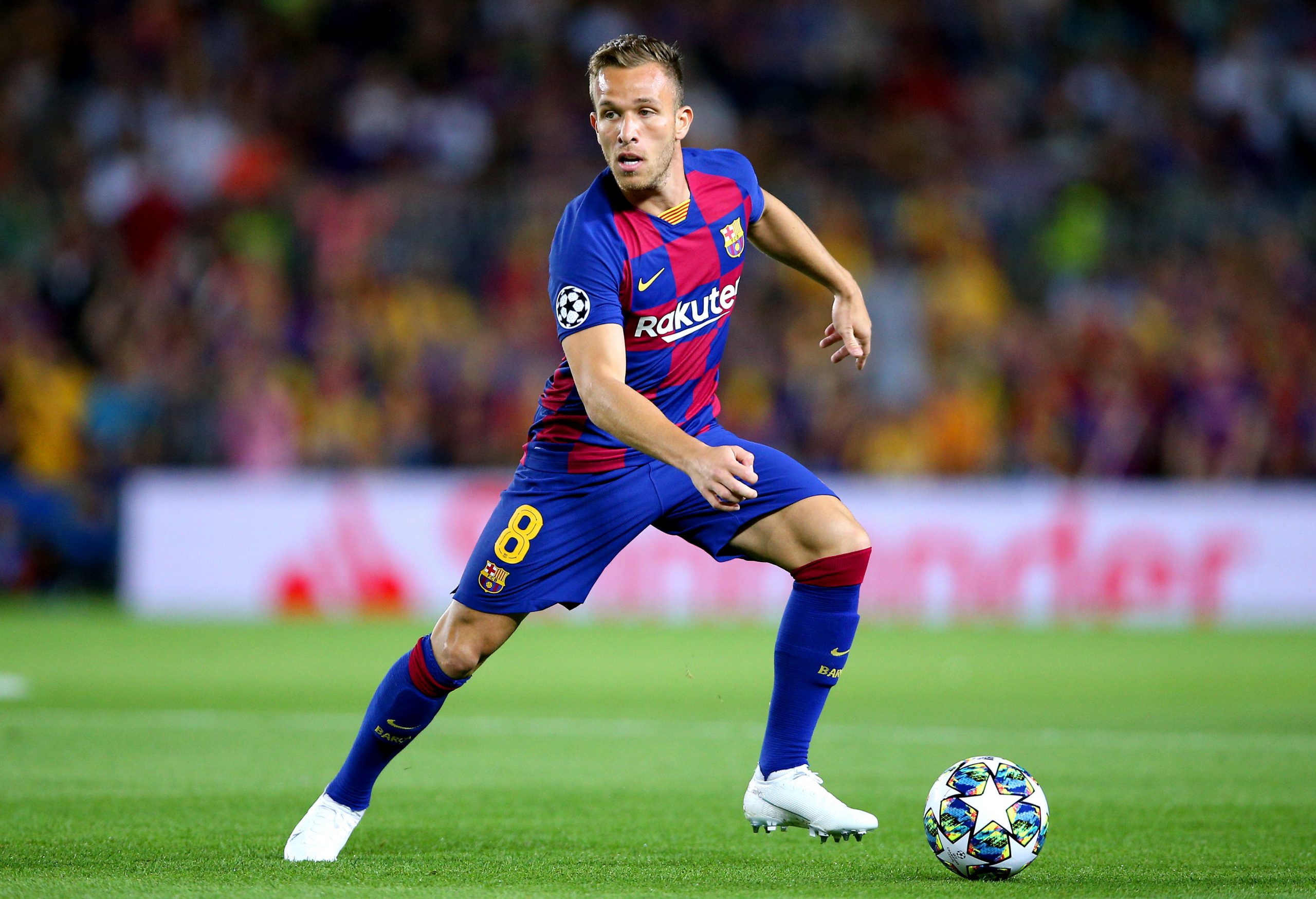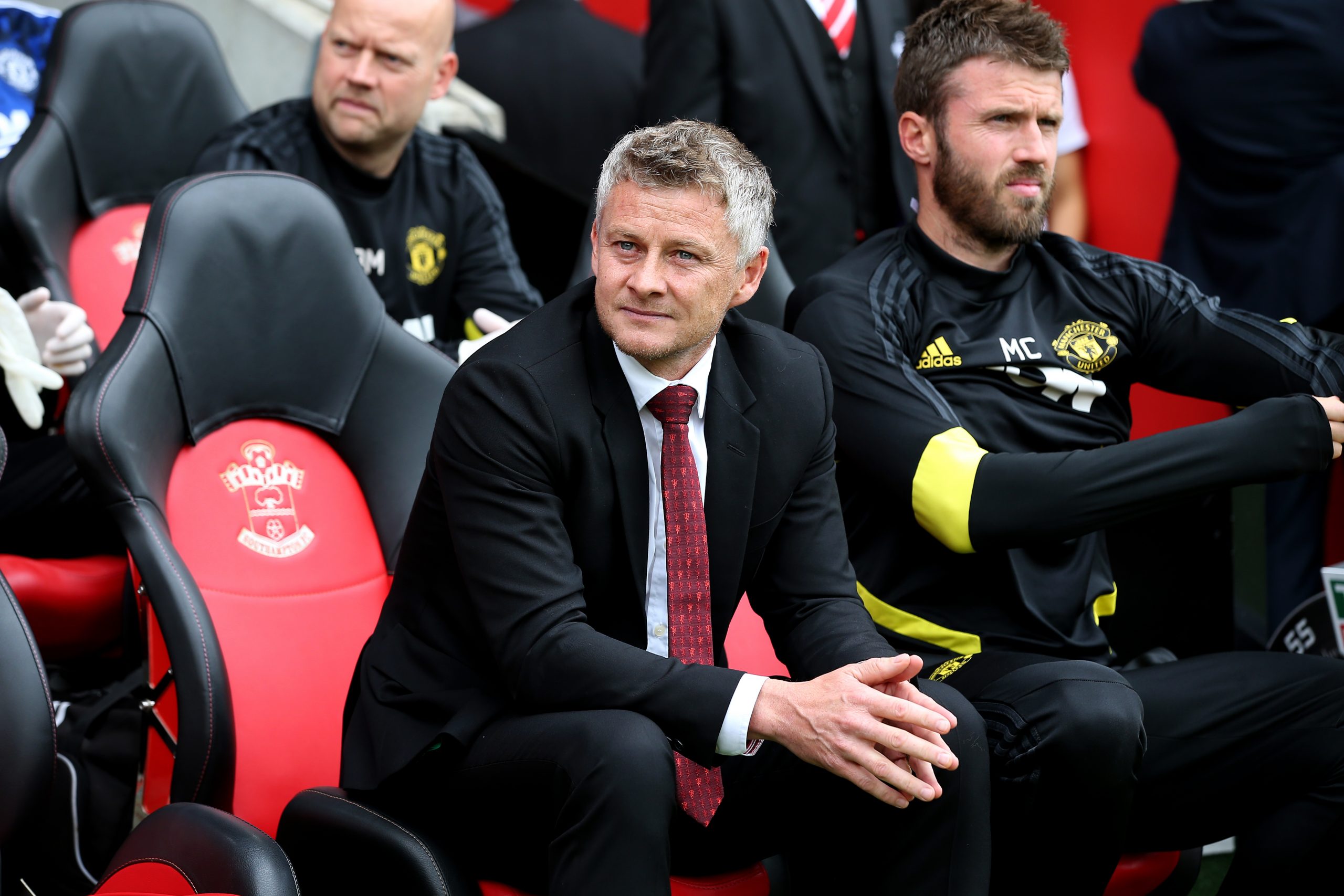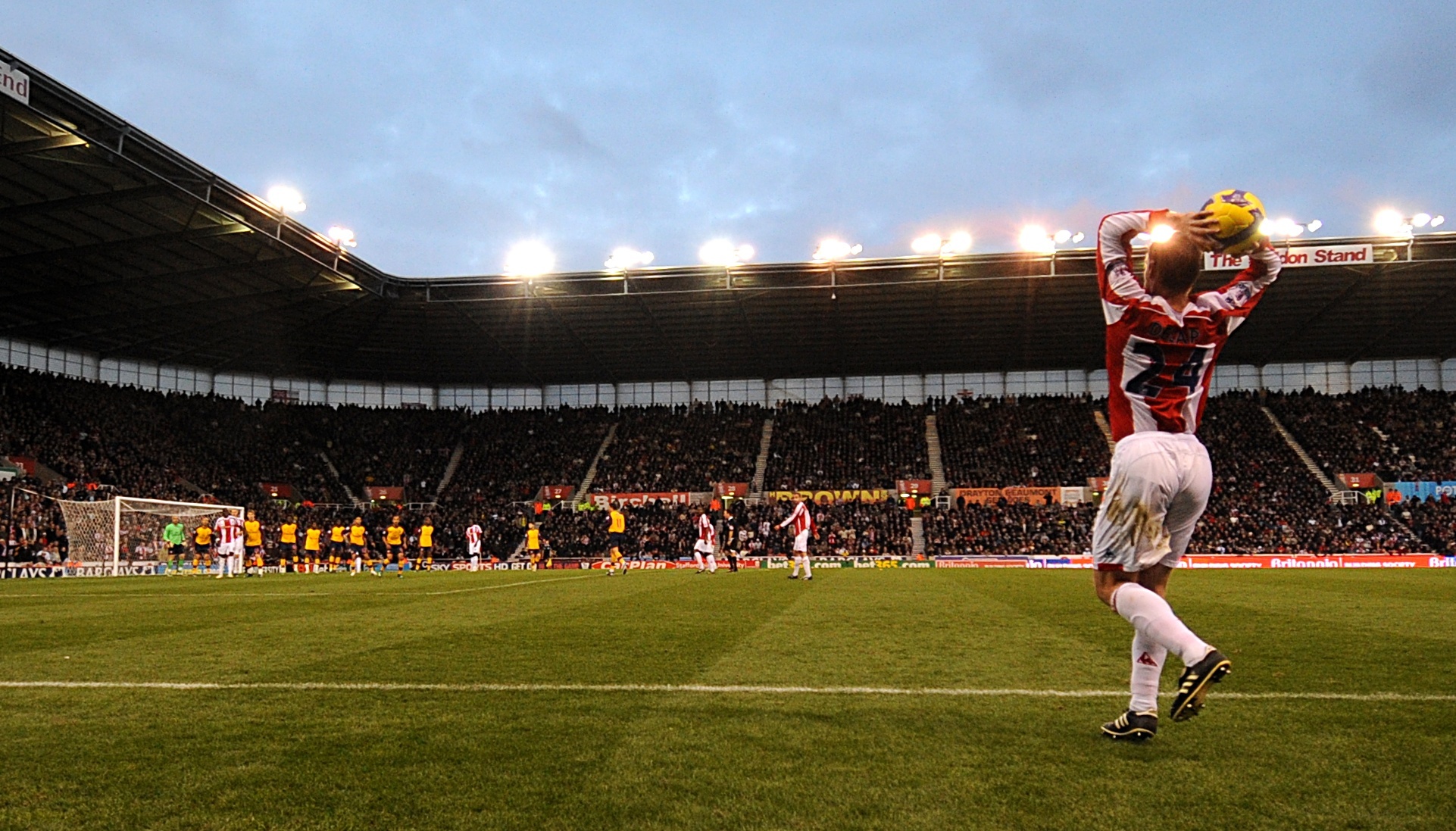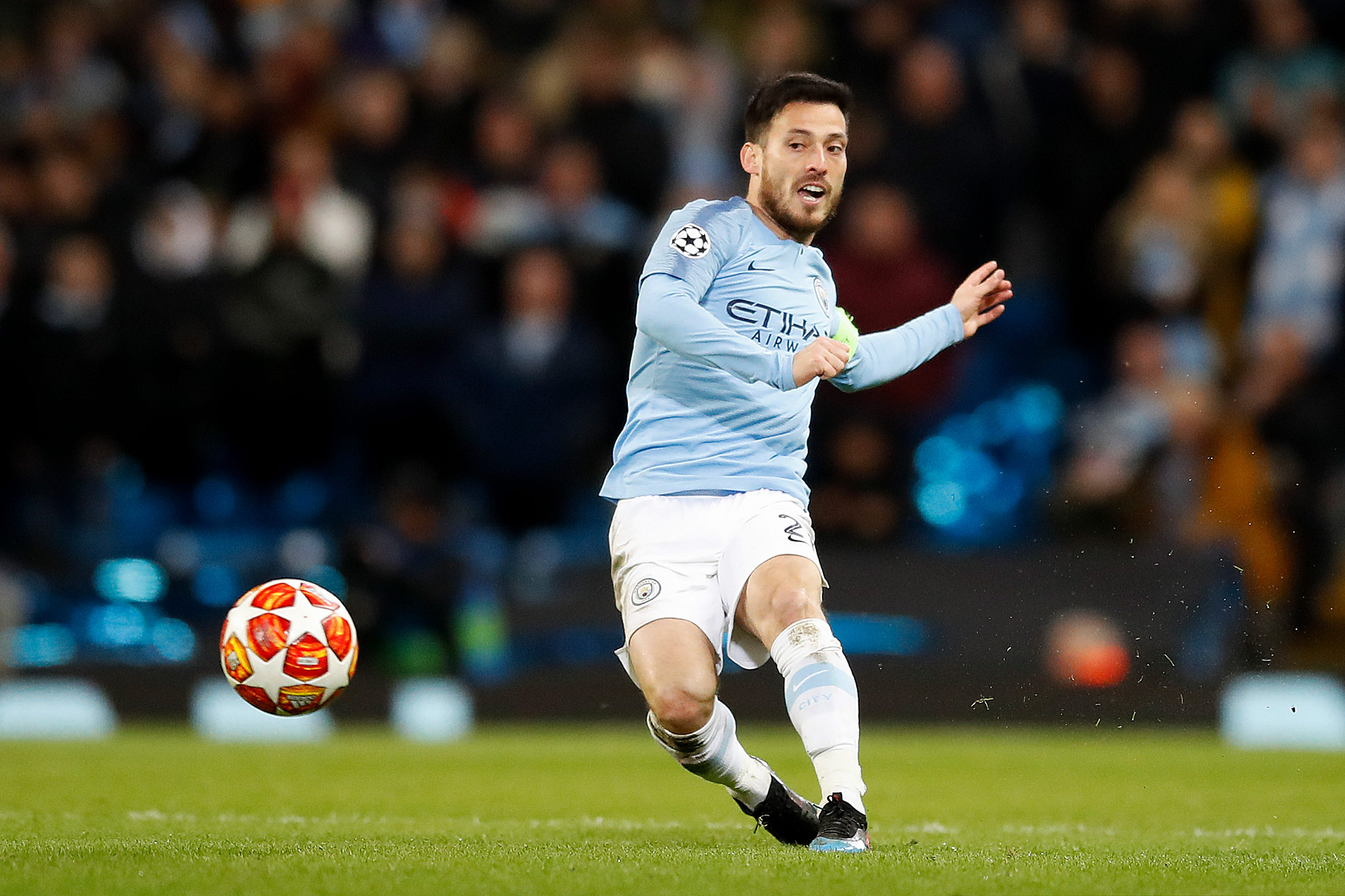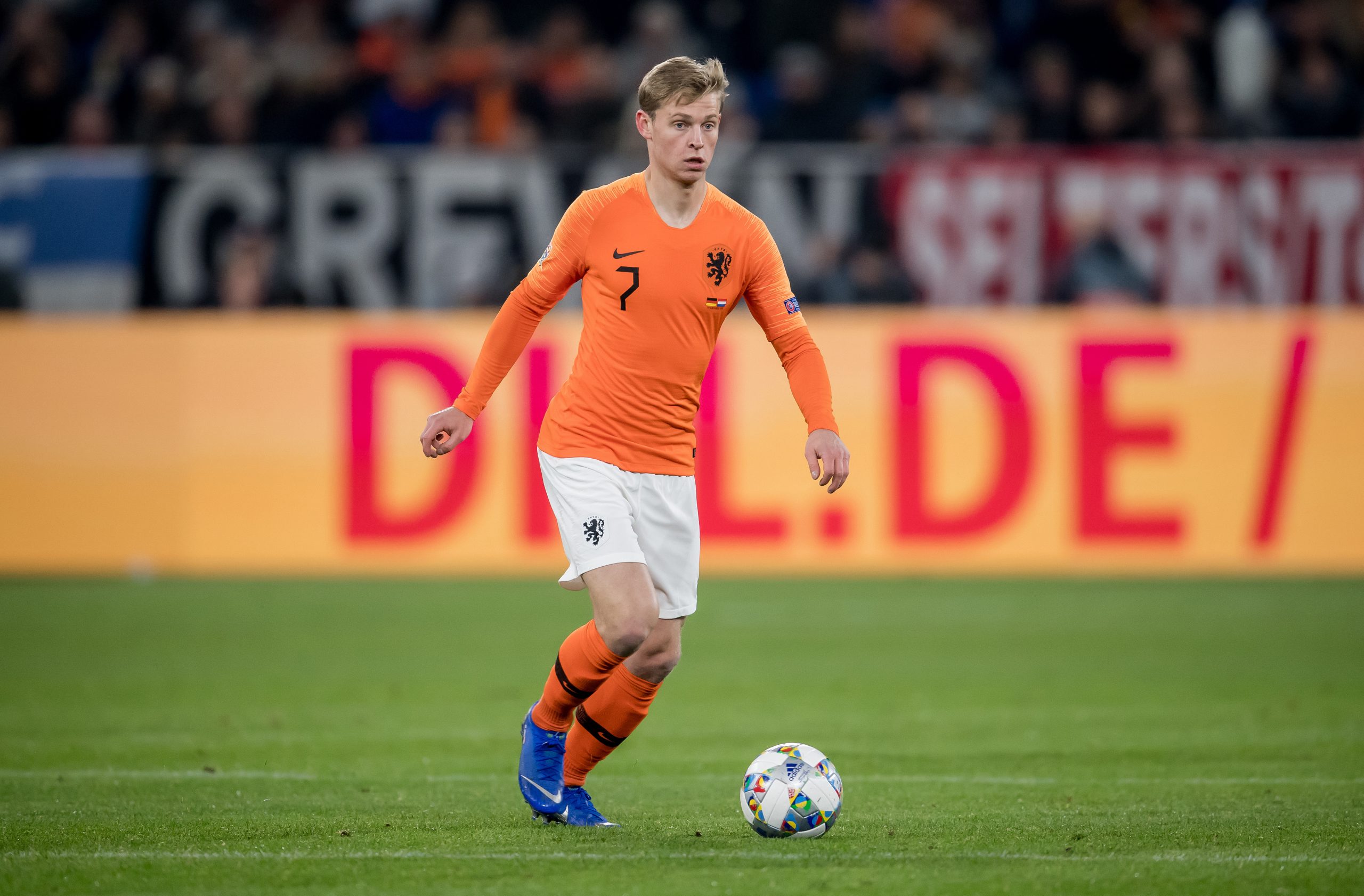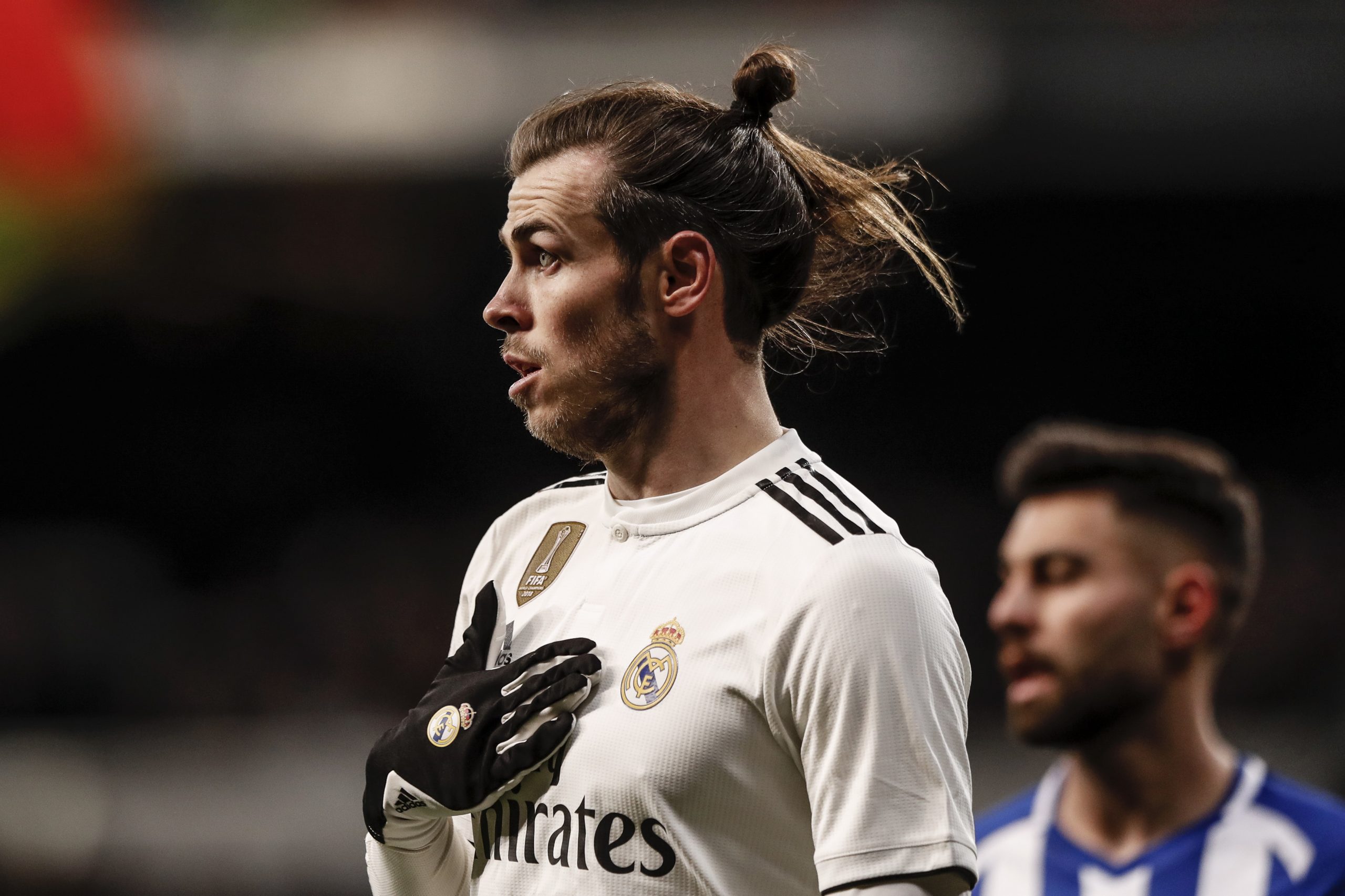Spare a thought for all the mortal goal-scoring experts the current Bundesliga has to offer. Keyword: mortal. Because whatever Robert Lewandowski and Timo Werner are currently doing in front of goal must be illegal in some countries. The prolific Bayern striker and the lightning-quick frontman of RB Leipzig stand at goal tallies of 16 and 12, respectively, 12 matchdays into the 2018–19 season. While Lewandowski and Werner have been in ludicrous form so far, the standout performances the two stars get all the attention and glory. So let us — we, fair people at StatsBomb — shine some light on the ‘other’ goal scorers one can find in the highest level of German pro football. Exempting those two, there are seven players who have scored at least six goals this campaign. Sorry, Marcus Thuram (five goals), Serge Gnabry (four goals plus one glorious moustache) and Jadon Sancho (four), but you awesome youngsters will surely come up in a future Bundesliga digest on this here fine website. The seven non-alien penalty box poachers can be divided into four categories. The question is — are these guys for real, or just on a very nice hot streak?
The (fairly) unknowns
A big, big shoutout to Rouwen Hennings. The 32-year old Fortuna Düsseldorf attacker flopped at Burnley just three years ago. After being a bench-warmer during their 2016–17 Championship campaign, Hennings was let go on a free transfer after Düsseldorf was promoted. The veteran lefty is now enjoying the best season of his career — which took him to four other German clubs in the lower-level leagues — by a wide margin. Hennings has already scored nine goals this Bundesliga season, three from the penalty spot, the rest from, ehm, quite the hot finishing touch he's applied in and around the box. Fortuna players not named Hennings have just mustered six goals in twelve league games so far, so the streaky shooting of their frontman has been more than welcome in the early months of a season that has the makings of a tough relegation battle for Düsseldorf. 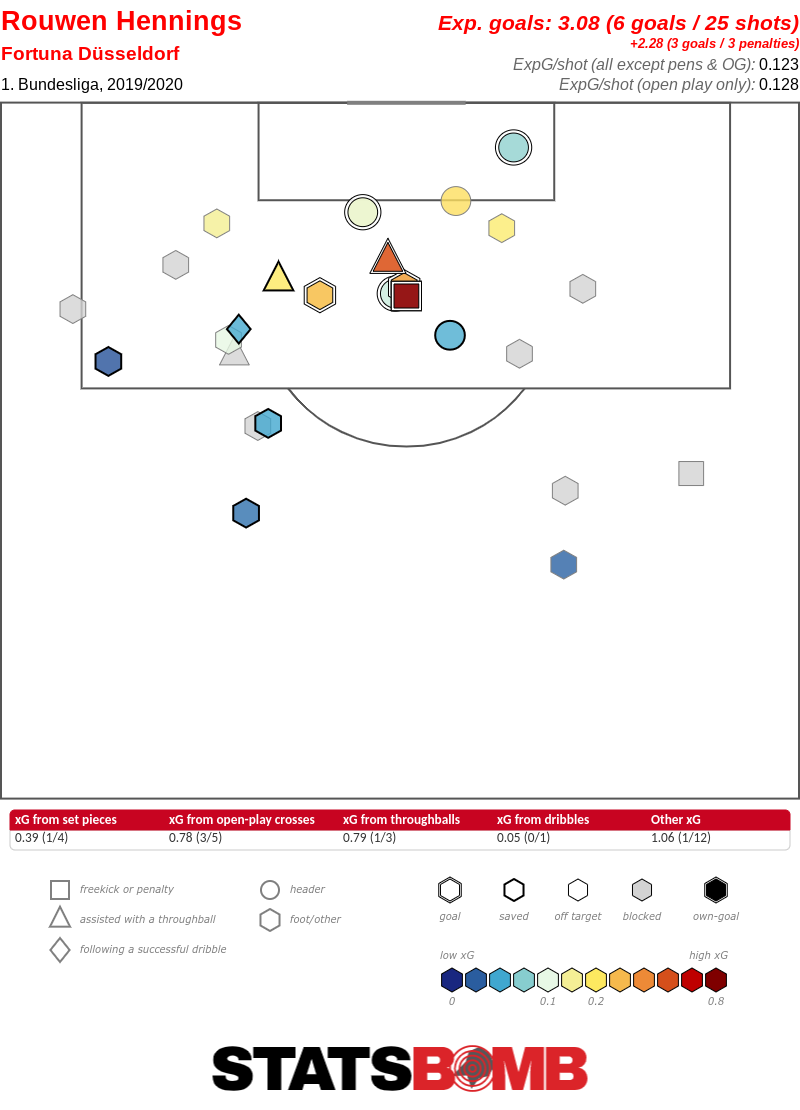 The other fairly anonymous name toward the top of the Bundesliga’s goal scorers charts seems to have more staying power given his all-around skills. Sebastian Andersson (28) is utterly crucial to surprise outfit Union Berlin. The Christmas carol club from the capital city is on a three-game winning streak, with Andersson scoring three crucial goals in the last two wins (a brace in the 2–3 road win at Mainz, the stoppage time clincher in a 2–0 home upset of Mönchengladbach). The 6'3" frontman is surprisingly mobile for someone his size, and his off-ball work rate is solid. Andersson may have developed later, but he's still got plenty of years left, and his aerial prowess and diligent pressing make him a reasonable option as a target man in a 4-4-2 formation, should things change at Union, or Sweden call him up. He may not take a lot of shots, with only 1.63 per 90, but when he does, they're lethal. He's averaging a sky-high 0.21 expected goals per shot.
The other fairly anonymous name toward the top of the Bundesliga’s goal scorers charts seems to have more staying power given his all-around skills. Sebastian Andersson (28) is utterly crucial to surprise outfit Union Berlin. The Christmas carol club from the capital city is on a three-game winning streak, with Andersson scoring three crucial goals in the last two wins (a brace in the 2–3 road win at Mainz, the stoppage time clincher in a 2–0 home upset of Mönchengladbach). The 6'3" frontman is surprisingly mobile for someone his size, and his off-ball work rate is solid. Andersson may have developed later, but he's still got plenty of years left, and his aerial prowess and diligent pressing make him a reasonable option as a target man in a 4-4-2 formation, should things change at Union, or Sweden call him up. He may not take a lot of shots, with only 1.63 per 90, but when he does, they're lethal. He's averaging a sky-high 0.21 expected goals per shot. 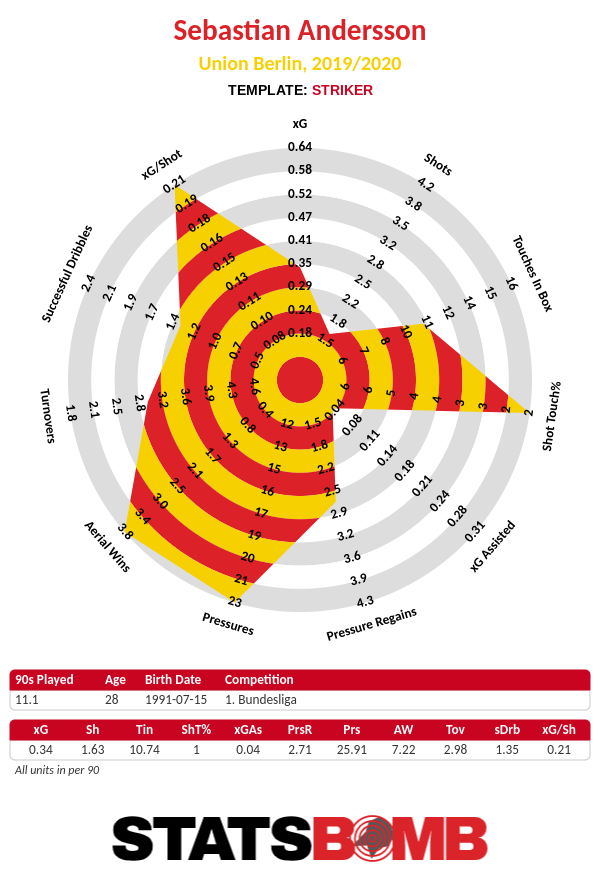 The third ‘unknown’ finding the net with surprising ease is discussed in StatsBomb’s guide of Bundesliga break-out players, published earlier this season. Gonçalo Paciência’s mix of on-ball skill, positional awareness and aggressive play means he's the number one option in Eintracht Frankfurt’s rotation of strikers. A nice achievement for the 25-year-old Portuguese attacker, given the big-name competition in André Silva and Bas Dost. Paciência looks to have leapfrogged his Silva as well in the Portugal national team hierarchy.
The third ‘unknown’ finding the net with surprising ease is discussed in StatsBomb’s guide of Bundesliga break-out players, published earlier this season. Gonçalo Paciência’s mix of on-ball skill, positional awareness and aggressive play means he's the number one option in Eintracht Frankfurt’s rotation of strikers. A nice achievement for the 25-year-old Portuguese attacker, given the big-name competition in André Silva and Bas Dost. Paciência looks to have leapfrogged his Silva as well in the Portugal national team hierarchy.
Nils Petersen is still ‘Nils-ing’
No, Petersen is not the most elegant player to grace the Bundesliga pitches. But his somewhat janky-looking playing style leaves him perpetually underrated. The Freiburg striker continues to do what he does: score some goals. He’s scored six in twelve, bringing his total in the 1. Bundesliga to 50 goals in 113 league games. Just look at this shot map, friends. Good ol’ Nils sure knows what a good shooting opportunity looks like, even if his goal total seems somewhat generous given the underlying xG.
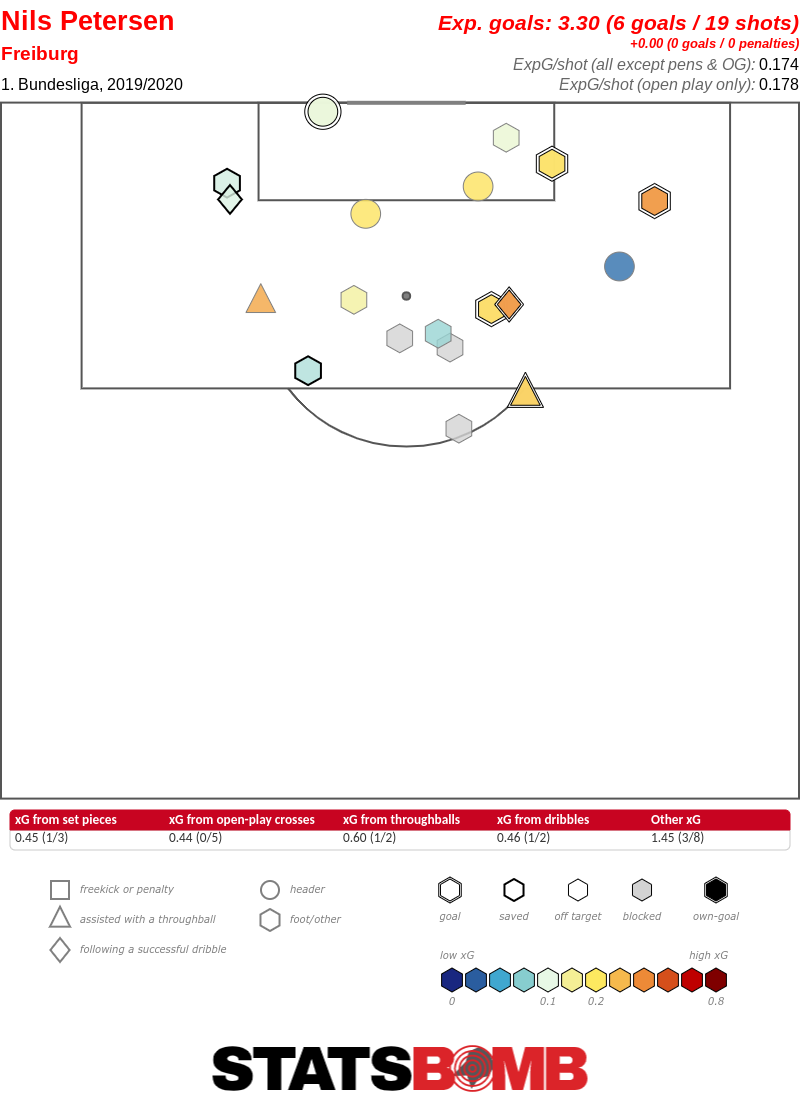 Playmakers who ‘have to’ score to keep their offenses humming
Playmakers who ‘have to’ score to keep their offenses humming
Please, I beg of you. Appreciate the greatness of Marco Reus while we still can. The injury-plagued superstar of Borussia Dortmund has, frustratingly, been turned into somewhat more of an out-and-out second striker under Lucien Favre than the free-wheeling playmaker slash wide creator slash box-hunting attacking force he was in years past. But Reus is still such a good player. Even in a team that is malfunctioning in all types of ways at the moment. 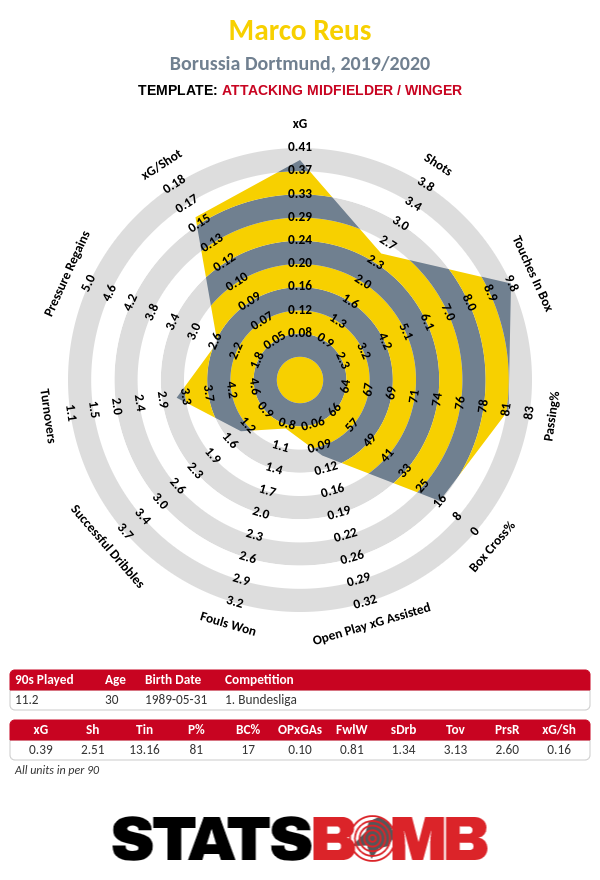 But while we’ve gotten used to Reus chipping in as a goalscorer as well as being the team’s main creative hub, Dortmund’s arch-rivals Schalke 04 have been pleasantly surprised by Amine Harit suddenly finding his scoring boots. The dribbling expert scored just four goals in 60 official games across all competitions in his first two seasons for the Königsblauen. Yet this season he's scored six already, and two have been late game-winners. If the 22-year-old attacking midfielder is able to continue in adding goal-scoring to his already impressive skill-set, we might see his silky smooth dribbles at a bigger club than Schalke sooner rather than later. If Harit is set on achieving that, he’ll need to improve his shot decisions quickly, though.
But while we’ve gotten used to Reus chipping in as a goalscorer as well as being the team’s main creative hub, Dortmund’s arch-rivals Schalke 04 have been pleasantly surprised by Amine Harit suddenly finding his scoring boots. The dribbling expert scored just four goals in 60 official games across all competitions in his first two seasons for the Königsblauen. Yet this season he's scored six already, and two have been late game-winners. If the 22-year-old attacking midfielder is able to continue in adding goal-scoring to his already impressive skill-set, we might see his silky smooth dribbles at a bigger club than Schalke sooner rather than later. If Harit is set on achieving that, he’ll need to improve his shot decisions quickly, though. 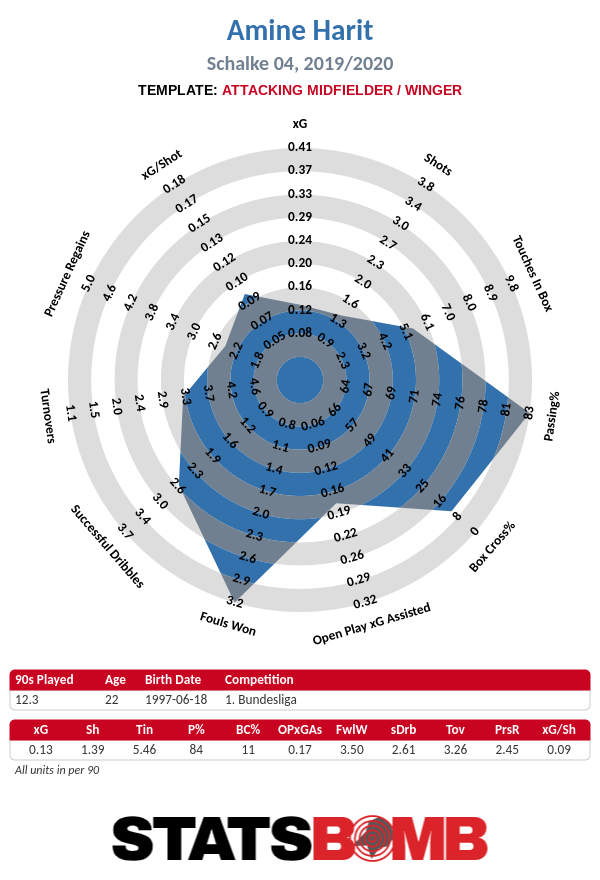 Harit really is doing a lot of things well with the ball at his feet; however, he is neither shooting a lot (1.39 shots per 90), nor taking high-value shots (0.09 xG per shot). If the goals are going to keep coming, at least one of those two things will have to change.
Harit really is doing a lot of things well with the ball at his feet; however, he is neither shooting a lot (1.39 shots per 90), nor taking high-value shots (0.09 xG per shot). If the goals are going to keep coming, at least one of those two things will have to change.
Big Wout keeps surprising
A little more than five years ago, Wout Weghorst was a back-up striker at lowly FC Emmen in the second tier of Dutch football. Weghorst was deemed too tall, too slow, too immobile and too stubborn to be the 'total striker’ Dutch coaches and scouts are often times obsessed with. But mid-level Eredivisie squad Heracles Almelo took a shine to Weghorst, who proved himself a useful target man up top in his first season at the highest level, and developed into a solid goalscorer in his second. Next up for the 6'6" Weghorst was a move to AZ Alkmaar. AZ? The analytically-driven club that ‘doesn’t do long crosses into the box’ signed the Eredivisie's only good aerial specialist? Yup. Turns out, Weghorst can do much more than win headers and poach goals in the box. The big frontman impressed at Alkmaar due to his almost-insane work rate when pressing the opposition’s build-up. When VfL Wolfsburg brought in Weghorst for a lofty (at the time) sum of 10.5 million Euros, Dutch pundits started their fourth ‘Weghorst cycle of doubt'. But really, this dude is just a fine footballer. It's just his size and incredible confidence he openly exudes at times can distract from his funky, but very useful, set of skills. 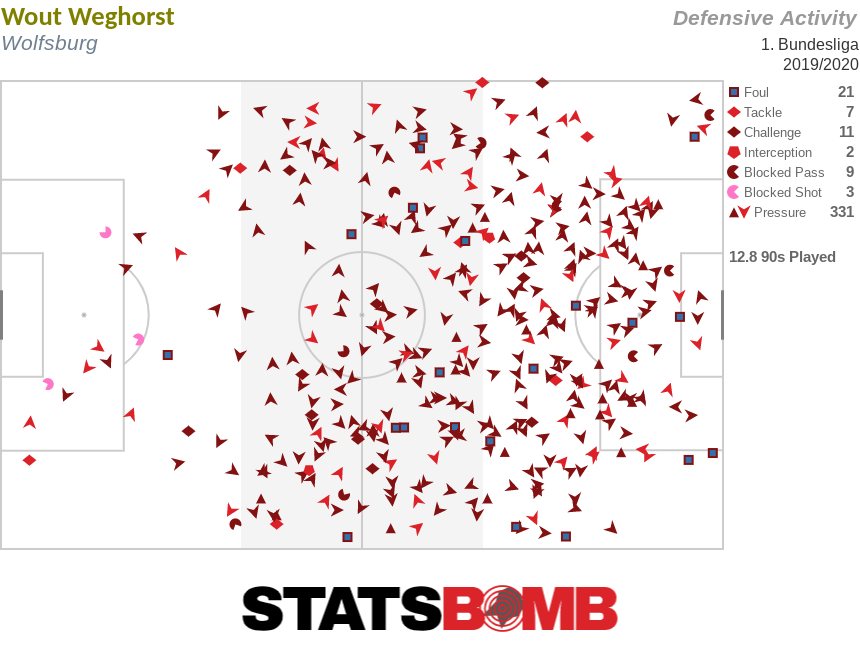
Here are some La Liga players doing good and/or interesting things so far this season.
Arthur’s Increased Attacking Output
Frenkie de Jong has rightly taken plaudits for his good start at Barcelona (including a standing ovation from the Ipurua crowd in Saturday’s win away at Eibar). Despite a certain degree of awkwardness in set attacking situations, as is probably to be expected at this stage, in more open environments his movement and on and off-ball contributions have impressed. 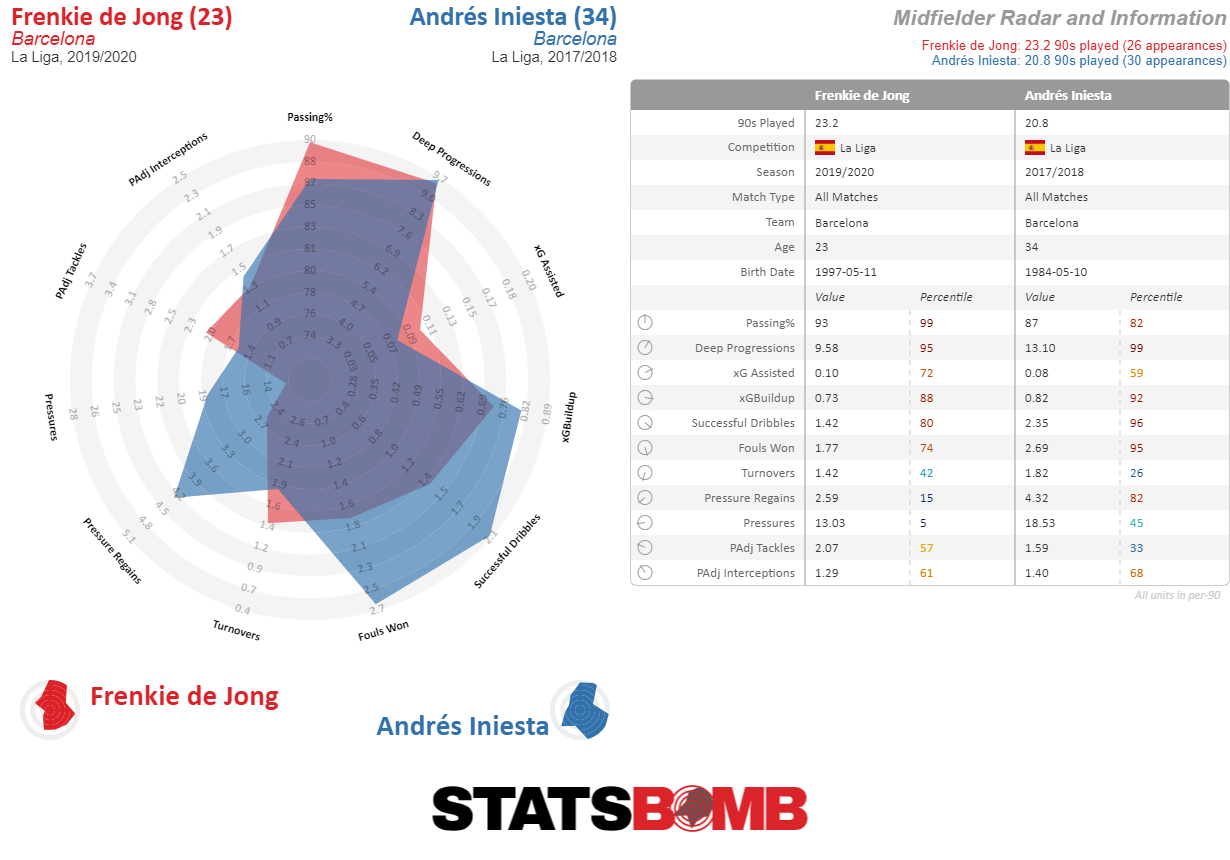 Another member of the Barcelona midfield has also looked good. Last season, Arthur settled in well following his move from Gremio in Brazil. This time around, he has been set the target of increasing his attacking output by coach Ernesto Valverde. He has responded gamely, scoring his first goals for the club, doubling his through-ball and shot output, increasing his key pass and expected assist numbers, and taking a huge jump forward in terms of successful dribbles.
Another member of the Barcelona midfield has also looked good. Last season, Arthur settled in well following his move from Gremio in Brazil. This time around, he has been set the target of increasing his attacking output by coach Ernesto Valverde. He has responded gamely, scoring his first goals for the club, doubling his through-ball and shot output, increasing his key pass and expected assist numbers, and taking a huge jump forward in terms of successful dribbles. 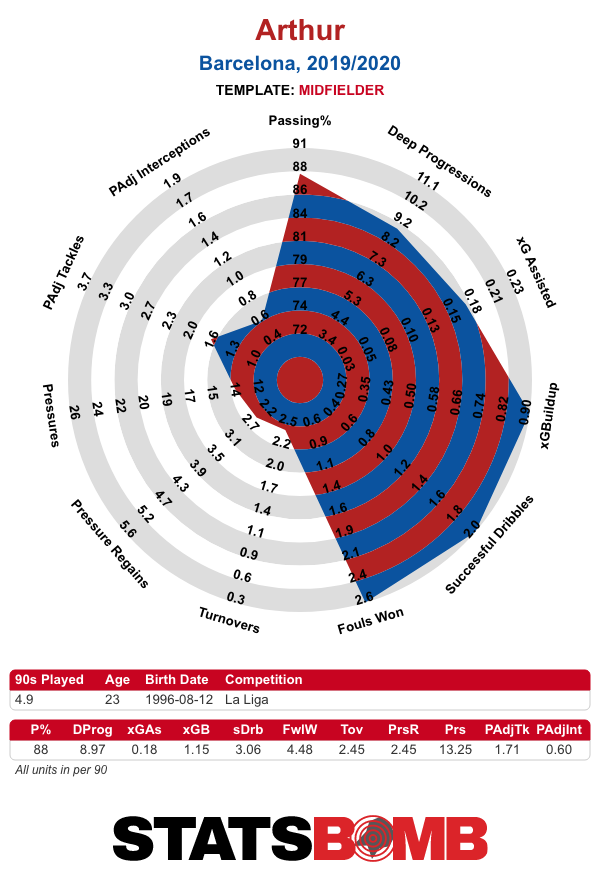 Not since Andrés Iniesta in 2013/14 (thanks Messi Data Biography!) has a regular Barcelona midfielder completed over three dribbles per match. In an admittedly fairly low sample size that is exactly what Arthur is doing. A small, scampering figure of neat touches and tight turns, he has also carried a 100% success rate through his 15 dribble attempts to date (the most anyone else has completed without fail is Thomas Partey’s eight). Arthur has transitioned from more of a controlling role last season (with more deep progressions and a higher passing success rate) to a more aggressively forward-minded one. The arrival of De Jong has helped balance the midfield to make that possible. They are both very able ball-carriers (for the first time since Xavi and Iniesta’s last season together in 2014-15, Barcelona have a pair of regular midfielders who are both carrying the ball over 300 metres per 90), and while any statistical assessment of their impact is complicated by the fact that two of the four league matches they’ve started together have also been two of the three that Lionel Messi has started, on a subjective level, Barcelona’s best midfield lineup already looks to be the pair of them plus one other as circumstances dictate.
Not since Andrés Iniesta in 2013/14 (thanks Messi Data Biography!) has a regular Barcelona midfielder completed over three dribbles per match. In an admittedly fairly low sample size that is exactly what Arthur is doing. A small, scampering figure of neat touches and tight turns, he has also carried a 100% success rate through his 15 dribble attempts to date (the most anyone else has completed without fail is Thomas Partey’s eight). Arthur has transitioned from more of a controlling role last season (with more deep progressions and a higher passing success rate) to a more aggressively forward-minded one. The arrival of De Jong has helped balance the midfield to make that possible. They are both very able ball-carriers (for the first time since Xavi and Iniesta’s last season together in 2014-15, Barcelona have a pair of regular midfielders who are both carrying the ball over 300 metres per 90), and while any statistical assessment of their impact is complicated by the fact that two of the four league matches they’ve started together have also been two of the three that Lionel Messi has started, on a subjective level, Barcelona’s best midfield lineup already looks to be the pair of them plus one other as circumstances dictate.
Loren Morón’s Scoring Start
Real Betis have made a disappointing start to the season and are currently down in the relegation zone. Amidst a series of structural and individual issues, one player has nevertheless managed to stand out. Loren Morón is La Liga’s top scorer, with seven goals. There has been a fair degree of over-performance in relation to his expected goals (xG), but even at an underlying level, the 25-year-old is still approximating the output of an elite striker. 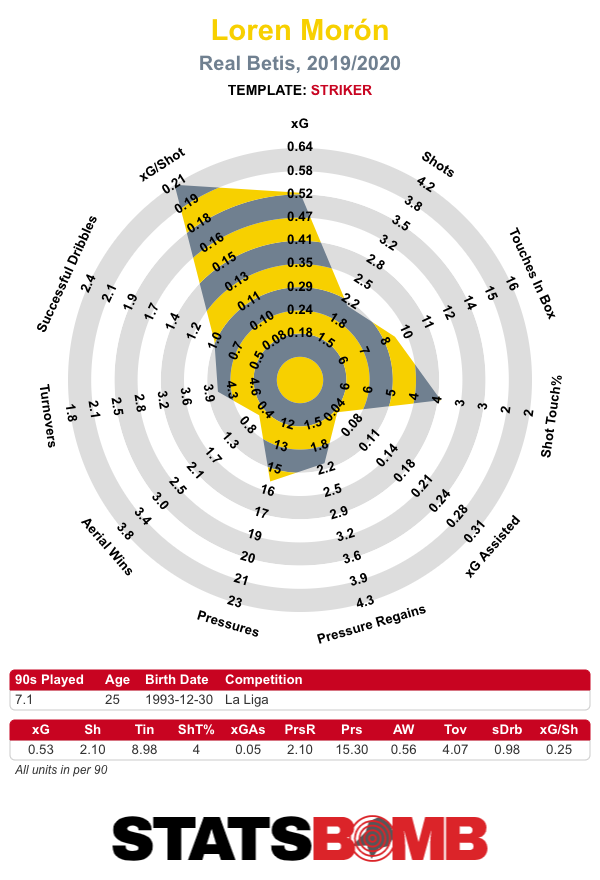 Last season, only 12 players in the big five leagues recorded 0.50 or more xG per 90. Most of those were high volume shooters, with only two of them taking less than three shots per 90. Loren is averaging just over two so far, which does place a question mark over the sustainability of his output. In that group, Edinson Cavani has the most similar shot profile, but he plays for a dominant team in his league. Loren has shown himself to be a sharp and decisive presence inside the area, but he is relatively service reliant.
Last season, only 12 players in the big five leagues recorded 0.50 or more xG per 90. Most of those were high volume shooters, with only two of them taking less than three shots per 90. Loren is averaging just over two so far, which does place a question mark over the sustainability of his output. In that group, Edinson Cavani has the most similar shot profile, but he plays for a dominant team in his league. Loren has shown himself to be a sharp and decisive presence inside the area, but he is relatively service reliant. 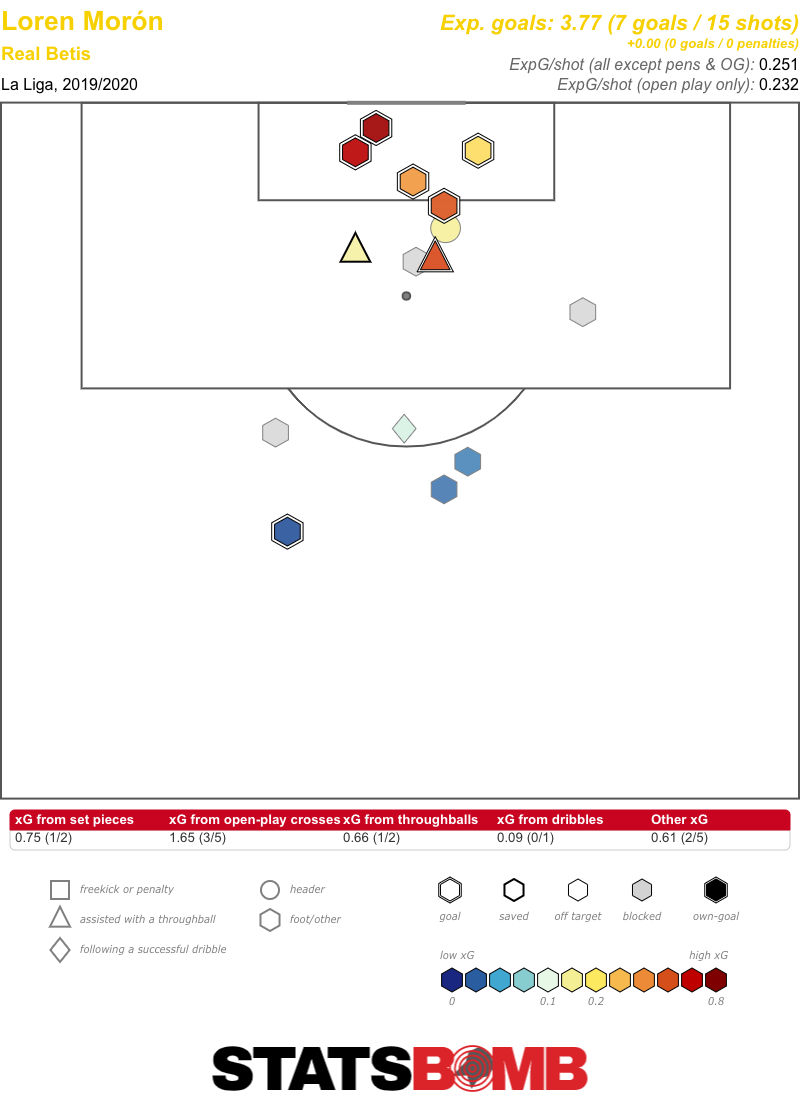 It is also worth noting that at this stage last season, Loren sat on 0.48 xG per 90. Of the five players in the league who were averaging over 0.50 xG per 90 at that juncture, only one of them maintained it over the course of the entire campaign (although Levante’s Roger Martí came very close, at 0.49 xG per 90). Loren ended up with a seasonal average of 0.34 per 90, a smidgen up from his mark during his first half-season in the first team. Can he sustain his improved top-line and underlying numbers this time around?
It is also worth noting that at this stage last season, Loren sat on 0.48 xG per 90. Of the five players in the league who were averaging over 0.50 xG per 90 at that juncture, only one of them maintained it over the course of the entire campaign (although Levante’s Roger Martí came very close, at 0.49 xG per 90). Loren ended up with a seasonal average of 0.34 per 90, a smidgen up from his mark during his first half-season in the first team. Can he sustain his improved top-line and underlying numbers this time around?
Sergio Reguilón’s Attacking Impact
Sergio Reguilón showed enough in his minutes at Real Madrid last season to suggest that he was, at the very least, a competent top-flight performer with room for further growth. This season, on loan at Sevilla, he’s arguably been the best attacking full-back in La Liga. Sevilla’s system under Julen Lopetegui puts a lot of emphasis on the full-backs to get forward and support the attack, and in Reguilón he has a player who relishes the opportunity to constantly drive forward down the left. He is one of only seven players in La Liga to have carried the ball over 300 metres per 90, while only Samuel Chukwueze and Vinícius Junior have carried the ball at a greater average speed. Reguilón also stands out in just how often he gets forward into positions to shoot or assist. His tally of 3.35 shots and key passes per 90 is far more than that of any other full-back with a reasonable number of minutes, while his 4.77 touches inside the box per 90 is again a clear league high among players in his position. He looks comfortable carrying the ball into central areas, maintaining a good panorama of play and picking out some nice passes at pace. Here are his key passes to date:  Defensively, he looks better on the front foot and does struggle a bit with movement in and around him in more set situations. But that is something that can be refined over time. As it is, in Reguilón and Achraf Hakimi (on loan at Borussia Dortmund), Real Madrid have two young and talented full-backs capable of competing in the first team group next season if space opens up for them to do so.
Defensively, he looks better on the front foot and does struggle a bit with movement in and around him in more set situations. But that is something that can be refined over time. As it is, in Reguilón and Achraf Hakimi (on loan at Borussia Dortmund), Real Madrid have two young and talented full-backs capable of competing in the first team group next season if space opens up for them to do so.
Darwin Machís: Shot Machine
Granada have exceeded all expectations on their return to the top flight. They are up in third, just two points behind leaders Barcelona and with the opportunity to go top, at least for a time, with victory at home to Real Betis on Sunday. Theirs has primarily been a collective triumph, but certain individuals have still shone. Goalkeeper Rui Silva has been a solid and assured presence, while Ángel Montoro has proved to be a key ball-progressor and creative force from both open play and set pieces. But the Granada player with the most interesting statistical profile is probably Darwin Machís. He doesn’t really seem to do anything other than carry, dribble and shoot. He attempts fewer passes than all but one of his teammates, carries the ball further that any of them (at one of the quickest speeds in the division), completes far more dribbles than any of them, and also clearly leads the way in terms of shots per 90. 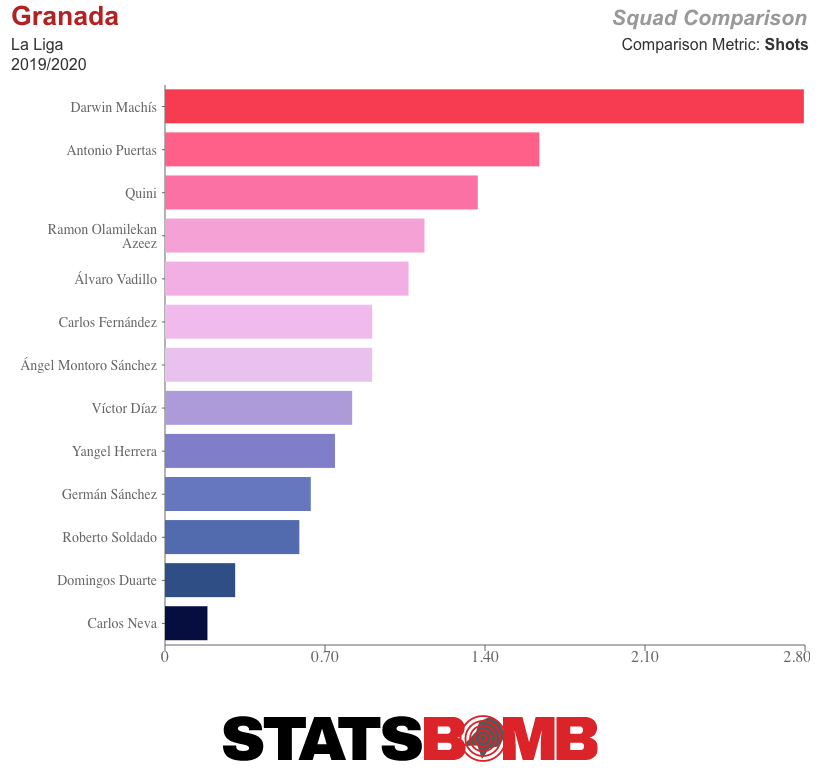 A league-third-high (amongst players with at least 400 minutes) 4.53% of his total touches to date have been shots. They’ve not exactly been a stellar selection of efforts:
A league-third-high (amongst players with at least 400 minutes) 4.53% of his total touches to date have been shots. They’ve not exactly been a stellar selection of efforts:  But within the context of a team who don't necessarily have the personnel to consistently create good looks in open play, a player capable of advancing upfield and getting off shots can still form a useful part of a wider and more varied game plan.
But within the context of a team who don't necessarily have the personnel to consistently create good looks in open play, a player capable of advancing upfield and getting off shots can still form a useful part of a wider and more varied game plan.
There’s an attacker in England who, after two seasons of utter dominance, has fallen down to Earth with good but not great production. His team’s record remains surprisingly strong, but underneath the hood, their expected goals record belies a team not actually at the station they expected to be, lucky to be above their rivals in the table. I’m talking, of course, about Mo Salah and Liverpool. It’s hard to complain about a team that has taken 21 of 21 points in the league and a guy who has three non-penalty goals and three assists in seven league matches, but the statistical record is flashing some warning signs. In 2017-2018, Salah came into the Premier League and set the world on fire. He took four shots per game, and racked up buckets of high quality chances, dribbling past would be defenders with aplomb, leaving them on the ground, and firing shots from the center of the box. His 0.6 expected goals per 90 minutes and 0.2 open play expected goals assisted per 90 led him to a Premier League Player of the Year. Last season, he came back to earth but was still excellent, with 0.4 xG per 90 and 0.22 open play xG assisted per 90. This season though? Through seven league matches Salah has just 0.37 xG per 90 and 0.05 xG assisted per 90. He’s still getting tons of touches in the box, more than last year in fact. But Salah is completing just 30% of his passes in the box or into the box to teammates, as compared to almost 50% last year. He’s also taken just a single shot with his feet within nine yards of goal this season. He had 29 such shots over the past two seasons combined. Perhaps that will change, but he does look somewhat less explosive than he did the last couple years, not turning the corner in the box with the same gusto. Two seasons of 4500 minutes plus playing in international tournaments may be taking its toll. Interestingly, the attack remains near last year's heights. Roberto Firmino and Sadio Mane have been excellent. While the team is not creating from open play like it did two seasons ago, they are finding more goals from set pieces. With the team treading water offensively, Liverpool’s xGD is a far cry from the heights of last season, and quite frankly, the second half of last season is a far cry from the first half: 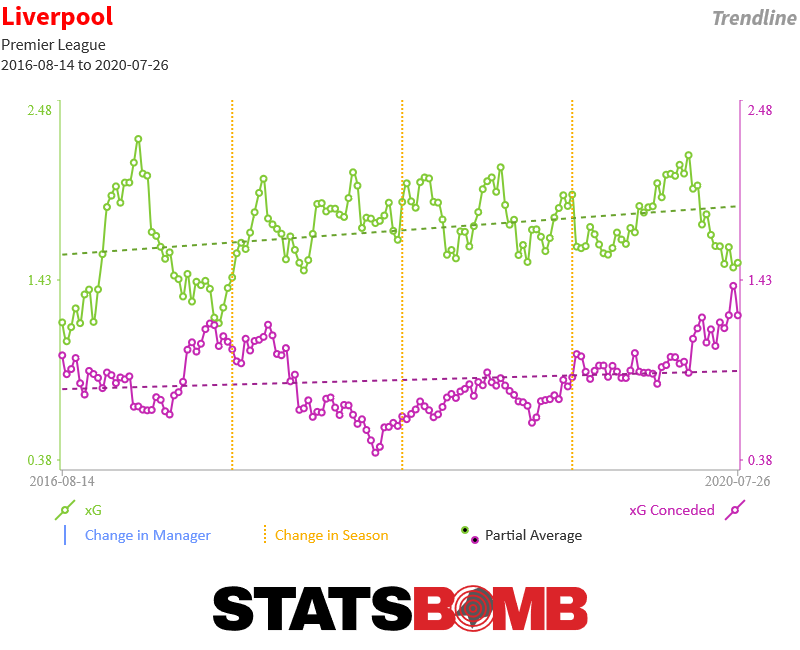 As we saw against Salzburg, it is the defense that is struggling in particular, shipping significantly more high quality chances than it did last season.
As we saw against Salzburg, it is the defense that is struggling in particular, shipping significantly more high quality chances than it did last season. 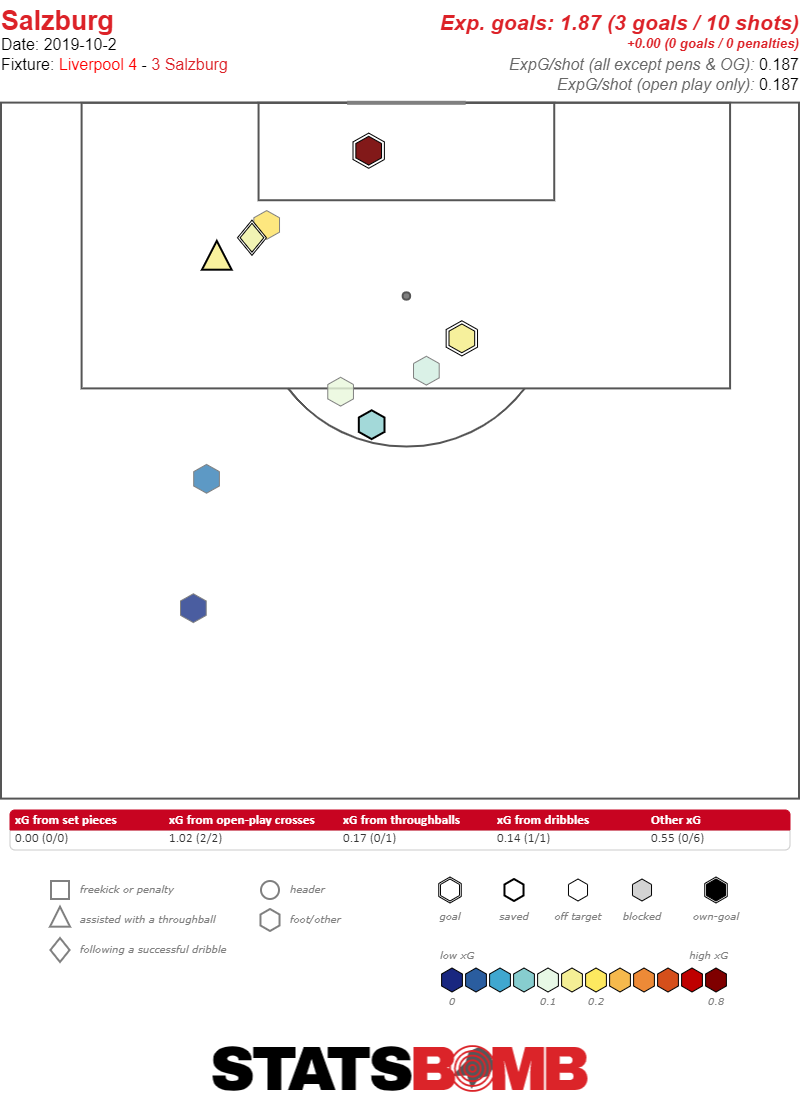 Perhaps the defense is struggling because the defenders are being asked to do too much in attack. Klopp played Andrew Robertson over 4500 minutes last season, rarely rotating his hyper-athletic left back who also was one of the team’s major creative engines. The wear on Robertson appears to be showing, with Robbo getting beaten much more consistently this season.
Perhaps the defense is struggling because the defenders are being asked to do too much in attack. Klopp played Andrew Robertson over 4500 minutes last season, rarely rotating his hyper-athletic left back who also was one of the team’s major creative engines. The wear on Robertson appears to be showing, with Robbo getting beaten much more consistently this season. 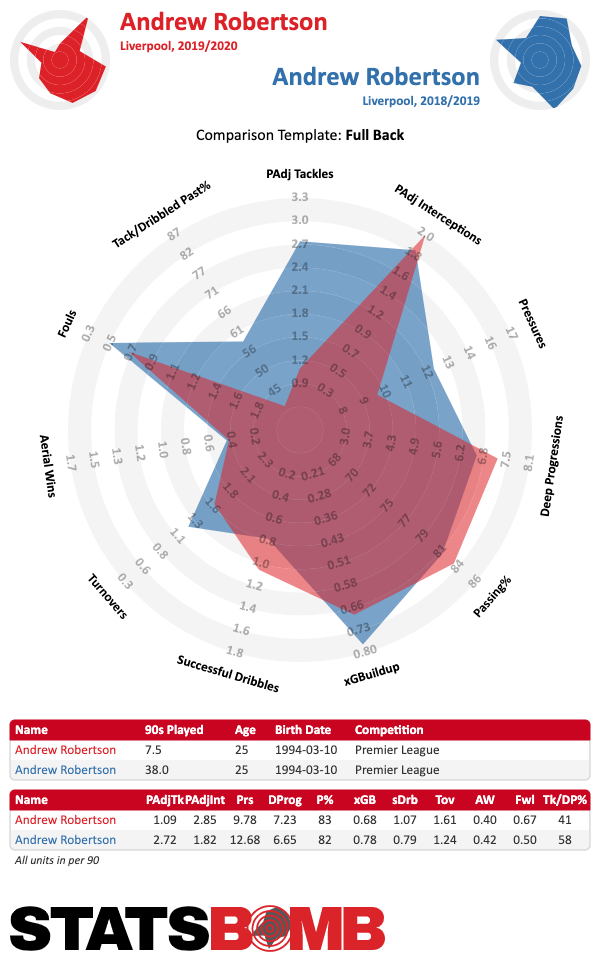 Trent Alexander-Arnold who also played a huge number of minutes at such a demanding position is also struggling to meet last year’s heights and is also one of Liverpool’s key creators. Last season and this season Liverpool got much of its creative output from its two fullbacks, but have perhaps ramped up their intensity even higher as a result of the midfield’s lack of ball progression. Alexander-Arnold and Robertson are combining for over 5.5 touches in the box so far this season, up significantly from about 4 combined last season. Robertson has even more deep progressions this year than last, one of his few increases in output. Robertson’s charging run into the box for a goal against Salzburg was a wonderful piece of skill, but also perhaps indicative of a team that has turned to its fullbacks to do too much, especially given that in the same move he was the player to advance the ball into the opposition half from his own defensive zone. Even so, last year Liverpool asked a lot of its fullbacks and were rock solid defensively. Teams do seem to be exploiting the space left by Alexander-Arnold more ruthlessly. The number of successful passes into areas he nominally would be controlling have increased significantly on a per 90 basis this season. But perhaps the other major change has been the loss of Alisson to start the season. Alisson is significantly more aggressive off his line than Adrian.
Trent Alexander-Arnold who also played a huge number of minutes at such a demanding position is also struggling to meet last year’s heights and is also one of Liverpool’s key creators. Last season and this season Liverpool got much of its creative output from its two fullbacks, but have perhaps ramped up their intensity even higher as a result of the midfield’s lack of ball progression. Alexander-Arnold and Robertson are combining for over 5.5 touches in the box so far this season, up significantly from about 4 combined last season. Robertson has even more deep progressions this year than last, one of his few increases in output. Robertson’s charging run into the box for a goal against Salzburg was a wonderful piece of skill, but also perhaps indicative of a team that has turned to its fullbacks to do too much, especially given that in the same move he was the player to advance the ball into the opposition half from his own defensive zone. Even so, last year Liverpool asked a lot of its fullbacks and were rock solid defensively. Teams do seem to be exploiting the space left by Alexander-Arnold more ruthlessly. The number of successful passes into areas he nominally would be controlling have increased significantly on a per 90 basis this season. But perhaps the other major change has been the loss of Alisson to start the season. Alisson is significantly more aggressive off his line than Adrian.  While Virgil Van Dijk can do almost everything, perhaps he cannot cover for two fullbacks and a less aggressive keeper. Looking at the radars of the two keepers, you can see that Alisson’s “GK Aggressive Distance” - where he makes tackles, interceptions, etc. - is much farther off the line than Adrian, who has otherwise filled in quite admirably. Liverpool’s high line, and very high fullbacks, have survived because Van Dijk is so good at filling in space, but also because their goalkeeper was perhaps also good at protecting the team from dangerous long balls into space. Using Statsbomb’s IQ tactics we can look at how well teams are completing passes against Liverpool that start from above the box in their own half and go into the final third. Last season teams completed 29% of such passes and completed 4.6 such passes per match. So far those numbers are 39% and 6.3.
While Virgil Van Dijk can do almost everything, perhaps he cannot cover for two fullbacks and a less aggressive keeper. Looking at the radars of the two keepers, you can see that Alisson’s “GK Aggressive Distance” - where he makes tackles, interceptions, etc. - is much farther off the line than Adrian, who has otherwise filled in quite admirably. Liverpool’s high line, and very high fullbacks, have survived because Van Dijk is so good at filling in space, but also because their goalkeeper was perhaps also good at protecting the team from dangerous long balls into space. Using Statsbomb’s IQ tactics we can look at how well teams are completing passes against Liverpool that start from above the box in their own half and go into the final third. Last season teams completed 29% of such passes and completed 4.6 such passes per match. So far those numbers are 39% and 6.3. 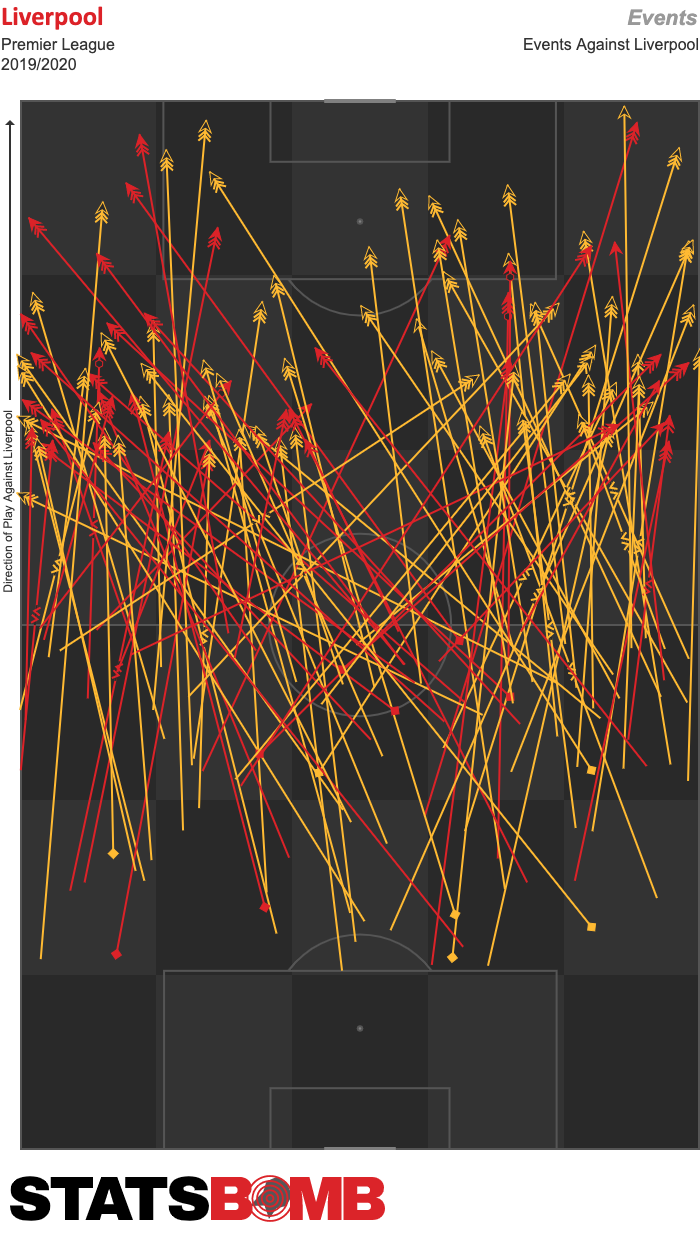 Simpler explanations for Liverpool’s statistical (though otherwise non-existent) struggles may also suffice. Seven matches is a small sample size. Virgil Van Dijk could have experienced a career year at 27 and still be great, just not superhuman this season. Of course, Liverpool may well start producing at last year’s levels again soon. Still, it’s important not to get fooled by the record and to see that maybe there are some cracks in what otherwise seems like an unstoppable juggernaut.
Simpler explanations for Liverpool’s statistical (though otherwise non-existent) struggles may also suffice. Seven matches is a small sample size. Virgil Van Dijk could have experienced a career year at 27 and still be great, just not superhuman this season. Of course, Liverpool may well start producing at last year’s levels again soon. Still, it’s important not to get fooled by the record and to see that maybe there are some cracks in what otherwise seems like an unstoppable juggernaut.
There are a lot of players in the Premier League. Generally speaking, to reach the top flight of English football, most of them are quite good. We're quite used to generalised qualities at this point. Fullbacks who can overlap, inverted wingers who can cut inside and shoot, defensive midfielders who can win the ball back aggressively. But there are some players who just do things differently to everyone else. This might not necessarily be a positive or negative thing, but here are six individuals who have statistically stood out as unusual so far this season.
John McGinn
Of all the players to feature in central midfield this season, only three, Ross Barkley, Tanguy Ndombele and Kevin De Bruyne (interpreting “central midfield” loosely here), have made more successful dribbles per 90 than John McGinn. Only McGinn’s Villa teammate Jack Grealish has won more fouls per 90 than the Scotland international. So we know what it is that he does. But on the other side, no central midfielder is making fewer passes per 90 than McGinn. This is someone who seems to choose to dribble and thus draw fouls over passing the ball at every possible opportunity. 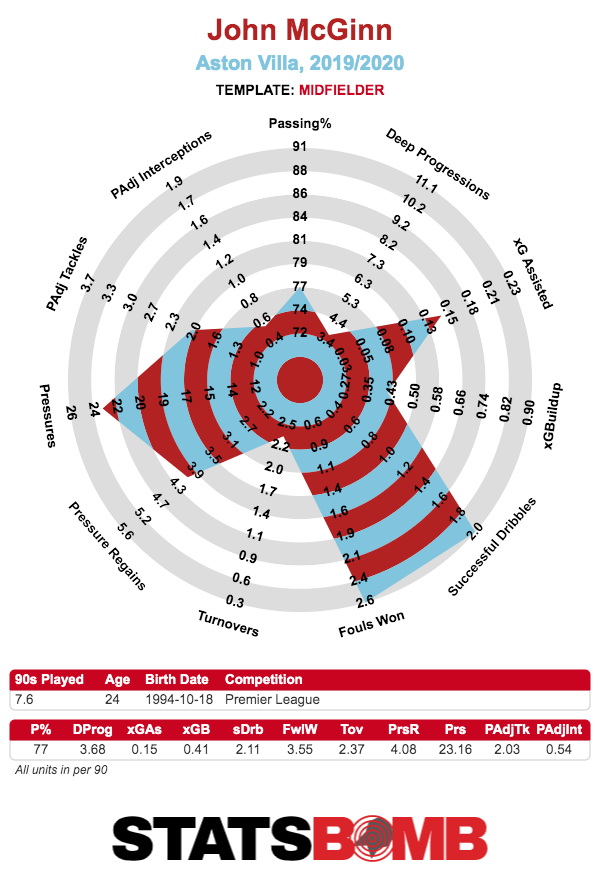 When McGinn does pass the ball, he isn’t shy about pinging it, with the seventh longest average pass length of any central midfielder. It’s clear in his sonar just how direct he’s willing to go.
When McGinn does pass the ball, he isn’t shy about pinging it, with the seventh longest average pass length of any central midfielder. It’s clear in his sonar just how direct he’s willing to go. 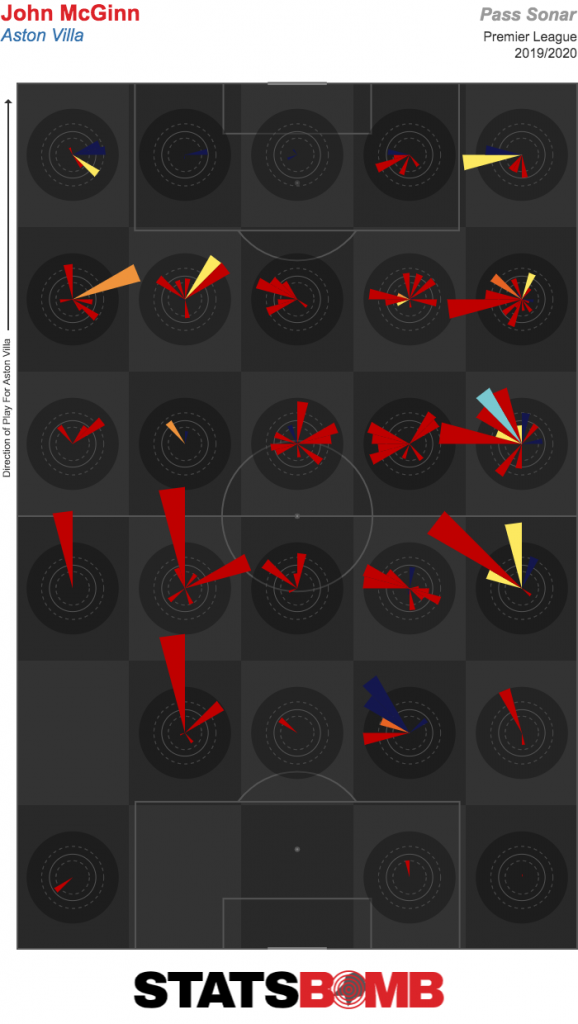 Or alternatively, he’ll carry it, with the third longest carry length in the position. He’ll do anything except the obvious option of keeping it simple and making a pass. This might be because he’s playing with Grealish, natural playmaker extraordinaire. It could simply be that it’s just his natural game. His application and desire to run is the kind of thing that catches the eye of fans, especially in the UK, and it’s hard to argue he’s not a useful player for Villa. He does have this very obvious, somewhat bizarre limit, and Dean Smith needs to construct his side accordingly for it. Unfortunately for McGinn, one would imagine these limitations make the bottom half of the Premier League his ceiling, with a better side that dominates possession unlikely to want to have to tweak the midfield balance to fit him in. For now, though, Villa fans should enjoy the things he does and worry not about his lack of passing.
Or alternatively, he’ll carry it, with the third longest carry length in the position. He’ll do anything except the obvious option of keeping it simple and making a pass. This might be because he’s playing with Grealish, natural playmaker extraordinaire. It could simply be that it’s just his natural game. His application and desire to run is the kind of thing that catches the eye of fans, especially in the UK, and it’s hard to argue he’s not a useful player for Villa. He does have this very obvious, somewhat bizarre limit, and Dean Smith needs to construct his side accordingly for it. Unfortunately for McGinn, one would imagine these limitations make the bottom half of the Premier League his ceiling, with a better side that dominates possession unlikely to want to have to tweak the midfield balance to fit him in. For now, though, Villa fans should enjoy the things he does and worry not about his lack of passing.
Ryan Fredericks
Mohamed Salah has attempted 18 passes inside the box so far this season. That’s the most of any player in the division. Wilfried Zaha and Jamie Vardy are next up with 17 and 13 each. If I told you the next player was a fullback, you might think of Liverpool’s pair of Andy Robertson and Trent Alexander-Arnold, or possibly someone like Oleksandr Zinchenko. You probably wouldn’t expect it to be someone who featured so irregularly for West Ham last season. 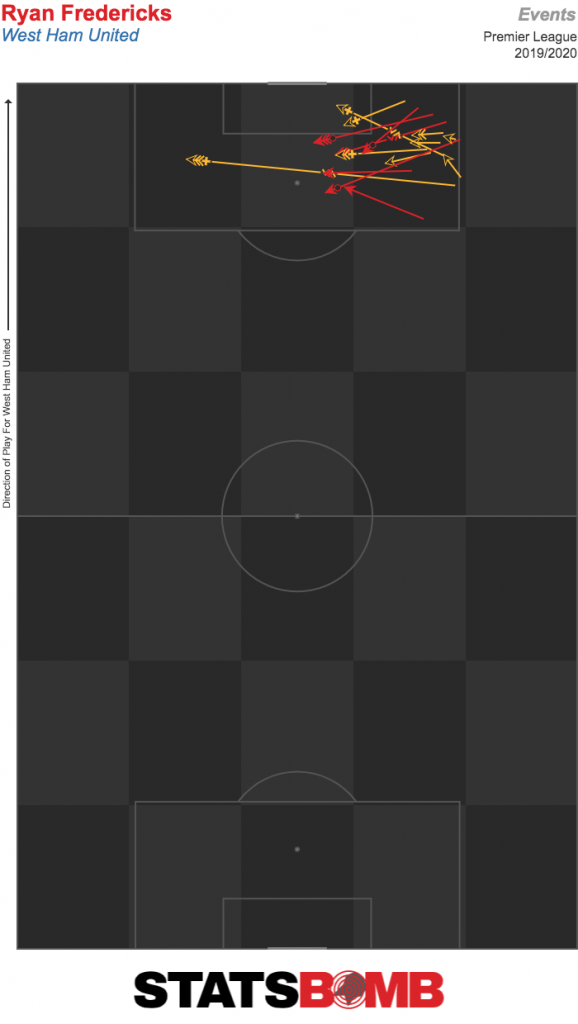 Ryan Fredericks looks a fairly average right back by most other measures. He’s not a hugely active defender, and he’s not progressing the ball up the pitch that well until it gets into the box. The player this is somewhat reminiscent of is Sead Kolasinac. Last season, Kolasinac consistently put up incredible creative numbers by getting forward and delivering cut backs to Arsenal’s talented attack. Fredericks isn’t creating at such a rate yet, but the potential seems to be there. Of course, the other side of Kolasinac was his inability to cover such ground that he could provide a threat in the final third without leaving his side horribly exposed. That Arsenal felt the need to buy Kieran Tierney shows just how little Kolasinac’s unusual skills were seen as helpful in the end. Fredericks may have the advantage here of being a much better athlete. He has the speed to cover much more ground than Kolasinac, to get into the box and still potentially recover defensively if the Hammers get caught out. We’re dealing with a small sample size here, and this is something that could easily drift away as the season goes on, especially if Manuel Pellegrini wants to tighten things up at the back. But Fredericks might have the toolkit to be a very interesting, very adventurous right back who can be an important cog in West Ham’s attack.
Ryan Fredericks looks a fairly average right back by most other measures. He’s not a hugely active defender, and he’s not progressing the ball up the pitch that well until it gets into the box. The player this is somewhat reminiscent of is Sead Kolasinac. Last season, Kolasinac consistently put up incredible creative numbers by getting forward and delivering cut backs to Arsenal’s talented attack. Fredericks isn’t creating at such a rate yet, but the potential seems to be there. Of course, the other side of Kolasinac was his inability to cover such ground that he could provide a threat in the final third without leaving his side horribly exposed. That Arsenal felt the need to buy Kieran Tierney shows just how little Kolasinac’s unusual skills were seen as helpful in the end. Fredericks may have the advantage here of being a much better athlete. He has the speed to cover much more ground than Kolasinac, to get into the box and still potentially recover defensively if the Hammers get caught out. We’re dealing with a small sample size here, and this is something that could easily drift away as the season goes on, especially if Manuel Pellegrini wants to tighten things up at the back. But Fredericks might have the toolkit to be a very interesting, very adventurous right back who can be an important cog in West Ham’s attack.
Dan Burn
When Graham Potter arrived at Brighton, the expectation was that he would change the style of football. The attacking emphasis would be greater, he’d move to a system with three at the back, and defenders previously accustomed to hoofing it would be asked to play more football. The assumption was that new signing Adam Webster, a centre back extremely comfortable taking risks, would be the poster boy for this shift. It was not expected that Potter would make Dan Burn the key player in his new defensive system. 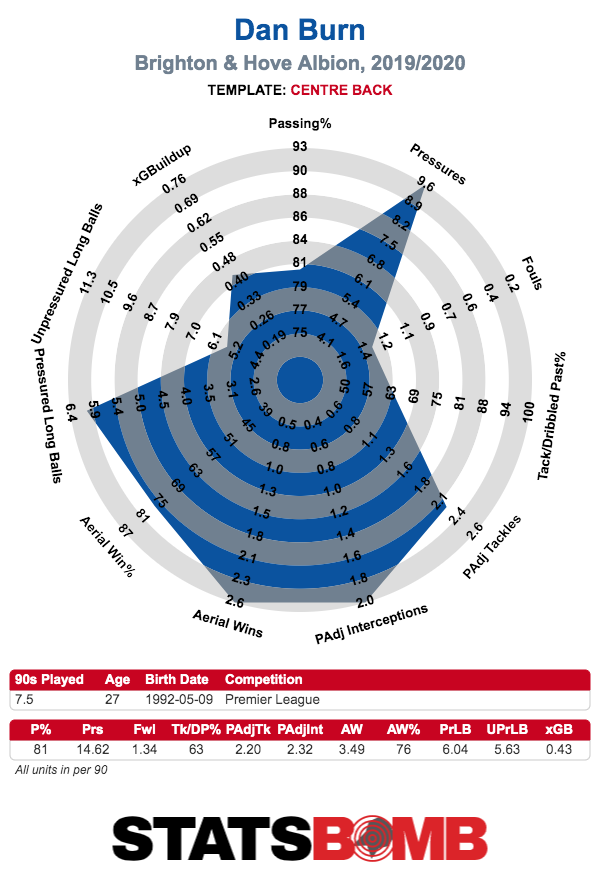 If you’re moving to a back three, having a left footed defender like Burn is always a bonus, especially when he even played occasional left back minutes at Wigan. What we’re seeing so far from Burn is someone extremely comfortable moving forward. While we’re dealing with small sample sizes here, no other centre back in the league gets close to his 0.8 open play passes into the box per 90. Similarly, he leads the division’s centre backs in open play passes in the final third per 90. And it doesn’t stop with his passing range, also posting the most frequent attempted dribbles, though with fully half of them not coming off, he should probably slow down on that front. The wide centre back roles in a back three can often be slightly strange hybrid positions, neither centre back nor full back. Perhaps unexpectedly, Burn is interpreting the role in a particularly expansive manner.
If you’re moving to a back three, having a left footed defender like Burn is always a bonus, especially when he even played occasional left back minutes at Wigan. What we’re seeing so far from Burn is someone extremely comfortable moving forward. While we’re dealing with small sample sizes here, no other centre back in the league gets close to his 0.8 open play passes into the box per 90. Similarly, he leads the division’s centre backs in open play passes in the final third per 90. And it doesn’t stop with his passing range, also posting the most frequent attempted dribbles, though with fully half of them not coming off, he should probably slow down on that front. The wide centre back roles in a back three can often be slightly strange hybrid positions, neither centre back nor full back. Perhaps unexpectedly, Burn is interpreting the role in a particularly expansive manner.
Moritz Leitner
So you’re a promoted side that decides to stick with your progressive brand of football in the Premier League. You’ve also decided to keep the budget down and avoid splashing out on expensive signings. What you need is one of your central midfielders to really step up and progress the ball at an even better rate than last season, while at the same time working harder defensively than before. 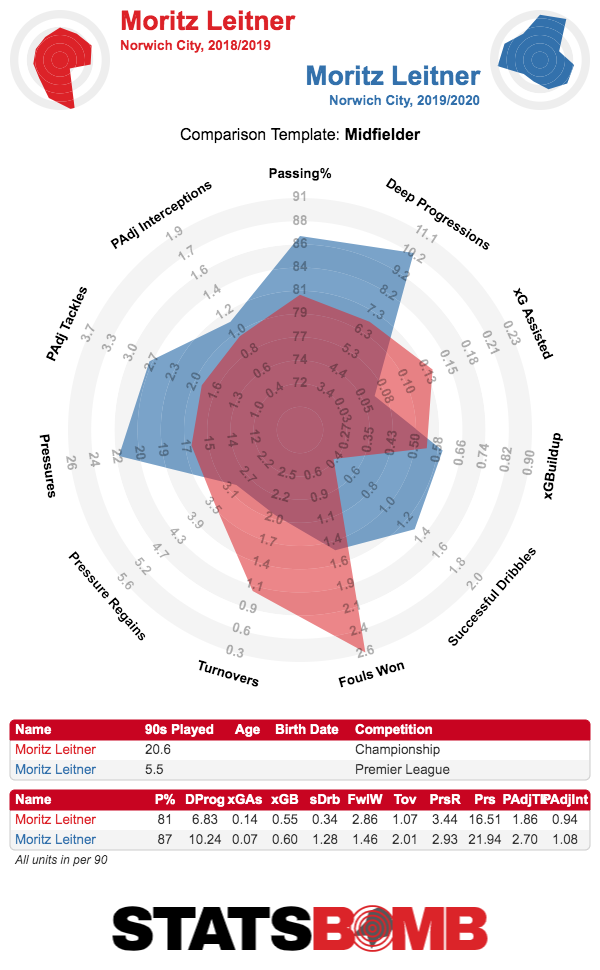 After failing to make the grade at Borussia Dortmund before bouncing around Stuttgart, Lazio and Augsburg, Moritz Leitner has become the hard working creative central midfielder that makes Norwich tick. In the entire league, only Harry Winks is putting up more deep progressions per 90 than the German. Aymeric Laporte and Robertson are the only players with more carries per 90 than Leitner. And even after the ball is worked into the final third, he’s still among the top 20 players for passes within that zone. For a team with only 50% possession. Norwich are more an interesting team this season than they are good, with the side needing to hope their fourth worst expected goal difference in the league will be enough to see them right. When they work the ball into dangerous areas, though, they’re a delight to watch, and Leitner is absolutely a key player in making those situations happen.
After failing to make the grade at Borussia Dortmund before bouncing around Stuttgart, Lazio and Augsburg, Moritz Leitner has become the hard working creative central midfielder that makes Norwich tick. In the entire league, only Harry Winks is putting up more deep progressions per 90 than the German. Aymeric Laporte and Robertson are the only players with more carries per 90 than Leitner. And even after the ball is worked into the final third, he’s still among the top 20 players for passes within that zone. For a team with only 50% possession. Norwich are more an interesting team this season than they are good, with the side needing to hope their fourth worst expected goal difference in the league will be enough to see them right. When they work the ball into dangerous areas, though, they’re a delight to watch, and Leitner is absolutely a key player in making those situations happen.
Dominic Solanke
Let’s not beat around the bush here: Dominic Solanke has been bad at scoring goals. And this isn’t even a situation similar to his time at Liverpool where he just wasn’t finishing good chances. His 0.19 xG per 90 is nothing other than poor, especially compared to what his teammate Callum Wilson is doing. But that’s not the end of the story for Solanke. Only two players in the Premier League are managing more pressures per 90 than the Bournemouth man. What’s more, no striker (if we discount Wilfried Zaha and Gerard Deulofeu on the grounds that they are not really strikers) is making more deep progressions per 90 than Solanke. He’s working hard for the team by closing down opponents, then receiving the ball in deep areas to progress it forward. While playing as a striker. 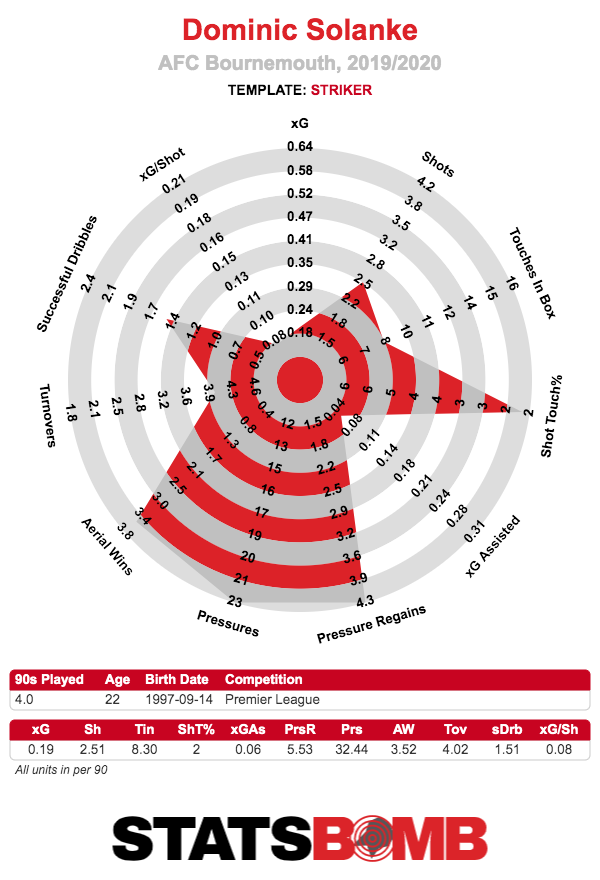 Does it matter that he’s not scoring more? In terms of public perception it seems to. Solanke will be “shit until he scores loads” in the court of public opinion. But in terms of Bournemouth’s system, it’s not obvious that this is a problem. Playing in a front two with Wilson, the more important role is to ensure that the strikers do not become isolated or the midfield gets exposed. Solanke is ideal for this, and should be able to do the role at a higher level than Joshua King.
Does it matter that he’s not scoring more? In terms of public perception it seems to. Solanke will be “shit until he scores loads” in the court of public opinion. But in terms of Bournemouth’s system, it’s not obvious that this is a problem. Playing in a front two with Wilson, the more important role is to ensure that the strikers do not become isolated or the midfield gets exposed. Solanke is ideal for this, and should be able to do the role at a higher level than Joshua King.
Sebastien Haller
Ok, but what if someone was doing a lot of the things Solanke offers, while also scoring goals? Meet Sebastien Haller. 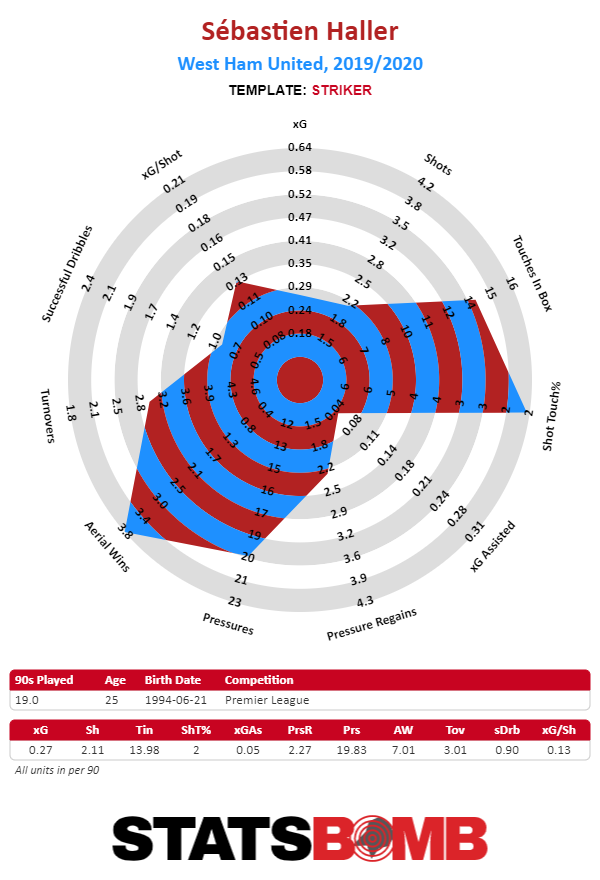 No striker (again, discounting Deulofeu because he isn’t one) is making more open play passes per 90 than Haller. Only Solanke is putting up more deep progressions. He’s exerting a very respectable 20.11 pressures per 90. His shot volume is on the low side, but when he gets them, boy does he get some good ones.
No striker (again, discounting Deulofeu because he isn’t one) is making more open play passes per 90 than Haller. Only Solanke is putting up more deep progressions. He’s exerting a very respectable 20.11 pressures per 90. His shot volume is on the low side, but when he gets them, boy does he get some good ones. 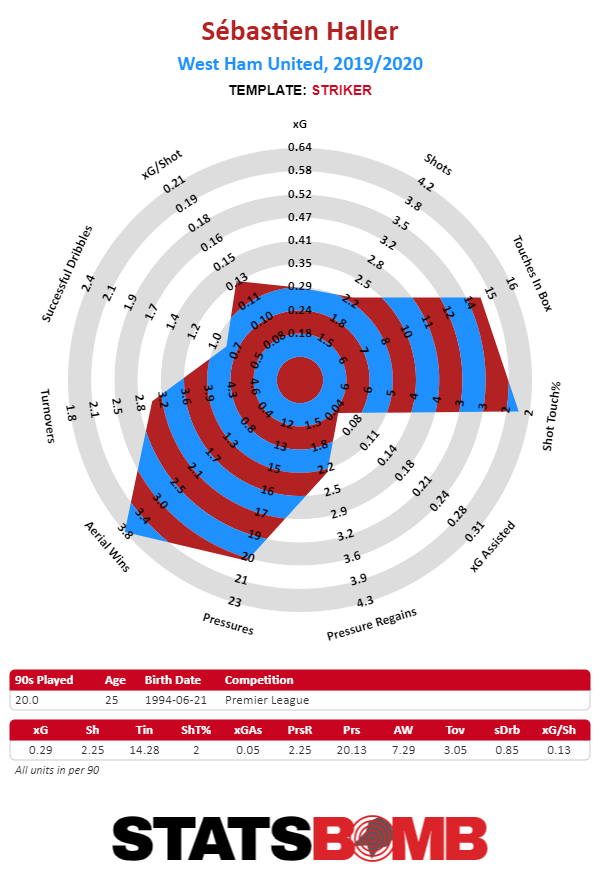 Haller combines the all round play of a striker who typically wouldn’t score a lot of goals with the shot profile of a pure poacher. It’s a fascinating package of skills and West Ham can consider themselves to have a real gem here.
Haller combines the all round play of a striker who typically wouldn’t score a lot of goals with the shot profile of a pure poacher. It’s a fascinating package of skills and West Ham can consider themselves to have a real gem here.
As always, it’s complicated. Any traditional results based analysis will tell you that Manchester United have started the Premier League season very poorly. Five points from four games is never a great haul, and it goes down all the worse when it features underwhelming draws at Wolves and Southampton along with the cherry on the cake, a 2-1 defeat at home to Crystal Palace. Memories of a 4-0 win over Chelsea on the first weekend of the season have all but vanished. This side has just stunk, and there’s no putting a positive spin on it. Right? It didn’t go unnoticed that United’s expected goals haven’t looked so bad, at least at first glance. This made some noises among some United-focused Twitter accounts, but really hit the stratosphere when Sam Carney of the official Manchester United website wrote an article on the subject. xG has made its way into a lot of mainstream publications in recent years to the delight of many, but something put out on the official site of one of the biggest clubs in the world might be a new pinnacle. In the article, Carney argues that “In each of our four matches so far, United have significantly outperformed our opponents in terms of xG”, eventually stating that “through a combination of bad luck and superb opposition goalkeeping – think Rui Patricio’s excellent save from Paul Pogba’s penalty in the Wolves game – our dominance hasn’t been reflected in the final scoreline. “But these numbers suggest to me that Ole [Gunnar Solskjaer] has [United] playing a positive brand of attacking football that should start to pay dividends sooner, rather than later”. To start with, yes, the numbers do look pretty solid. Not “we’re gonna win the league” good, but definitely decent, and nothing that would ring any alarm bells if Paul Pogba and Marcus Rashford score a few penalties and David De Gea makes a couple of big saves. 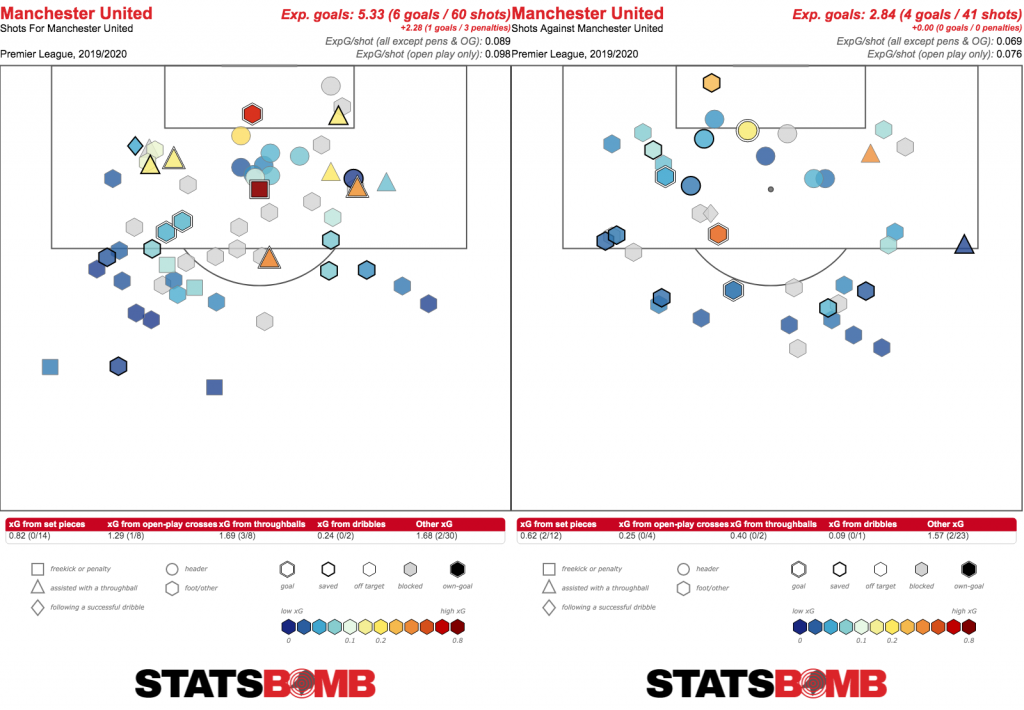 Since we’re only four games into the season, making definitive claims from the numbers is hard. So let’s look a little closer at each of these fixtures and see what actually happened here.
Since we’re only four games into the season, making definitive claims from the numbers is hard. So let’s look a little closer at each of these fixtures and see what actually happened here.
One Game at a Time
Game one was the actual win, a very pleasing 4-0 scoreline against Chelsea. 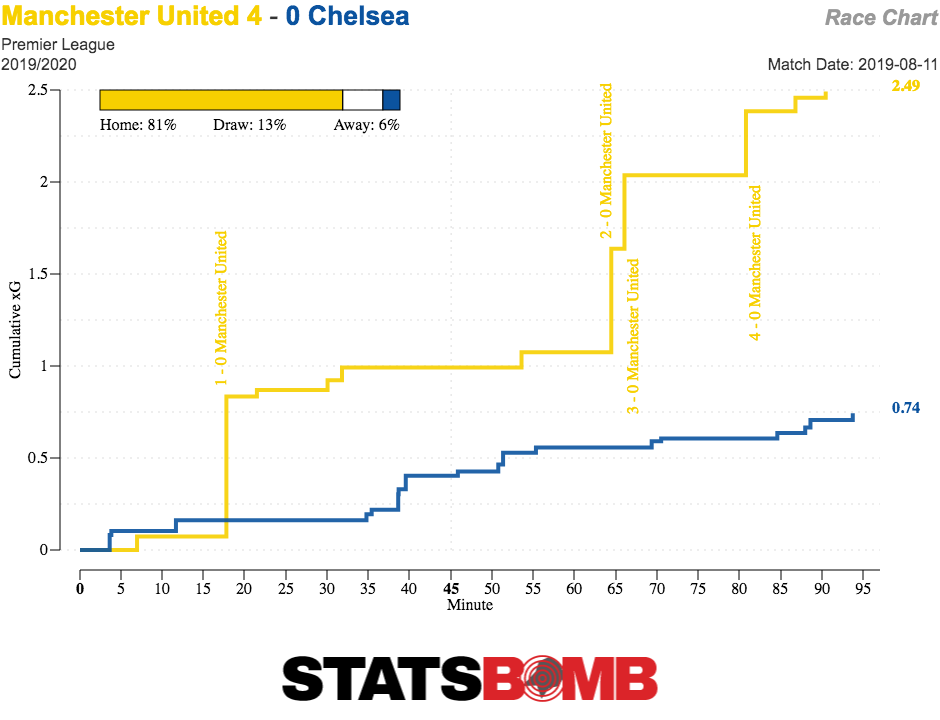 It’s worth mentioning here that United were only a penalty better than Chelsea in the first half. Including penalties in xG models is always questionable, and if predicting future performance is what you’re aiming to do, the prevailing consensus is generally to exclude them. That way, you’re left with four shots in 45 minutes, none of them decent chances.
It’s worth mentioning here that United were only a penalty better than Chelsea in the first half. Including penalties in xG models is always questionable, and if predicting future performance is what you’re aiming to do, the prevailing consensus is generally to exclude them. That way, you’re left with four shots in 45 minutes, none of them decent chances. 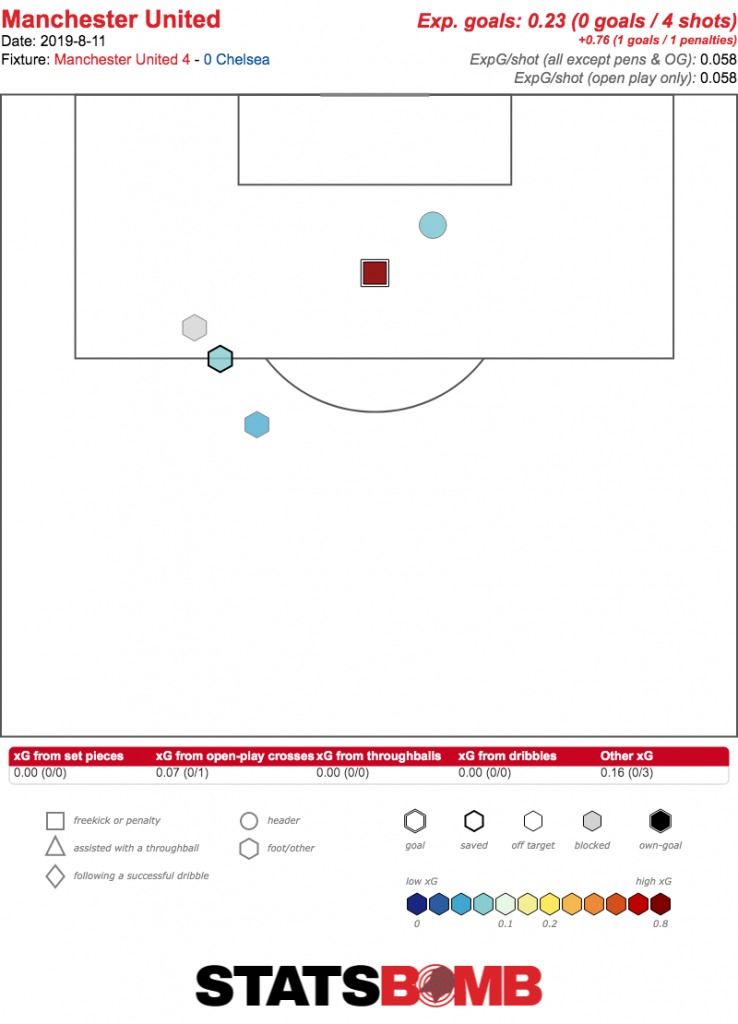 But ahead they were, and it allowed them to play on the break in the second half. With Chelsea’s poor defensive organisation, United created three very good chances on the counter, and scored them all.
But ahead they were, and it allowed them to play on the break in the second half. With Chelsea’s poor defensive organisation, United created three very good chances on the counter, and scored them all. 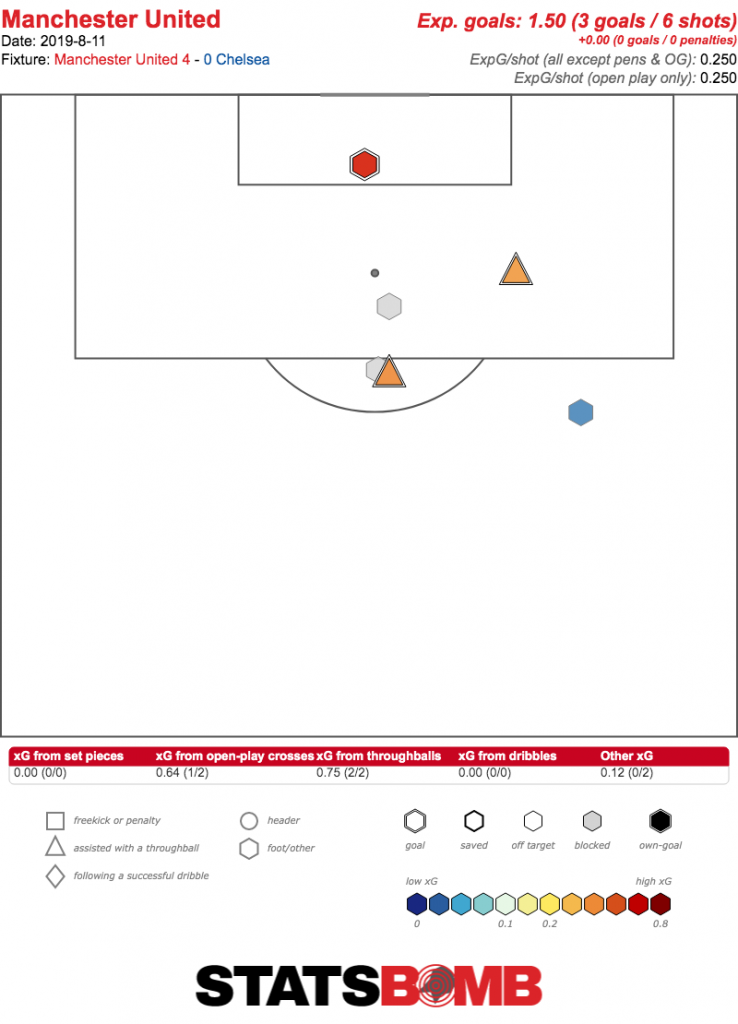 Onto the game at Wolves and where the supposed troubles started. The home side, as they often do, played very conservatively and looked to create on the counter, but it’s a credit to United that they really struggled with this, producing just five shots of which none were more than half-chances.
Onto the game at Wolves and where the supposed troubles started. The home side, as they often do, played very conservatively and looked to create on the counter, but it’s a credit to United that they really struggled with this, producing just five shots of which none were more than half-chances. 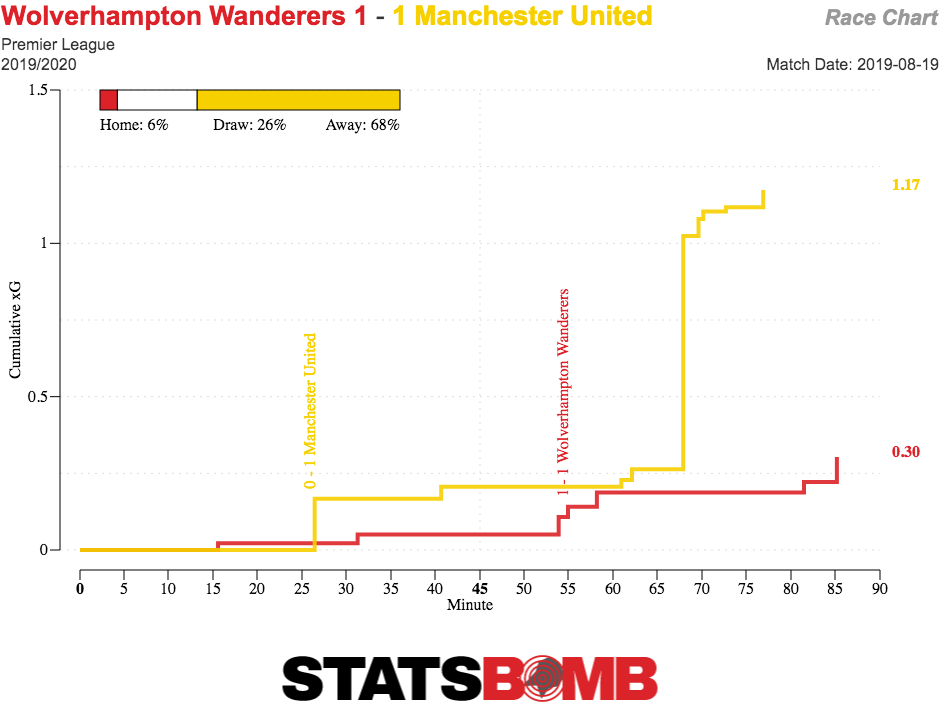 In his Premier League career so far, Ruben Neves has taken 67 shots that were not penalties or direct free kicks. All were from outside the box. Exactly one of them went in the goal, and it came in this match. It’s hard not to chalk that up to a case of shit happens. Solskjaer’s side shut down Wolves’ counter attacks, but seemed pretty toothless in creating chances themselves. The very mobile front four of Daniel James, Jesse Lingard, Marcus Rashford and Anthony Martial didn’t seem to have any way of breaking down a deep defence, and registered just 8 shots outside of the now infamous missed penalty, and 0.41 expected goals. The passmap sums up United’s issues: lots of dominance and interplay with the back four and midfielders, but a struggle to get the attackers involved in dangerous areas.
In his Premier League career so far, Ruben Neves has taken 67 shots that were not penalties or direct free kicks. All were from outside the box. Exactly one of them went in the goal, and it came in this match. It’s hard not to chalk that up to a case of shit happens. Solskjaer’s side shut down Wolves’ counter attacks, but seemed pretty toothless in creating chances themselves. The very mobile front four of Daniel James, Jesse Lingard, Marcus Rashford and Anthony Martial didn’t seem to have any way of breaking down a deep defence, and registered just 8 shots outside of the now infamous missed penalty, and 0.41 expected goals. The passmap sums up United’s issues: lots of dominance and interplay with the back four and midfielders, but a struggle to get the attackers involved in dangerous areas. 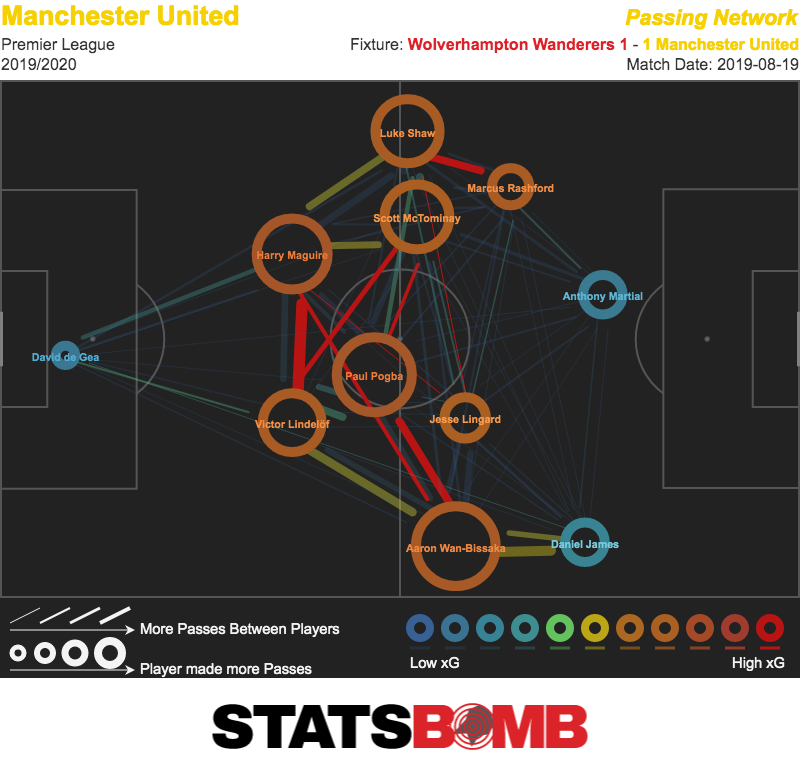 Crystal Palace also defended deep in the following game at Old Trafford, but United had at least a better go at breaking them down. They put up plenty of shots both before and after Jordan Ayew scored the game’s first goal. But, just as Roy Hodgson likely planned it, Palace’s deep block ensured that the chances were of poor quality, mostly being headers or shots with plenty of bodies in the way. Again, if United score the penalty they probably win the game, but you have to squint a bit to argue this was a good attacking performance. At the other end, Palace scored two goals from five shots and 0.89 xG, which doesn’t feel like too much of a serious concern for Solskjaer.
Crystal Palace also defended deep in the following game at Old Trafford, but United had at least a better go at breaking them down. They put up plenty of shots both before and after Jordan Ayew scored the game’s first goal. But, just as Roy Hodgson likely planned it, Palace’s deep block ensured that the chances were of poor quality, mostly being headers or shots with plenty of bodies in the way. Again, if United score the penalty they probably win the game, but you have to squint a bit to argue this was a good attacking performance. At the other end, Palace scored two goals from five shots and 0.89 xG, which doesn’t feel like too much of a serious concern for Solskjaer. 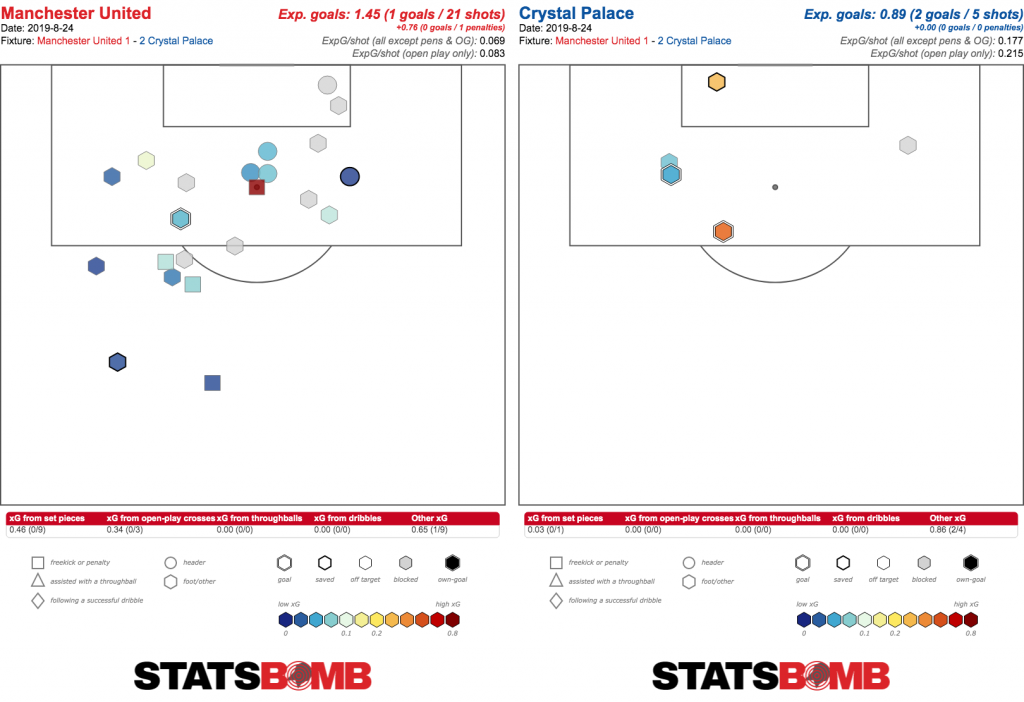 Southampton away was another fixture where United “deserved” to win on xG, but there were still real concerns to be had.
Southampton away was another fixture where United “deserved” to win on xG, but there were still real concerns to be had. 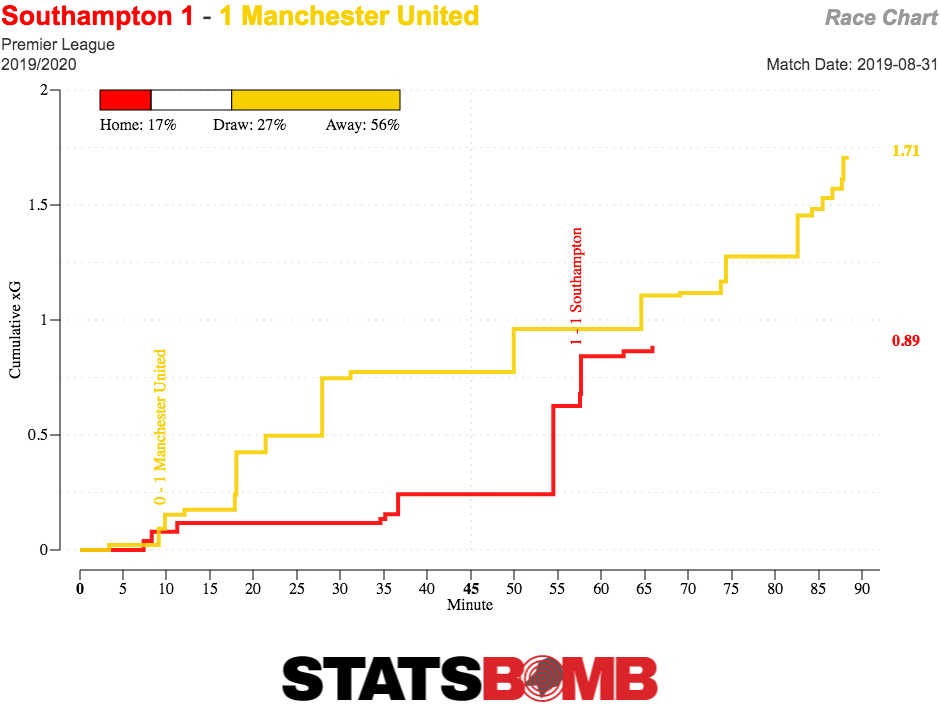 They again recorded plenty of shots, and again struggled in terms of the quality of those chances. Southampton defend in a slightly different way to Wolves and Palace, but the effect was the same. This was a better attacking performance than in those games, but also one in which they were facing ten men for the closing stages. If United can’t create high xG shots then, when will they?
They again recorded plenty of shots, and again struggled in terms of the quality of those chances. Southampton defend in a slightly different way to Wolves and Palace, but the effect was the same. This was a better attacking performance than in those games, but also one in which they were facing ten men for the closing stages. If United can’t create high xG shots then, when will they? 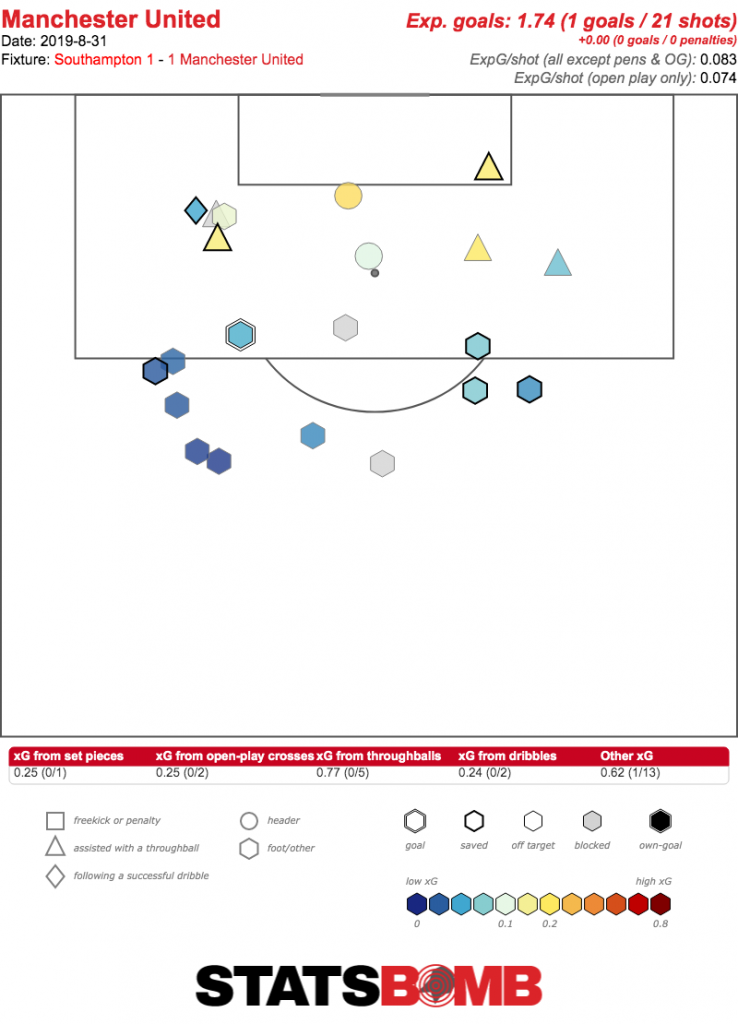
The Bigger Picture
Expected goals says that Man United have been excellent at preventing the opposition from creating chances. At the other end, there’s an unusually large difference in whether the model includes penalties or not. It’s unusual to miss two of three penalties, but it’s also unusual to win three penalties in four games. Otherwise, xG says that United have been fairly middling at creating good chances so far. That the defence has been legitimately excellent does come as something of a surprise. And it’s not just xG that says so. Solskjaer’s team are restricting opposing sides to just three passes in United’s box, the second fewest in the league. Teams have found it very difficult simply to work the ball into dangerous areas. 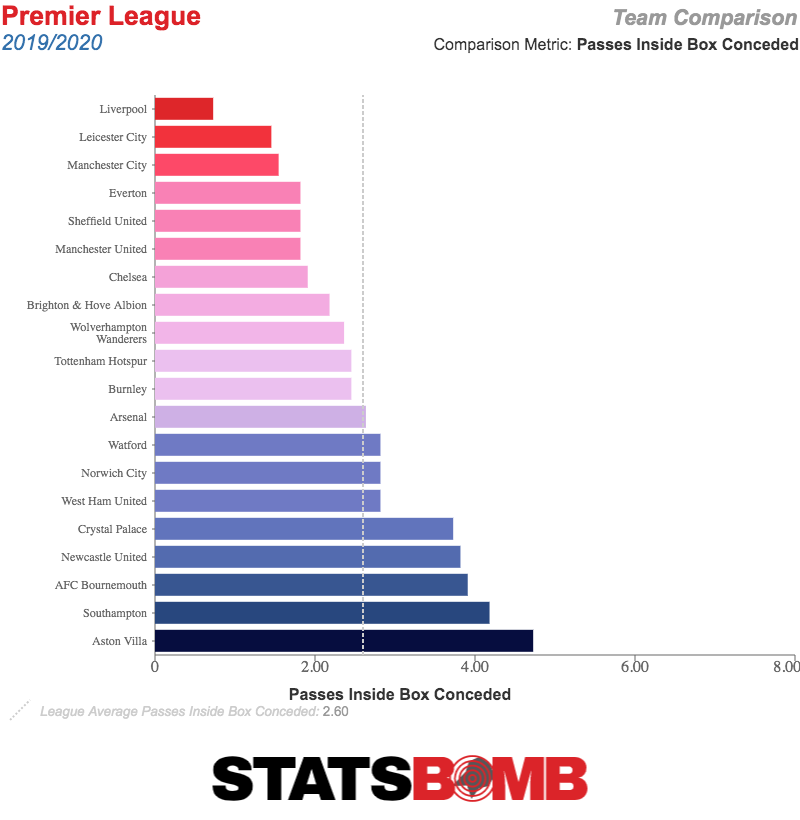 Should this be a surprise? The club did, after all, spend huge sums on Harry Maguire and Aaron Wan-Bissaka to upgrade the back line. If these players are worth the money, they presumably should be having a noticeable effect on United’s defensive numbers. Judging centre backs statistically is an extremely difficult thing to do, so we’re not going to even attempt that here. What we can say is that he’s been unsurprisingly dominant with his head, amassing the most aerial wins of any player in the so called top six so far this season. It looks good, but again, don’t read too much into numbers for a centre back.
Should this be a surprise? The club did, after all, spend huge sums on Harry Maguire and Aaron Wan-Bissaka to upgrade the back line. If these players are worth the money, they presumably should be having a noticeable effect on United’s defensive numbers. Judging centre backs statistically is an extremely difficult thing to do, so we’re not going to even attempt that here. What we can say is that he’s been unsurprisingly dominant with his head, amassing the most aerial wins of any player in the so called top six so far this season. It looks good, but again, don’t read too much into numbers for a centre back. 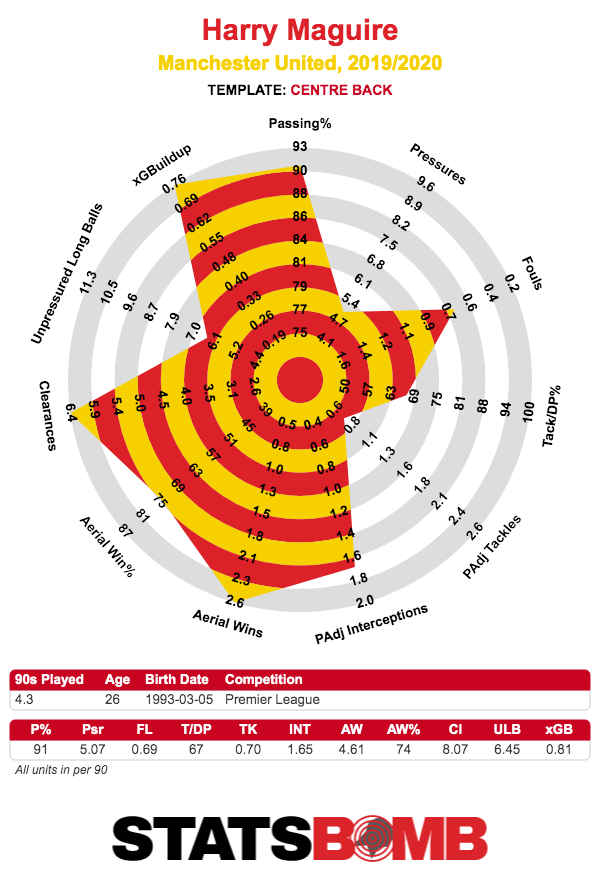 As for Wan-Bissaka, he’s won plaudits for his volume of tackles so far, but that’s not the real story. Defending is not about what you do, but what you stop your opponent from doing. Palace fans had a delightful song about Wan-Bissaka to the tune of “Rock the Casbah” with the line “your wingers don’t like him”, and that sums up what his game is about perfectly. At his best, he doesn’t let players he’s directly up against get past him. Can we find evidence for this in the numbers? Well here’s what there is. When looking at failed attempts to dribble or carry the ball against United this season when under pressure, there’s a pattern. Teams seem to be getting stopped particularly frequently down Wan-Bissaka’s side. Of course, Wan-Bissaka now finds himself injured, so it’s possible that teams will begin to find more joy down this flank.
As for Wan-Bissaka, he’s won plaudits for his volume of tackles so far, but that’s not the real story. Defending is not about what you do, but what you stop your opponent from doing. Palace fans had a delightful song about Wan-Bissaka to the tune of “Rock the Casbah” with the line “your wingers don’t like him”, and that sums up what his game is about perfectly. At his best, he doesn’t let players he’s directly up against get past him. Can we find evidence for this in the numbers? Well here’s what there is. When looking at failed attempts to dribble or carry the ball against United this season when under pressure, there’s a pattern. Teams seem to be getting stopped particularly frequently down Wan-Bissaka’s side. Of course, Wan-Bissaka now finds himself injured, so it’s possible that teams will begin to find more joy down this flank. 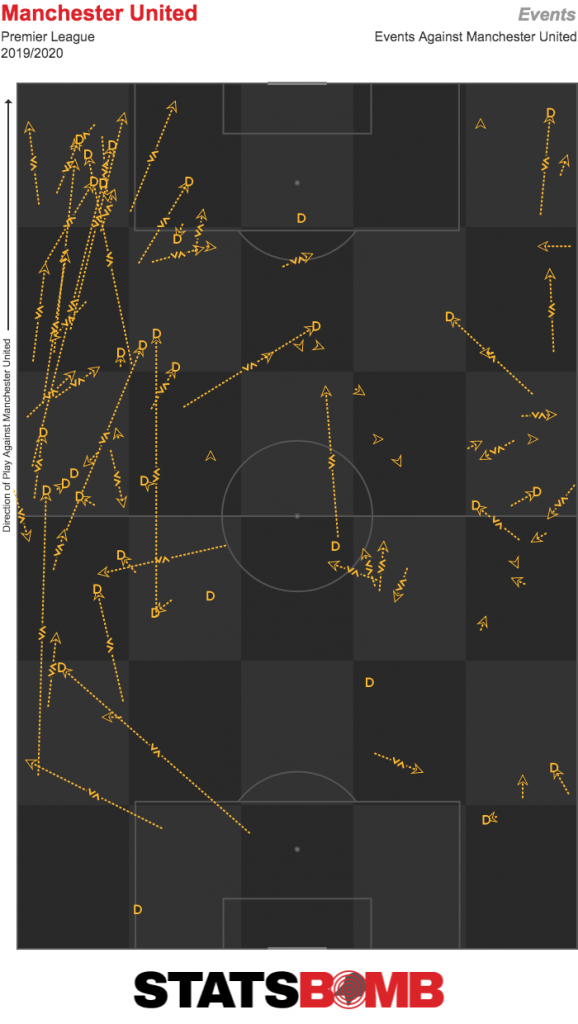 In front of that back four is where it was thought that United would be flimsy, but not so far. Scott McTominay as the side’s primary ball winning midfielder seemed like a strange idea since he’d previously shown little aptitude for winning the ball. Now, it remains very early, and we’re talking about 10 tackles and 6 interceptions here, hardly a sample size worthy of huge extrapolation. But this is a promising start for him in a new role, as he’ll certainly need to keep it up if United are to hold this midfield together.
In front of that back four is where it was thought that United would be flimsy, but not so far. Scott McTominay as the side’s primary ball winning midfielder seemed like a strange idea since he’d previously shown little aptitude for winning the ball. Now, it remains very early, and we’re talking about 10 tackles and 6 interceptions here, hardly a sample size worthy of huge extrapolation. But this is a promising start for him in a new role, as he’ll certainly need to keep it up if United are to hold this midfield together. 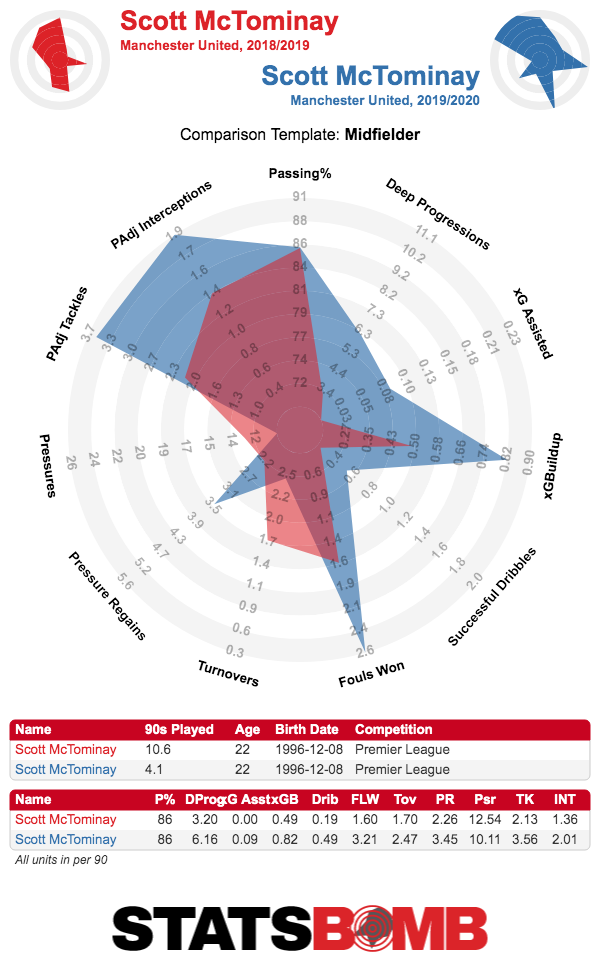 The obvious area with less positive news, though, is in goal. When people put out their Premier League teams of the decade this December, it seems very likely that most will feature De Gea between the posts. There have been times when the Spaniard has seemed to single-handedly keep United afloat while everything around him was collapsing. But from the 2018 World Cup onwards, De Gea has seemed positively mortal. In the time since Solskjaer took the reins at Old Trafford, StatsBomb’s shot stopping model has had De Gea as almost exactly league average, after having previous periods of astonishing numbers. The early stages of this season have been notably worse than that, with De Gea already estimated to have cost United a goal more than the average ‘keeper. My instincts throughout this disappointing period have been to back the player who previously looked so good to turn it around, to expect that he’ll shake it off sooner rather than later. But these issues have been going on long enough that clearly something is up with him. Expected goals is an invaluable metric in understanding football and its increasing media prominence is undoubtedly a positive. In past years, United’s results would have told the whole story and everyone would have agreed that the club was in crisis. We can now see that the scorelines do not tell the whole story and there are positives to take from the four games so far, with the team having avoided conceding much in the way of real chances. But it’s important to understand what the numbers do and do not tell us. This team has not been attacking especially well, and three penalties clouds things somewhat. Perhaps if opposing players did not foul United in the box, those three moments would have led to some excellent opportunities that would boost the attacking xG. We will never know. What we also have to note is that this is just four games, and the approaches of the opposition sides has had a significant impact on these numbers. With the exception of the first half against Chelsea, United have not been facing opponents continually trying to force the issue and really push this team. The pattern of play for the most part has been of teams soaking up pressure and looking to counter. That they have struggled to counter effectively is something United should get credit for, yes, but we will have to wait and see if this defence holds up to being tested in other ways. On the attacking side, there are real questions to be answered. United have played better football than the results would suggest, yes. But that does not mean that there are not concerns, or that the performances will continue to look so positive in terms of xG. Header image courtesy of the Press Association
The obvious area with less positive news, though, is in goal. When people put out their Premier League teams of the decade this December, it seems very likely that most will feature De Gea between the posts. There have been times when the Spaniard has seemed to single-handedly keep United afloat while everything around him was collapsing. But from the 2018 World Cup onwards, De Gea has seemed positively mortal. In the time since Solskjaer took the reins at Old Trafford, StatsBomb’s shot stopping model has had De Gea as almost exactly league average, after having previous periods of astonishing numbers. The early stages of this season have been notably worse than that, with De Gea already estimated to have cost United a goal more than the average ‘keeper. My instincts throughout this disappointing period have been to back the player who previously looked so good to turn it around, to expect that he’ll shake it off sooner rather than later. But these issues have been going on long enough that clearly something is up with him. Expected goals is an invaluable metric in understanding football and its increasing media prominence is undoubtedly a positive. In past years, United’s results would have told the whole story and everyone would have agreed that the club was in crisis. We can now see that the scorelines do not tell the whole story and there are positives to take from the four games so far, with the team having avoided conceding much in the way of real chances. But it’s important to understand what the numbers do and do not tell us. This team has not been attacking especially well, and three penalties clouds things somewhat. Perhaps if opposing players did not foul United in the box, those three moments would have led to some excellent opportunities that would boost the attacking xG. We will never know. What we also have to note is that this is just four games, and the approaches of the opposition sides has had a significant impact on these numbers. With the exception of the first half against Chelsea, United have not been facing opponents continually trying to force the issue and really push this team. The pattern of play for the most part has been of teams soaking up pressure and looking to counter. That they have struggled to counter effectively is something United should get credit for, yes, but we will have to wait and see if this defence holds up to being tested in other ways. On the attacking side, there are real questions to be answered. United have played better football than the results would suggest, yes. But that does not mean that there are not concerns, or that the performances will continue to look so positive in terms of xG. Header image courtesy of the Press Association
This week I was lucky enough to present a comprehensive analysis of the Danish Superliga to an audience of 300 coaches, analysts, and administrators in Danish Football. The report was commissioned to not only analyse how the league has changed over the last five seasons, but also to benchmark it against the German Bundesliga and English Premier League. Our analyst Euan Dewar did a great job on the analysis and preparing the report, and it was fun to once again be in a packed room of football people, discussing data analysis. My understanding is that the entire report will be made available to the public at some point in the future.
StatsBomb do this type of analysis for clubs, federations, and governing bodies fairly regularly, and it’s a huge compliment to be trusted to produce honest, insightful analysis about the game.
One thing that was absolutely clear in the report was that Danish teams remain innovators in one specific area: set pieces. Danish teams score consistently more goals from set pieces than pretty much every other league in the world, including ones with considerably more money and more talent. (For more analysis on this, check out my earlier piece I Think We Broke Denmark.)
Let me also make something else clear - more goals are not being scored off set pieces because the defenses are bad at defending this phase of the game. More goals are being scored because a number of Danish teams are simply better at executing them. And they are better at executing because they do things differently.
What are the differences? First of all, they shoot more often off direct free kicks.
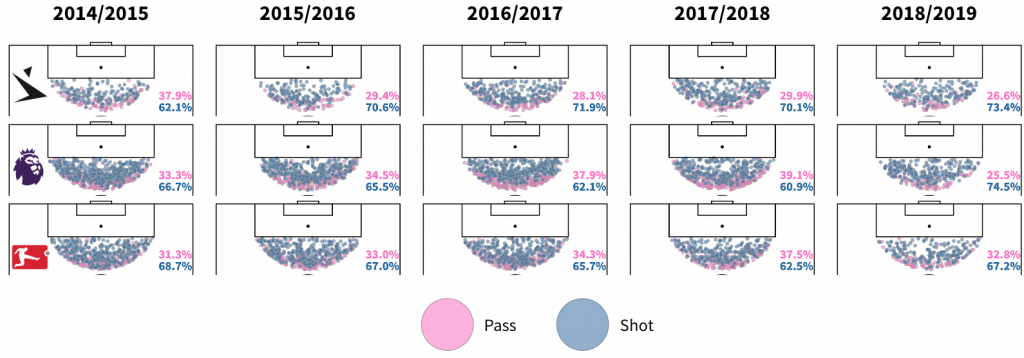
This might seem a basic point - OH GEEZ TAEK MORE SHOTS, SCORE MOAR GOALS RAAAAR - but they also score a higher percentage of those shots. Danish teams convert 8% of their DFKs compared to 6% in the Premier League, and 5.7% in the Bundesliga. That’s a significant gap, and one that seems to suggest there is a lot of slack in execution for teams in the bigger leagues.
Alright, what else?
Danish teams also target and succeed at exploiting different spaces off corners. If you know the better positions of maximum opportunity and are able to deliver balls to those areas, you can score more goals off what is traditionally a low-return phase of the game. (Teams score off corners between 2 and 2.5% across the full data set. We have seen certain teams double or treble that for multiple seasons.)
And…?
Well, remember how Andy Gray mocked Liverpool hiring a long throw coach?
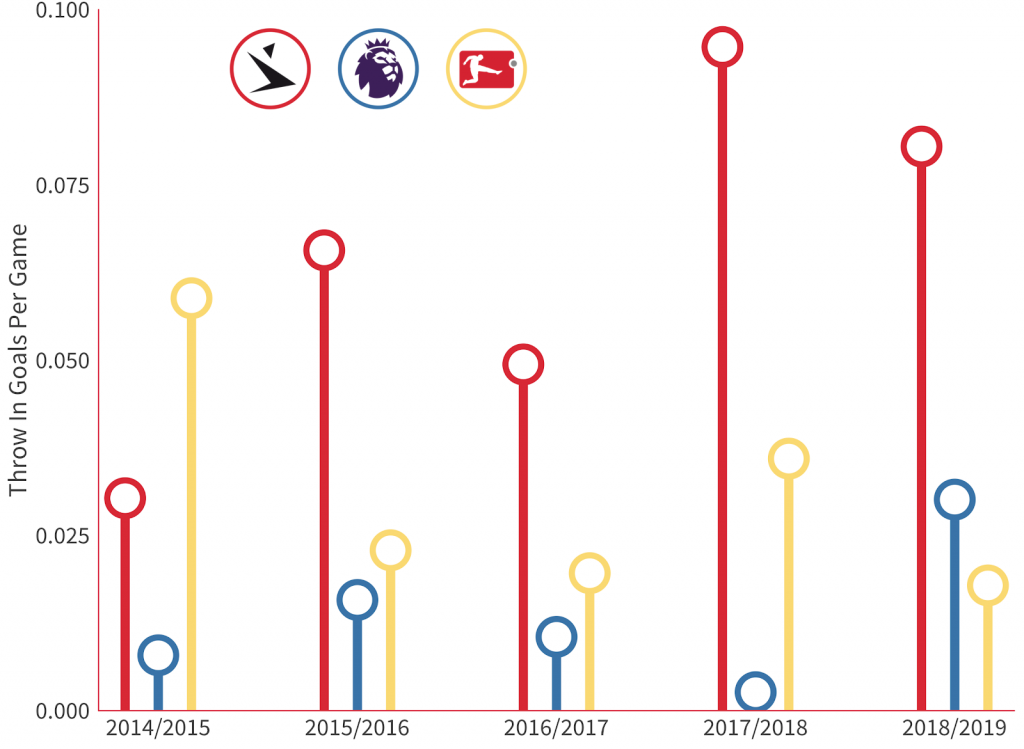
Look ma, nearly free goals! (Approximate value in the Premier League, £2.5M each.)
Only possible in Denmark? Nope:
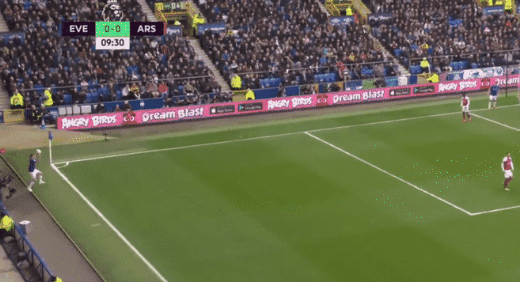
Find the edges, then exploit them. One team in Liverpool is suddenly scoring a bunch of goals from long throws. The other one hired our favourite long throw coach--Thomas Gronnemark.
Set piece execution is one main reasons Liverpool are having their greatest ever Premier League season. We have Liverpool scoring 17 goals so far in the league and conceding 6 for a goal difference of +11 in this phase of the game. Manchester City are +2 (9 scored, 7 conceded). Without that gap, the goal difference between the two contenders would go from a gap of 8 to 19, and there would likely be no title race.
The same is true further down the table as well. Given how tight the Top 4 race is right now, it’s entirely possible a difference of a few goals off this phase of the game could swing Champions League qualification for next season. When qualification is an automatic passport to tens of millions, and the least an English club will receive this season is a minimum of £86m, any edge to traverse the gap or maintain participation is worth every penny of outlay. We’ll take some time to revisit this once the season ends.
A couple of notes before I wrap this up...
Set Piece Program
We are taking applications from professional teams that want to work with us on set pieces for next season. We only work with a couple of teams on this max every season, and are exclusive to one team per league. If you work for a professional team with significant budget (bringing you goals does not come cheap), please send me an email to ted@statsbomb.com. We will choose who we work with by the end of May, so if your team wants to be in the mix, now is the time.
Set Piece Courses
For everyone else, we have tickets available for three set piece courses in June in New York, London, and Los Angeles. The courses will be taught by me, and cover both process and execution of set pieces from a coaching and analysis perspective.
To my knowledge, no one else in the world teaches a course like this, and certainly no one who works with professional teams. I made the decision to teach this information to interested parties quite simply because I feel the game is ready to change, but needed more talented people with education to carry it out. Part of my commitment to StatsBomb and its audience has been to teach people more about the game and how it operates instead of hoarding the info, and this once again falls squarely under that umbrella.
Links to buy tickets can be found here:
I hope to see a lot of you this summer.
Ted Knutson
CEO, StatsBomb
ted@statsbomb.com
Header Image Courtesy of the Press Association
While you were paying attention to things that mattered like who won matches and who lost, some under the radar storylines are bubbling along that might eventually impact teams in important ways.
Can Gabriel Jesus Score?
This seems like the most absurd question in the world. He’s averaging 0.49 non-penalty goals per 90 minutes, so clear he can score. That’s a pretty good, if not absolutely spectacular number. For player that have played over 1000 minutes in Europe’s big five leagues this season, he’s narrowly in the top 50. That’s…fine. It’s probably even good enough to be the back up on perhaps the best team in Europe. It’s also significantly behind the man he backs up, Sergio Aguero who clocks in at 0.71 non-penalty goals per 90.
Expected goals, on the other hand, tells a much much rosier story. Jesus’s xG per 90 is at a whopping 0.70, that’s the fourth best total across Europe’s big five leagues, and a whisker ahead of Aguero’s 0.69. Jesus is also just 22 years old. Aguero is, of course, now on the wrong side of the 30. So, if the only thing that matters is xG then expect Jesus to be inheriting the reins of the attack any year now.
There are of course, mitigating factors here. Jesus is generally a substitute and generally plays against weaker opposition than the first choice forward, so his numbers probably get a bit of a boost. Everybody on that City machine reinforces everybody else, a training dummy parked at the penalty spot could probably put up a positive xG total. It’s nice to be the tip of a spear wielded by the likes of David Silva and Raheem Sterling. But still, there’s no denying that Jesus’s underlying numbers are excellent.
But, boy does that kid miss a lot.
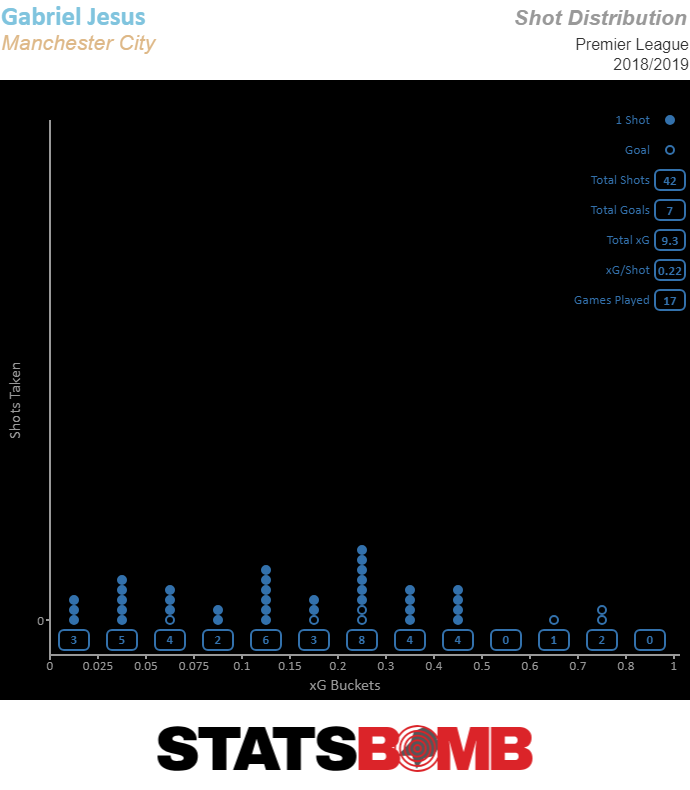
Does it matter? From an analytics perspective it does not, the best bet is to play the kid, let him shoot through the yips and expect, as the numbers suggest, that he’s about to be a superstar. But, part of the reality of leading the line at the very top of the game is that if you haven’t proven you can do it, you don’t get a lot of time to prove you can do it. People (and coaches) remember the misses, the pressure mounts, fans get restless and eventually you become Alvaro Morata (who to be fair has never had xG like Jesus’s, but who has also, to be fair, never gotten to play striker on a team quite like City), and everybody just kind of agrees that while the numbers are fine, maybe it’s time for a change of scenery.
For now, Jesus has the luxury of being a backup, but if he does eventually get the job then he’s not going to have the luxury of all these whiffs going basically unnoticed.
Eintracht Frankfurt’s Other Star Forwards
Luka Jovic gets the most attention, and well he should. He’s averaging 0.56 xG per 90, the 11th best total across Europe’s top five leagues, and it doesn’t hurt the old hype-o-meter that his actual goal scoring rate of 0.73 non-penalty goals per 90 is ahead of that pace. But, it’s not happening in a vacuum and the team’s other two main attackers, Sébastien Haller and Ante Rebić are right there with him with 0.40 and 0.42 xG per 90 and 0.48 and 0.52 non-penalty goals respectively.
While Jovic does a little bit of everything his teammates have slightly more defined roles. Haller as the more traditional forward gets the bulk of his shots from point blank range. He’s ruthlessly disciplined and almost always fires from 12 yards or closer.
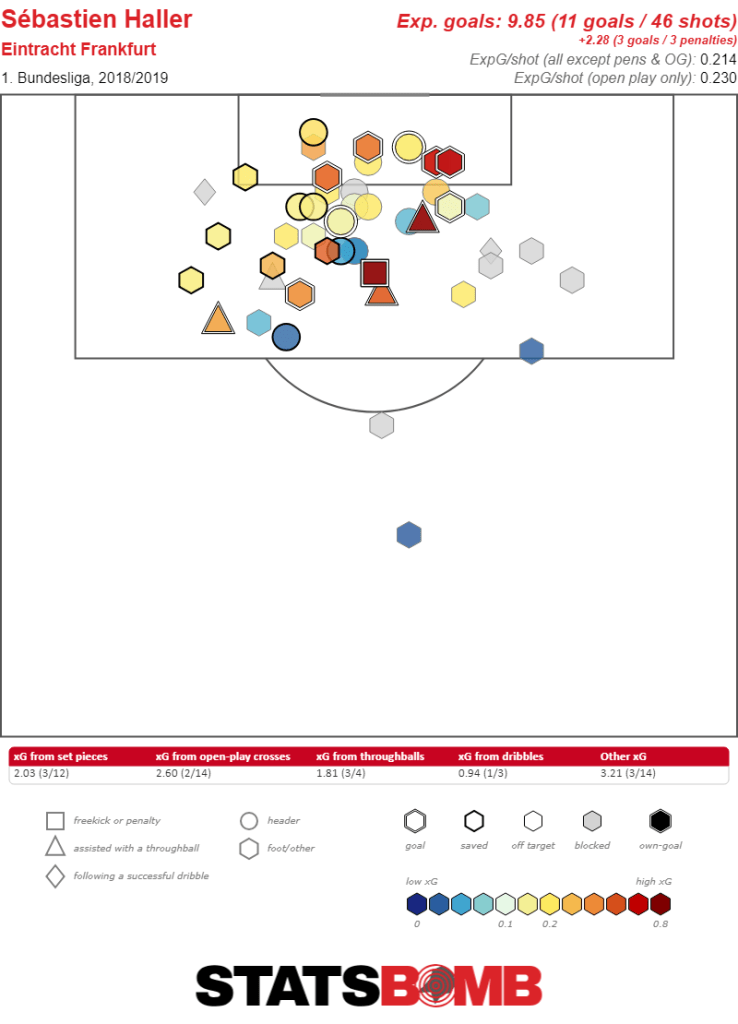
Rebić on the other hand is as often a playmaker behind the striker partnership ahead of him as he is a striker himself. Consequently his output is less about efficiency, he averages 0.14 xG per shot as opposed to Haller’s excellent 0.21, and more about volume, he takes 2.93 shots per game as opposed to Haller’s 1.93.
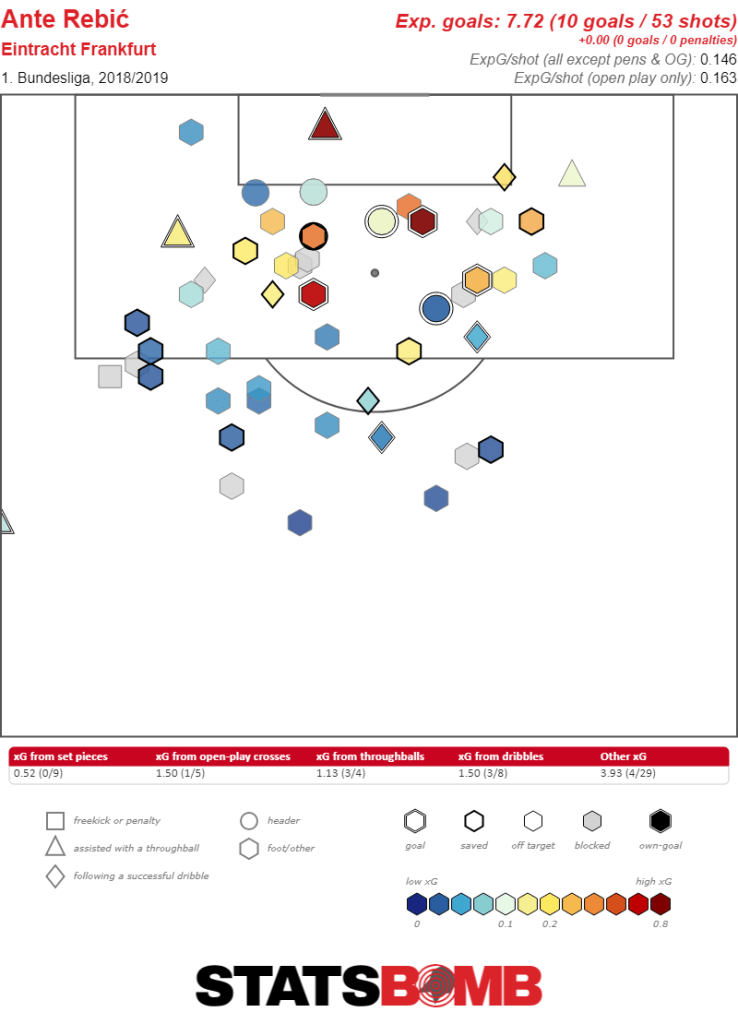
Jovic, given his age and production, has garnered much of the hype, but the story of Eintracht Frankfurt’s season is that they have three attackers all of whom are 25 or younger, all of whom are putting up strong numbers and all of whom are outperforming those numbers. Either by strong planning or dumb luck, the team has put together the perfect attacking unit, one that is young, dynamic, and perfectly complementary. It’s no wonder that in addition to currently being the only German team alive in European competitions (even if only barely) they’re also holding onto fourth place in the Bundesliga and on track to qualify for next season’s Champions League.
The Old Man of Valencia
Valencia have had a fascinating season. It’s not just that they started so slowly and are now coming on so strong, it’s that the team as currently constructed is an interesting hodgepodge of young and old.
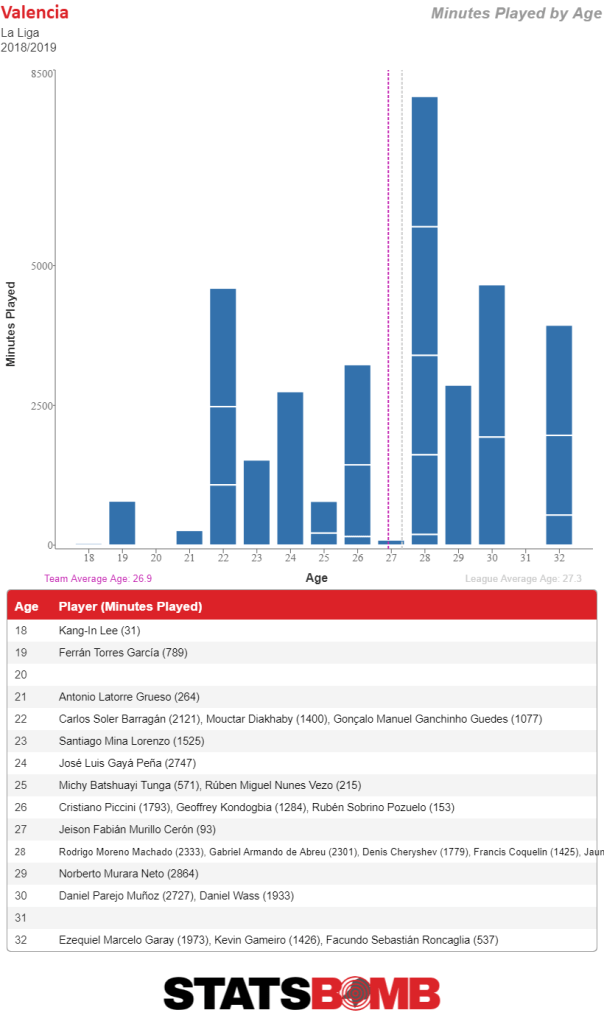
The kids, players like Carlos Soler, Gonçalo Guedes, Ferrán Torres (as well as Mouctar Diakhaby further back on the field) provide skill and hope for the future, but it’s some of the old hands who have done much to steady the uncertain ship. Specifically, Kevin Gameiro, less than a month from his 32 birthday continues to put up important numbers leading the line for Valencia.
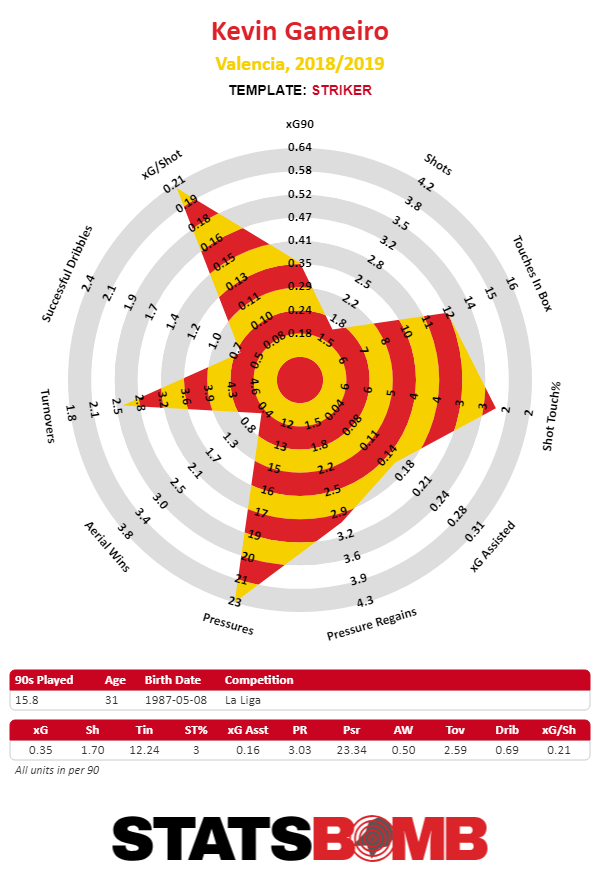
Despite his age, he’s an active defender. He’s happy to drop into Valencia's shape and harass the opposition as they attempt to enter the ball into midfield.
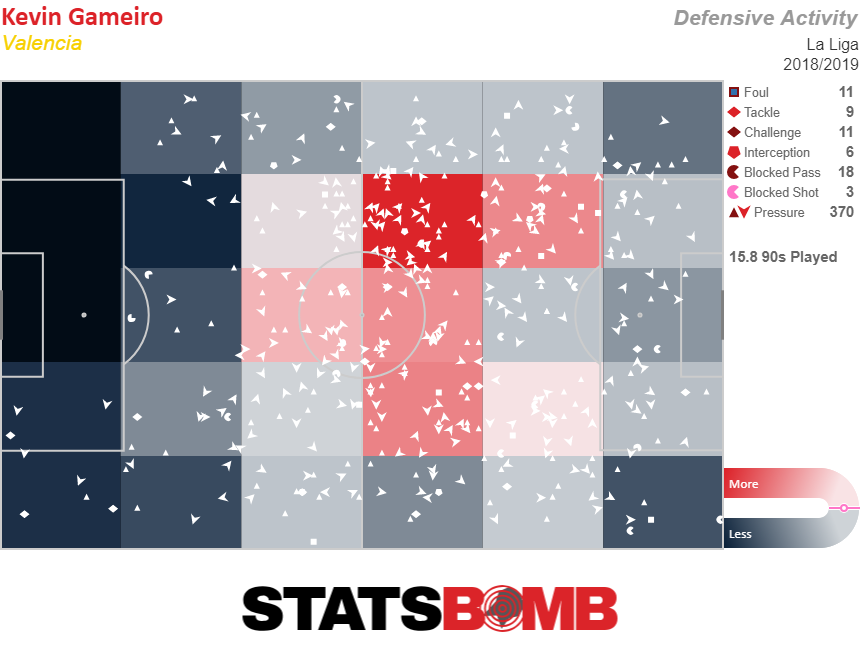
He pairs that defensive willingness with a lethal nose for goal. He only has four goals this season, though his expected goal total is somewhat higher at 5.41. But, he’s also only taken 27 total shots. He’s one of only six players across Europe’s top five leagues this season who have managed at least 0.33 xG per 90 and over 0.20 xG per shot.
Gameiro has shown to have a perfect set of skills for this Valencia side. He doesn’t need the ball a lot, which allows their younger, more exciting players to feature but he’s happy to do all sorts of dirty work from the striker position that lets them shine. Then, on the rare occasions when he does shoot, he does it from absolutely lethal positions. His game is perfectly suited to letting the kids have the spotlight, because he has enough edge to pounce when the opposition fails to take him into account. If Valencia manage to finish their remarkable second half of the season comeback, and nip fourth place at the wire, it will provide them a Champions League platform to feature their exciting prospects next season, but it will be thanks in no small part to the veterans that they got there.
StatsBomb is unveiling three new (to us) passing metrics to better profile passers in professional football. Why passing metrics? Because this is football and passing is omnipresent. For better or for worse, the ubiquitous event may need even more attention than we’re already giving it. It is our objective through these metrics to evaluate a passer’s creativity, their predictability and frankly their overall passing ability.
Thanks to some of the great work by peers made publicly available, we were able to put these together without too much time consuming innovation. We will release the metrics in a series of posts to spread out the joy and peak the eagerness for all you nerds. The first metric we are releasing today is “Pass Uniqueness”.
Pass Uniqueness Methodology
“Pass Uniqueness” is a variation on previous work (I am not claiming the novelty of this idea in the slightest, but I am expanding on it thanks to the vast amount of data over here at StatsBomb). The original methodology is available on FC RStat’s GitHub, you can even find the original code. The advantage of a uniqueness metric is to see which players make less common passes than others. Although, as the original write up notes, a less common pass is not necessarily an advantageous one. It could be completely erratic, but in and of itself it is unique. In a follow up post, we will talk about identifying advantageous passes.
The basis for these methods is largely the same as previous iterations, however we make some key extensions that require a bit different methodology. We extract the similar following variables describing each pass:
- duration
- length
- angle
- height.id (1 = Ground Pass, 2 = Low Pass, 3 = High Pass)
- body_part.id (1 = Right Foot, 2 = Left Foot, 3 = Other)
- location.x
- location.y
- end_location.x
- end_location.y
At the competition level, we then do a KNN search for the 20 most similar passes (k = 20) to each individual pass (target). Most similar is defined as the closest passes in Euclidean distance to the target pass. The “uniqueness” metric is calculated as the sum of the euclidean distances for all k = 20 passes. More formally,

There is some controversy in using Euclidean distance with categorical variables like height.id and body_part.id. However, for simplicity, we make the intentionally, naive assumption that their numeric IDs are continuous and we order them intuitively so that Ground Pass is closer to Low Pass which is closer to High Pass.
There are other metrics to better account for categorical variables and a good reference for KNN distance metrics can be found here. Since the euclidean distance is aggregated across all variables in the search, it is important that we scale all variables to have the same mean 0 and standard deviation 1. Otherwise, variables on a larger scale would unjustly carry more weight just because their individual distance metric would be larger than the other covariates.
The R package FNN makes this search very quick, a data set of 3.2 million passes takes about 2 minutes to run. To reduce dimensions and to keep the sample for each search more homogeneous, we only search for nearest neighbors inside of each league and backdating up to one season. It’s important to note a limitation here. The limitation is that with larger sample sizes there is a higher propensity for more similar passes and as a result fewer unique passes due to the lower euclidean distances. In order to make the uniqueness metric more scalable across bigger and smaller competitions, it would make sense to set k equal to a proportion of the total population within each competition.
We account for that limitation in a different way. We extend the KNN search into a model based method. Using the “uniqueness” value calculated from the KNN search in each league, we then regress the uniqueness value on the same covariates in the original search. We could do this in a simple linear regression, but one would have to properly specify the non-linear relationship between location coordinates and the uniqueness. Instead, we use a tree based method to handle the non-linearities seamlessly. Using extreme gradient boosting (xgboost), we construct trees with a maximum depth of 12 different predictor combinations training for 1000 rounds.
We then check the correlation between the actual uniqueness from the KNN search and the predicted uniqueness from the xgboost method. A scatterplot of our results is shown below:
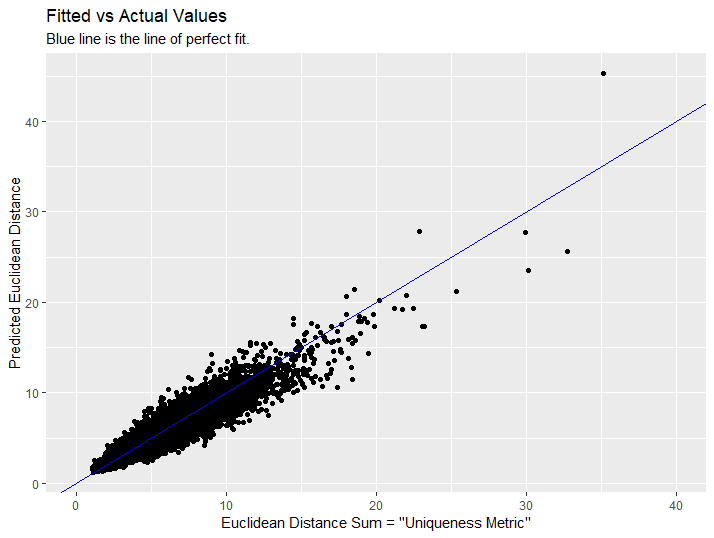
Correlation
It looks like we did pretty well! The correlation between observed uniqueness and predicted uniqueness was 0.967!
Now, why is this model based extension helpful? There are a few reasons. The first is that the original framework of the uniqueness metric requires searching an entire competition at each update. That can be computationally expensive especially if you have to update competitions 2-3 times a week. Secondly, the results are dependent on the individual competitions that they are in and therefore cannot easily extend into new competitions, especially competitions with fewer matches.
Using a model based approach allows us to quickly extend the “uniqueness” metric to new passes in new matches and competitions. The model based approach also allows us to further investigate the most important features influencing the actual “uniqueness” value.
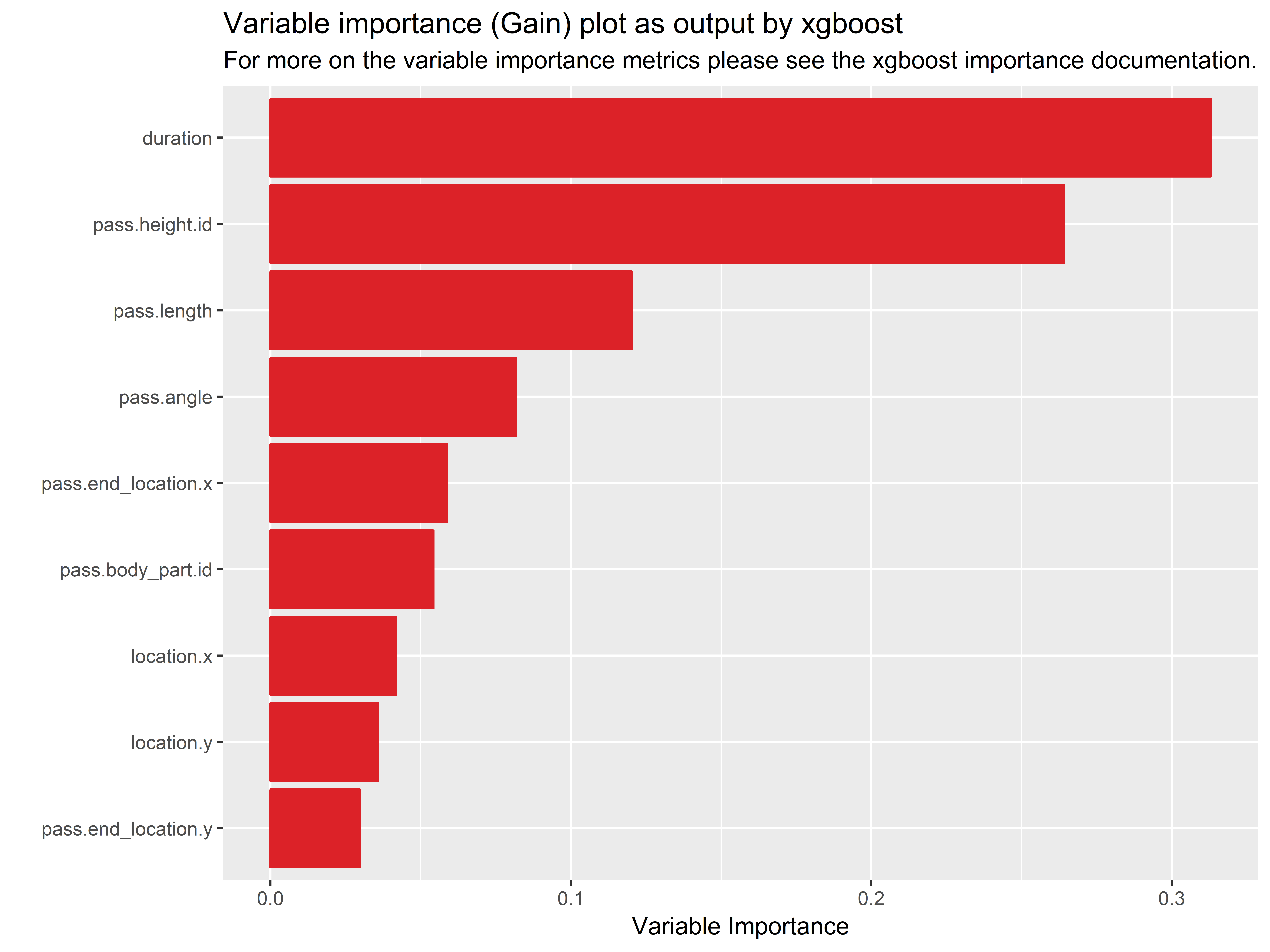
Applications
With that long winded methodology out of the way, let’s get into all the cool and intriguing applications. The uniqueness metric describes passes that are more unusual than most. It can separate extraordinary passers from the ordinary and it can be used to better grade pass difficulty, pass predictability and positive attacking contribution. Let’s first look at the distribution of pass uniqueness for different player’s positions.
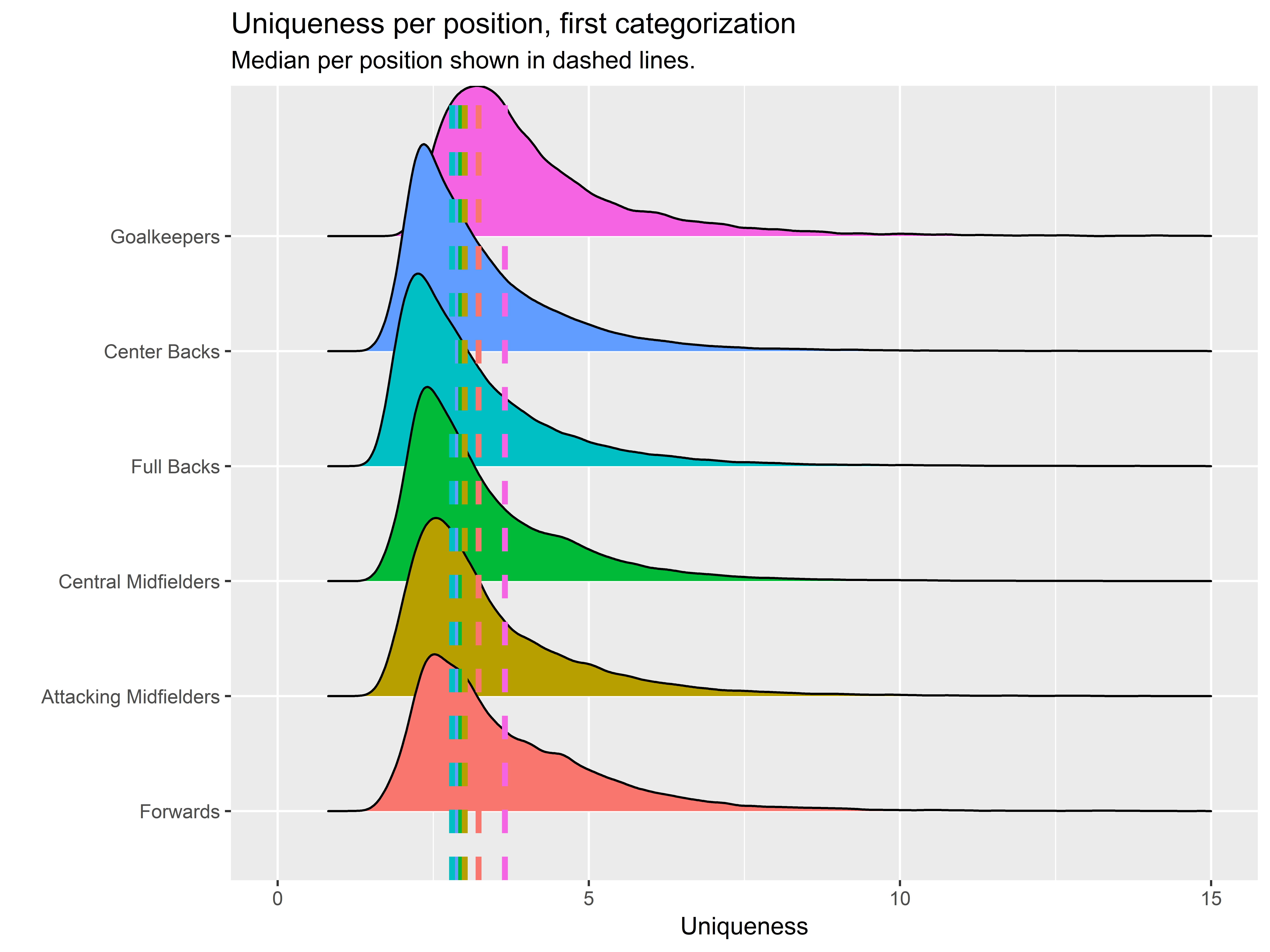
The density plot above proves a very interesting point and also highlights a potentially limiting factor of this metric. Goalkeepers are the most “unique” passers in the game! Much as I’d like to shout out my beloved and under-appreciated position, unfortunately, that just can’t be the case. If goalkeepers were the most unique passers in the game they wouldn’t be playing in net.
What we are actually seeing here is a flaw in the KNN search, because goalkeepers physically pass less frequently than their counterparts in the field, their passes have less similar matches in the KNN search and therefore garner higher “uniqueness” values despite their passes probably being insignificant. The next most unique position category are forwards. These two groups being more unique passers than others actually makes sense. They are making passes in places where the fewest passes exist, and therefore are the least common passes in the game. Recalling this potential positional bias, we will continue to make comparisons inside of position categories.
Let’s see what some “unique” passes look like for each position. Recalling the importance of the duration variable in the uniqueness value, we filter out all passes with a duration greater than 2.5 seconds; these passes are likely long balls out of the back, which for convenience we’ll lump together for now.
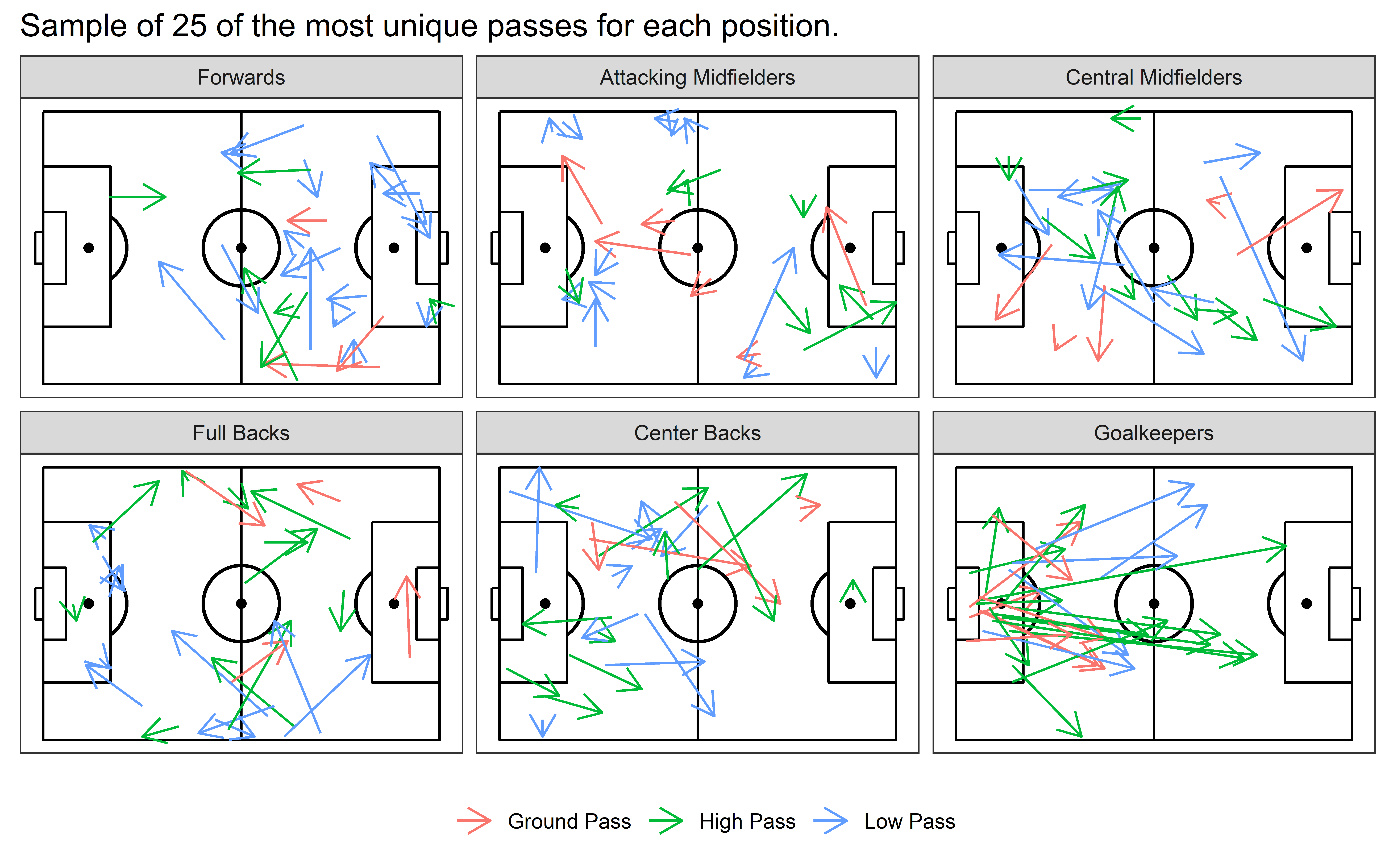
At this point, I hope the metric is starting to make sense. Our most unique passes are short passes high in the air or high passes into strange areas on tight angles, long ground passses whipping across the pitch and low driven passes on interesting angles. I’m starting to feel pretty comfortable with the effectiveness of the metric, so let’s get deeper into what this metric could do.
Everyone’s first inquiry is; who are the most unique passers? You must proceed with caution when investigating this, if we simply ranked players based on their median uniqueness or some other quantile we would make heavy passers suffer more than occasional, possibly, frantic passers. Instead, we rank passers based on the count of completed passes that were more unique than the 90th percentile of passes per 90 minutes played (this is also how players were ranked players in the original uniqueness framework).
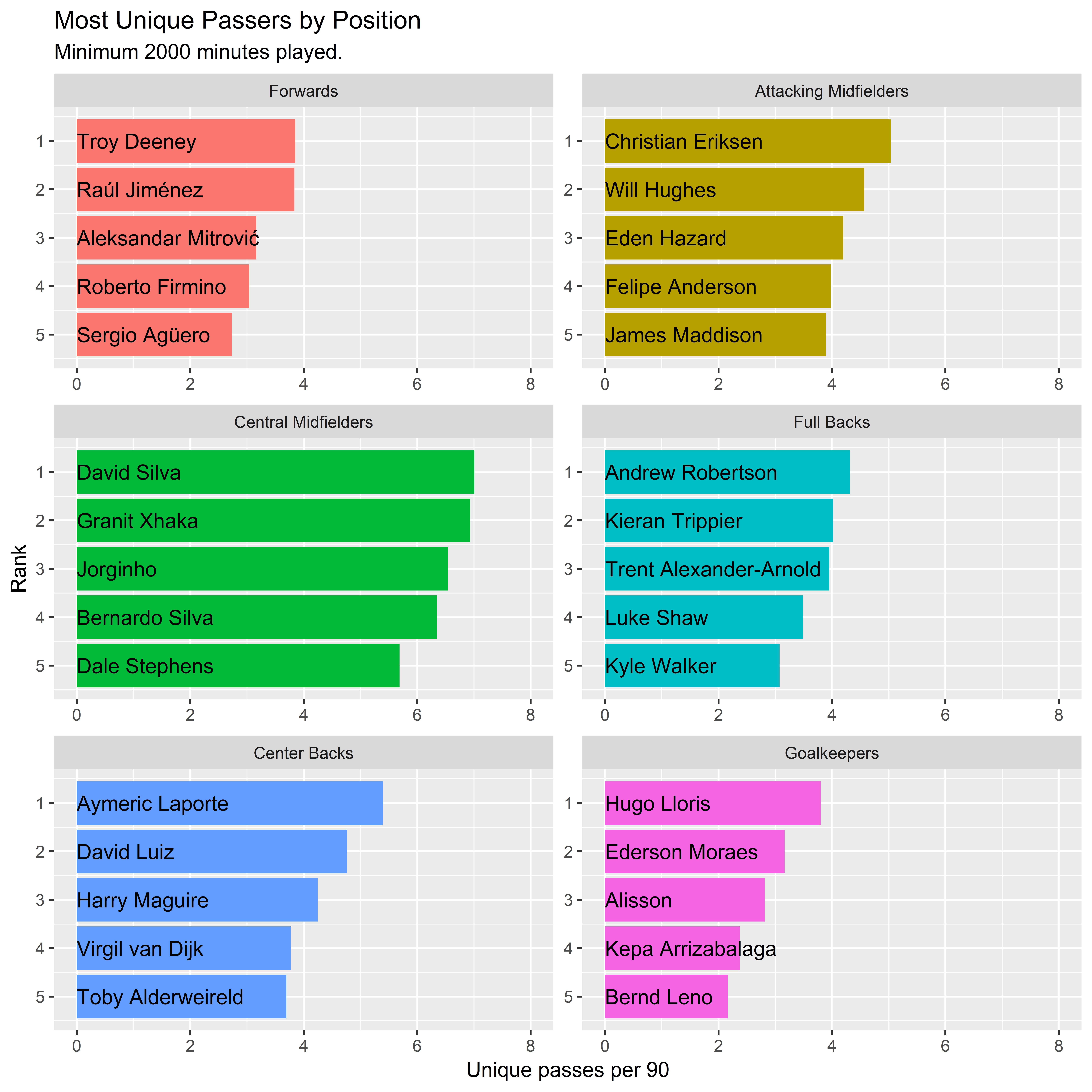
The results passed the ever-rigorous eye test from our analysis department. Although that may seem like a piece of cake to the average reader, let me assure you it is not too easy to sneak names by Euan,James and the crew. Nonetheless, we’re still left with a few questions. How are these player’s more unique? And, why does that matter? To answer the first question, we can look at an example match for our most unique passer in the EPL this season, David Silva.
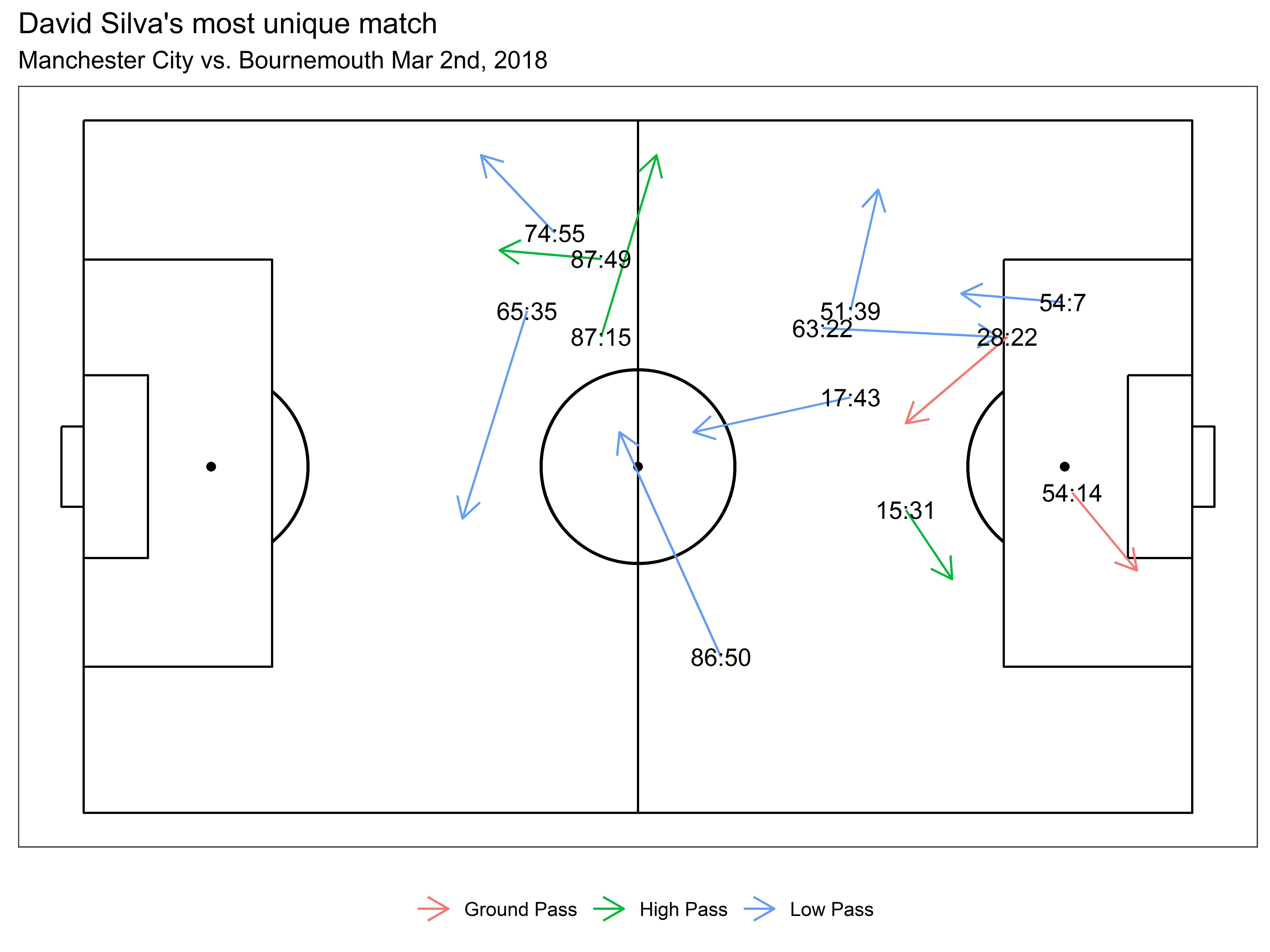
In the plot above, we match these passes to the video and see why they are so unique. As you can, see the passes aren't anybody's definition of great, but they certainly stand out as unusual.
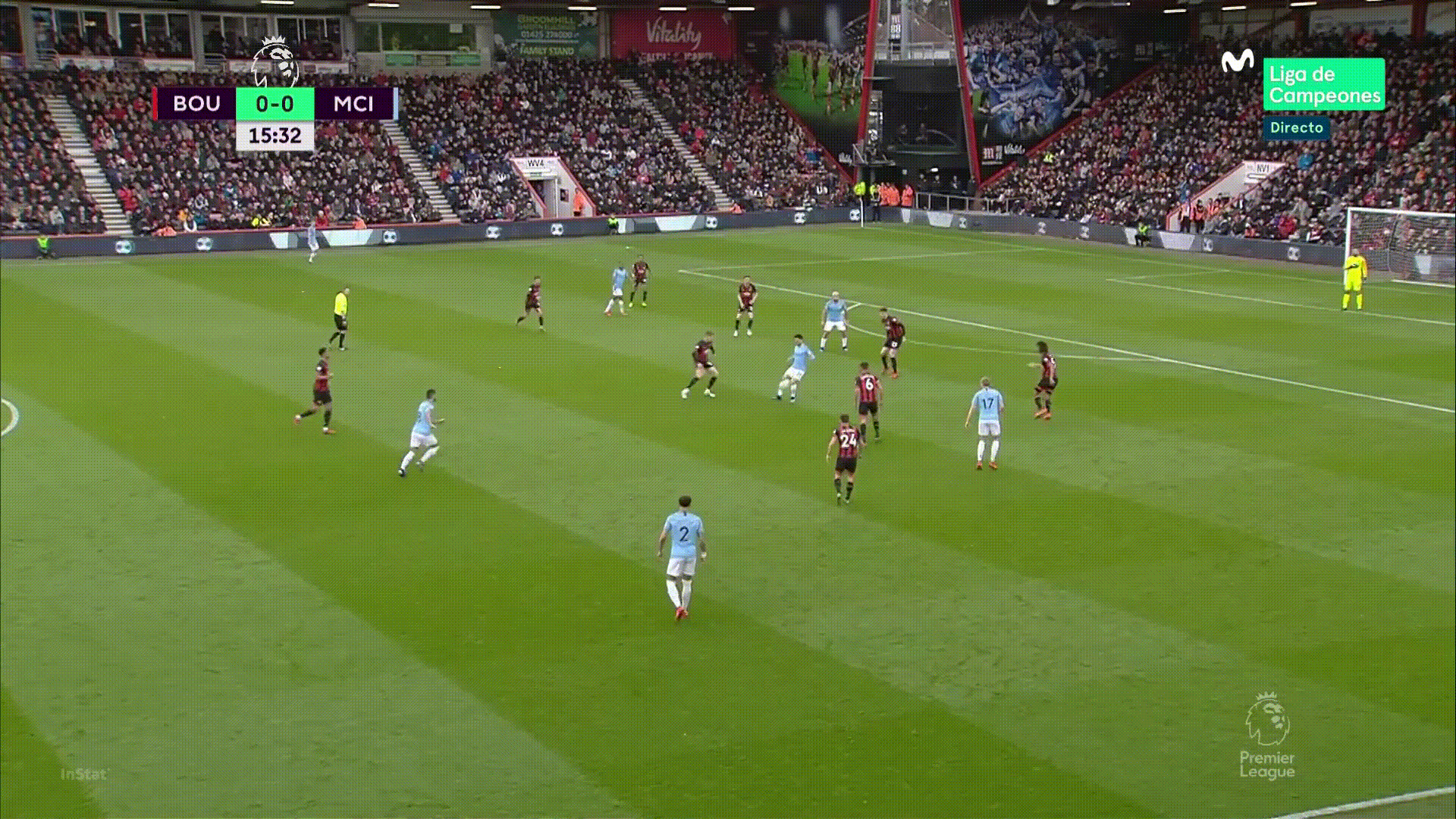
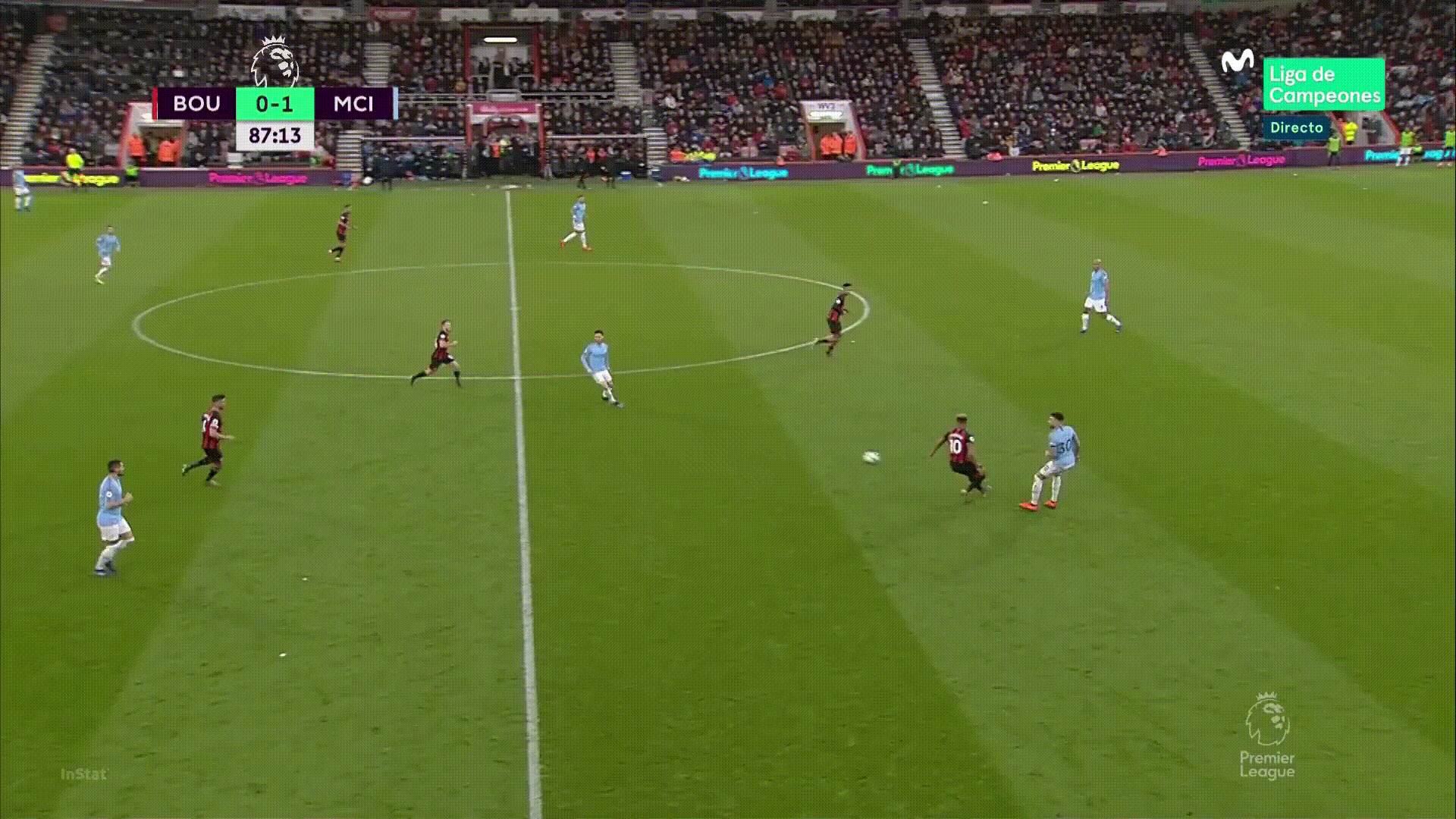
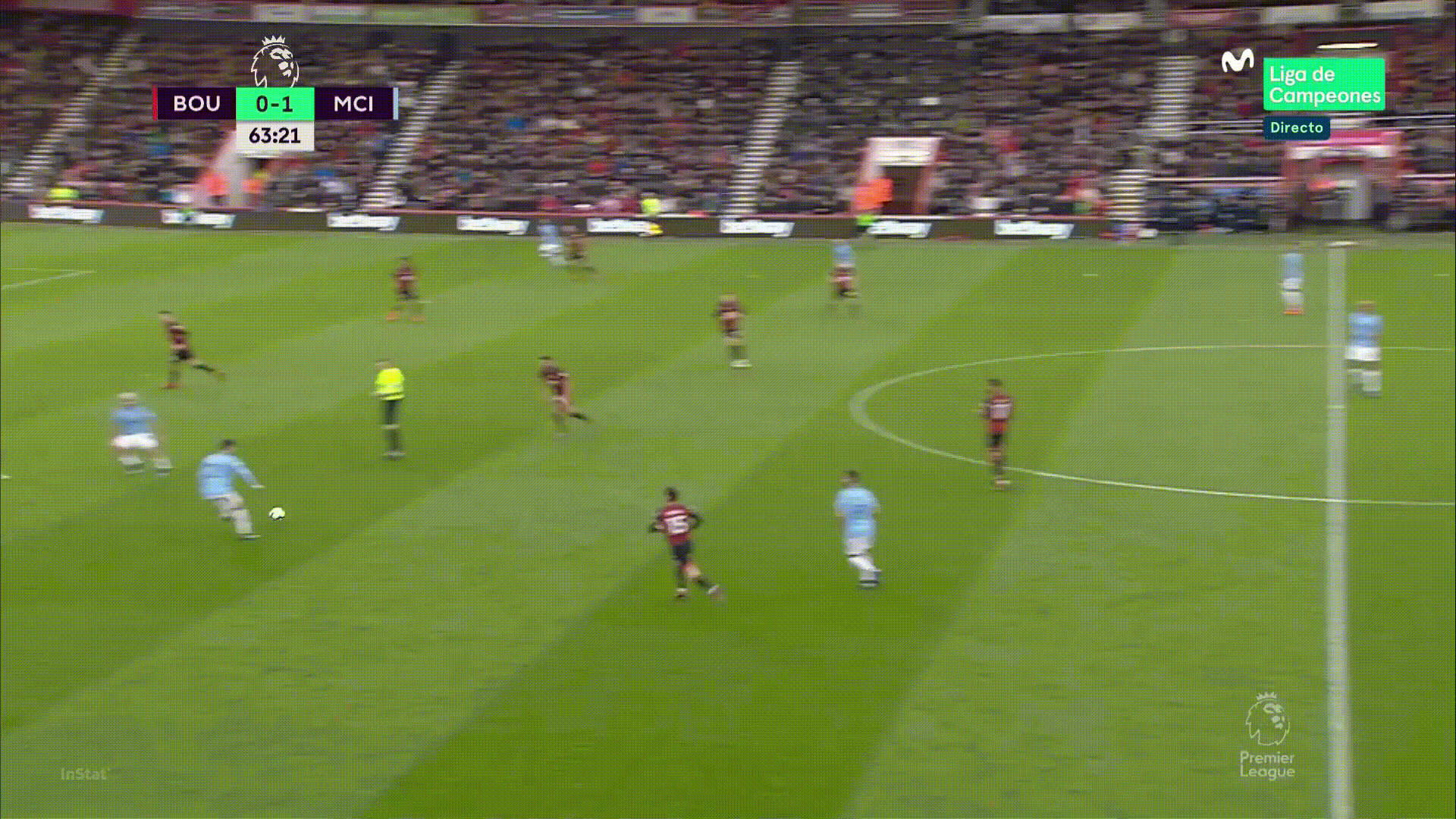
We then of course have to answer the next question why is this important? And the reason is simple, the uniqueness metric extends easily into other areas of research. Are some players more creative than others? Well, yes. Can we find out which ones? Yes, we just did that. Can we see which of these unique passes made the attack more dangerous? Not yet, maybe soon, but not now. Can we use the uniqueness to predict completion probability? I thought you’d never ask.
Pass completion probability is our next application. Starting simply, is the effect of pass uniqueness related to the probability a pass is complete? This extension was proposed in the original framework, but lacked the sample size to really test it. I am lucky enough to have plenty of data at my finger tips. Using only the pass uniqueness to predict the probability of a pass is completed we constructed a simple logistic regression model. Given the assumed non-linearity of the pass uniqueness metric, we fit the model using a natural spline with 5 degrees of freedom.

The relationship between uniqueness and pass completion is pretty clear. For very common passes, there is a quadratic relationship with pass completion probability, reaching a peak completion probability of 90+% around a uniqueness of 2.4 or the lower 25th quantile of uniqueness and then there is a sharp decline in completion probability until a uniqueness of 3.5 (70th quantile of uniqueness) where the passing percentage continues to decline as uniqueness increases albeit less drastically. Intuitively, the more common the pass is the more likely it will be completed, and the more unique it is, the less likely it will be completed.
We checked the accuracy of the model using an ROC curve and found favorable results.
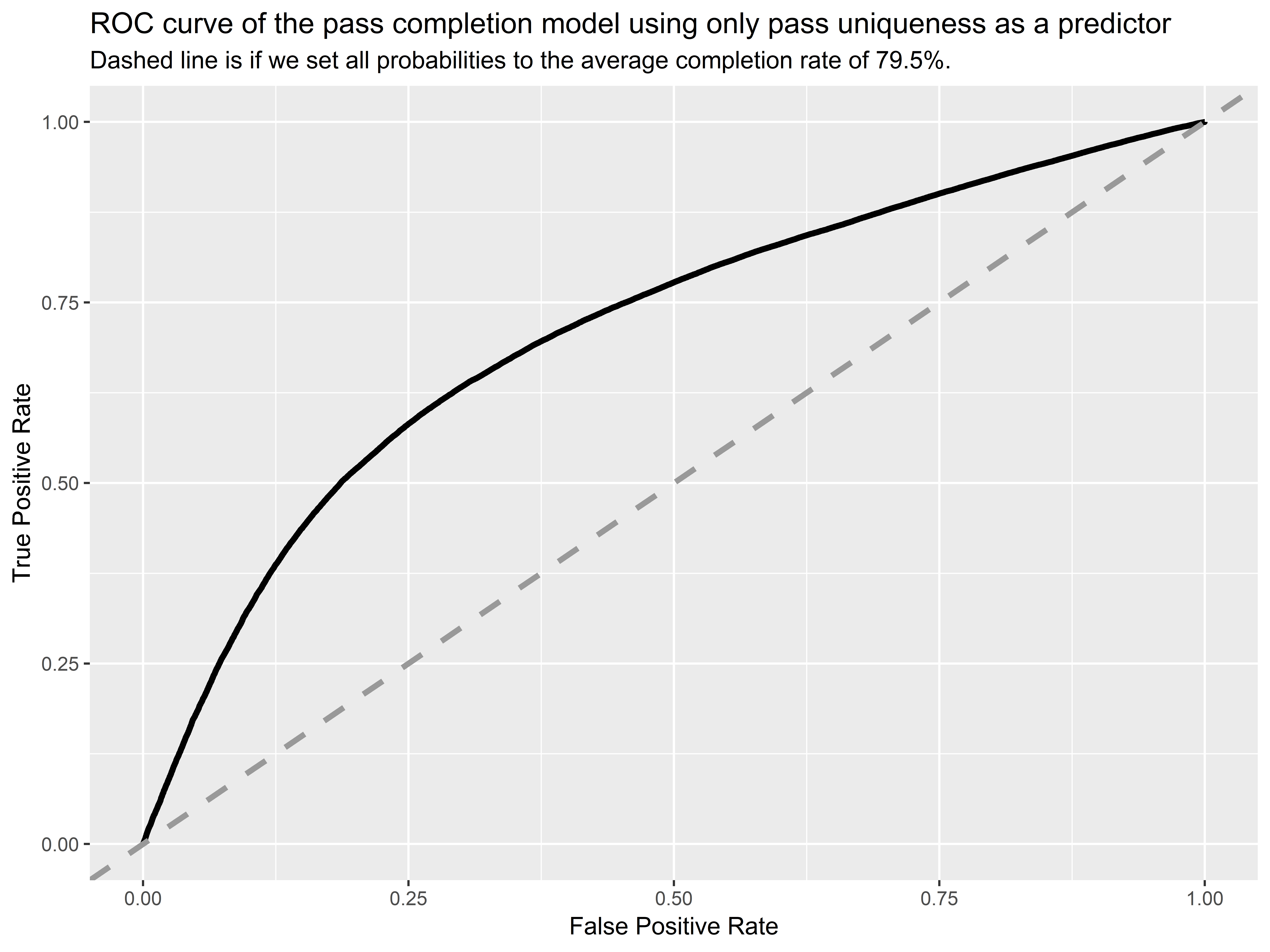
The model is performing better than assigning the average completion rate to every pass, but there is definitely room for improvement. The area under the curve is 0.71 which is far greater than no model at 0.5 but also a ways away from a perfect model at 1.0. In a follow up post, we will work through a more comprehensive pass difficulty model.
The extensions of this metric are endless and we are excited to dive into them further. For starters, the uniqueness metric is already summarizing some pretty complex relationships between pass characteristics and pass difficulty. It’s already teasing out passers who regularly defy football norms for better or for worse. This leads us to our greatest challenge, extracting unique and positively contributing passes that don’t just move the ball forward but improve build up play for the entire possession, not only the immediate reward. We’ll catch up with you soon with our next passing article in this series.
Header image courtesy of the Press Association
There’s a nostalgia about the Premier League of the late ’90s and early 2000s that makes one position in particular especially romantic. For all the Henrys and Shearers of the day, there were those behind them making the team tick. These iconoclasts of lad-ism, purveyors of proper football, were generally known as hard men. Tasked with a vague description of adding ‘steel’ and ‘heart’ to the center of the pitch, the ability to impose their masculinity on inferior players through physicality allowed many average midfielders to achieve legendary status as they fouled, fought and intimidated their way into the annals of history.
Outside of the moralizing rhetoric ascribed to the necessary, if uncomplicated, job they performed, the importance these players assumed at the time made sense. Without a universal implementation of team tactics, a superior physical presence in the middle of the pitch would’ve surely made the difference in a time where manipulating space and tactical positioning was but a twinkle in a tactics blogger’s eye. It was, after all, an era revolutionized by the idea that simply cutting back from two packs a day might make running easier.
Alas, as postmodernity began its wholly encompassing creep upon a mainly white but sometimes black world, the death of the hardman came fast. Though the words of these ancient heroes would forever echo in the places of punditry mere meters away from the pitch, the players who replaced them were far from the cardboard cutouts of yesteryear. Midfielders with supreme technical ability, ones whose awe-inspiring passes could palpably harness the movements made by cogs perpetuating more advantageous footballing ideologies, were now preferred to the ever-aging figureheads of fear. The Alonsos and Pirlos of the world set forth a basis for which the next ideal form could exist.
With better use of spacing, pressing, and passing all taking hold, it’s no wonder the current crop of influential midfielders all maintain some confluence of everything that came before them. As much as one might jest, there would be no Frenkie De Jong without Roy Keane, no Jorginho without Vinnie Jones. However different their jobs may appear to be, each step in football informs the next in the same way each evolution of players influences those who grew up watching them. This generation, like any other, has a class of individuals endowed with special abilities that make them uniquely talented.
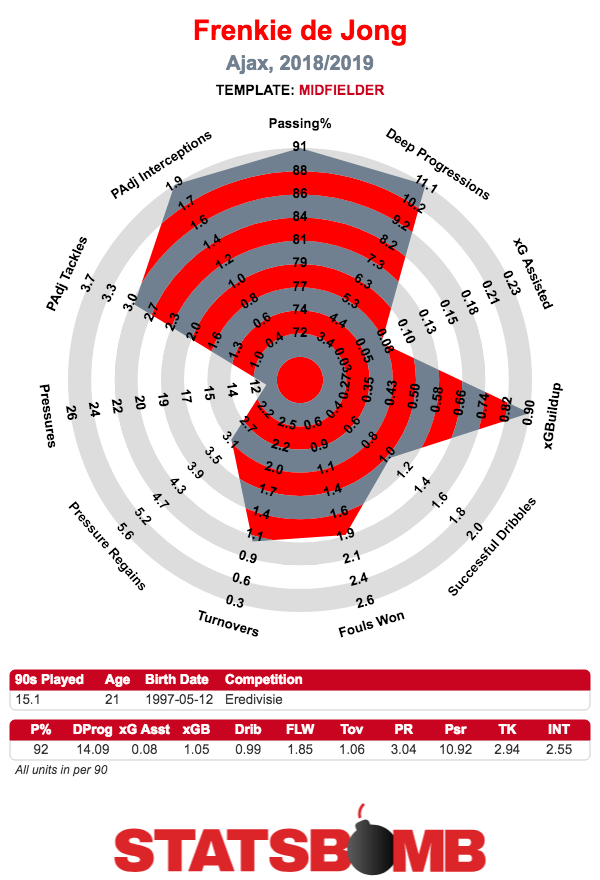
Everyone’s favorite twitter clip-up player, Frenkie De Jong, is probably the most obvious example of someone with special individual qualities. What allowed a 21-year-old to command such a high price is down to the way he progresses the ball, but dribbling and incisive passing is just a part of how De Jong draws defenders towards him and clears out space further up the field. Barcelona, the spiritual and commercial successor to Ajax in Europe’s top five leagues, will be looking to harness what’s at the base of his exceptionally high deep progressions. His holistic understanding of relative positioning allows him to seamlessly transition between defense, midfield, and attacking lines without leaving gaping holes in the team.
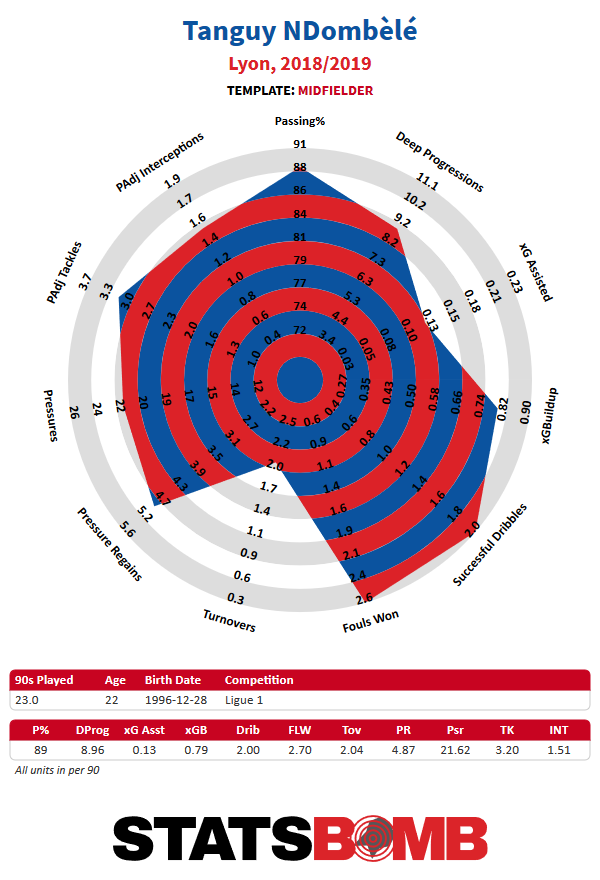
Tanguy Ndombele is another case of a player with an innate-ness worth its weight in gold. Similar to De Jong, his elite dribbling ability and inclination to do so in midfield areas makes him extremely dangerous in transition and when the opposition is looking to press high up the field. Amazingly, Ndombele’s game-changing ability carries over to his passing and pressing attributes as well, making him a safer prospect than midfielders like Tiémoué Bakayoko and perhaps even Naby Keïta- ones who benefitted from the tactical dynamic of a team that saw a lot of space in midfield because they weren’t expected to monopolize possession. Once they made their moves to teams who are forced into having less space in transition or during their average game, they had less space to operate. They’re still the same, amazing players they were before, but they’re in a different environment. NDombele’s passing, pressing and general play suggests that his wide range of abilities would supersede a transition from any tactical dynamic.
What strings these elusive transfer targets to players like Georginio Wijnaldum or Miralem Pjanić, however, is how they distribute the ball. The common, almost necessary attribute underpinning any well-known midfielder of this ilk is their intelligence on the ball. Though that may seem like something that makes any midfielder during any era of football great, the underlying conditions most possession teams must operate in relation to have called for today’s deep-lying midfielders to be everything their positions were before and more. Jorginho might not have the physicality of a Patrick Vieira, but the circulatory manner in which he uses Maurizio Sarri’s structure to circumvent pressing actions can achieve a similar result.
These players are not only ensuring the passage of possession to the final third, but they’re distributing in a way that protects the team from a counterattack. It’s what coaches like Pep Guardiola and Mauricio Pochettino are talking about when they refer to players who “see the space.” It’s not about directly assisting an attacking player or literally playing a forward into an open area; it’s about ensuring the entire team is at equilibrium. Possession nowadays is more about knowing how to possess the ball than it is merely maintaining the players and structures to do so.
A good example of this frustratingly unquantifiable kind of distribution is Miralem Pjanić’s performances against Atletico Madrid in the Champions League. Plagued by flu-like symptoms, Pjanic’s passing was slow and labored in the first leg. His distribution, in addition to a strange positional experiment where Rodrigo Bentancur only served to open up space for Pjanić, allowed Atletico to corral possession in areas where they could win it back and counter from. The second leg was a different story.
In that game, Pjanić was back to his brilliant best when Juventus needed him most. Tasked with deciding whether the ball was best used at the feet of Leonardo Spinazzola and João Cancelo or directly to Cristiano Ronaldo, Mario Mandzukic, and Federico Bernardeschi, Juventus were able to overcome their 2-0 deficit without the presence of traditionally creative number ten. The crossing used by the fullbacks was relatively risk-averse considering the midfield of Blaise Matuidi, Pjanić and Emre Can were ready to sweep up if Atleti wanted to spring forward. When the more direct option presented itself, Pjanic bypassed the eager, ball-winning Atletico midfield through lofted balls from himself, Leonardo Bonnucci, and Giorgio Chiellini.
The entire approach addressed the gravity of their situation while never erring into the rashness of overexposing themselves in places the opposition would’ve wanted them to. One might argue that if Massimiliano Allegri had deployed someone like Paulo Dybala through the middle from the start -the kind of player that was going to take risks in possession for the sake of creating attacking opportunities- they might not have survived to face Ajax. That isn’t to say Pjanić is better or more valuable as an attacking player than the Argentine, but it does underline the subtle role players like Pjanić serve.
It’s a similar case with Georginio Wijnaldum. Though his performance in many of the categories pales in comparison to his midfield compatriots, Wijnaldum finds himself an increasingly important cog in Klopp’s current Liverpool. With their greater emphasis this season on beating teams who ask questions of their possession game, Wijnaldum’s intelligence in distribution sees him selected over players who are more gifted in other, more directly observable ways. As much as Liverpool fans might cry out for a more ostensibly attack-minded midfield option, because of how he moves the ball, he’s as essential to the chances their front three ends up creating as he is snuffing out the moments where Liverpool are vulnerable. It’s Liverpool’s system that has the most influential part in creating chances, not the individual brilliance of sole players- an ethos carried over to the dynamic of their title rivals, Manchester City.
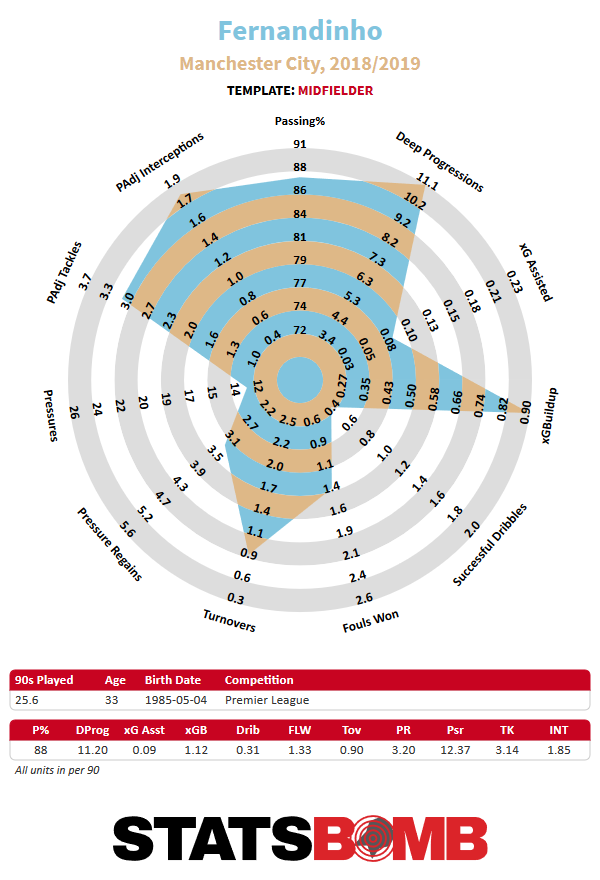
Despite İlkay Gündoğan being touted as Guardiola’s next necessary midfield component when he first arrived at City, it’s been Fernandinho that has dominated the position. While much of Gündoğan’s absence can be attributed to injuries, Fernandinho’s understanding of what Guardiola needs, in addition to an extraordinary ability to foul, foul, and foul some more for the sake of stopping counter-attacks, is part of what has made him indispensable to the team. Guardiola still speaks highly of the German’s ‘scent for goal,’ and with recent performances in the league and at Schalke, it appears that just three years on, Gündoğan is finally understanding the role he needs to play to justify a place alongside Kevin De Bruyne and David Silva. But whether Gündoğan can temper his own individual attacking inclination with the intelligence and defensive attributes Fernandinho brings to the team remains to be seen.
With football forever synthesizing by reacting to its own evolutions and revolutions, each period distinguishes itself by the exceptional players its time gives birth to. We rightly associate a previous era with Keane and Vieira because they’re the ones who were in the right place and the right time to define it. Strength, a body full of intangibles, and some skill allowed them to command the landscape that existed at the time. Now, with sports science, data, and a metaphysical focus on how to best succeed in an increasingly rocky environment, the players we’ll remember when our children's children are mocking up hologram clip-ups for the twenty-minute shuttle ride across the planet will be those who defined the era with their attributes — those who knew how to move the ball.
As the season approaches the home stretch, the table looks pretty much as expected, and as expected goals predicted it would. But ignoring the journey to highlight the destination misses the point.
I write A LOT about analytics. Obviously. There’s a word, however, that I avoid like the plague. I don’t use it in my writing. If I can edit it out of other writer’s work without too much pain I put the proverbial line through it. On podcasts (especially of the non-analytics bent) I do all sorts of linguistic gymnastics to talk around it. That word is regression. And that goes double for its nerdier, more technically accurate cousin, regression to the mean. Unless I’m absolutely cornered and there’s no way to avoid it, I simply won’t type, or tweet, or say those words.
There’s no problem with the concept of regression. Two separate flavors of it generally operate in the football world. First, team performances generally regress to their resource levels. That is, spending eventually equates to points. It’s not a perfect relationship (no relationship ever is) and spending both fluctuates and can have a time lag involved. But, as a rule, it’s a pretty good one. The more a team spends the more points they’re likely to have.
Second, teams’ goals scored and goals allowed generally regress to their expected goals levels. That’s what makes expected goals the gold standard of predictive stats. It works. When it comes to predicting the future, expected goals is a better indicator of where things are going than anything else, including shots or goals themselves. That’s what it was designed to do and that’s what it does quite well.
So, why don’t I use it? Well the first issue is a technical one. Regression, which is a true thing that happens, all too easily slips into gambler’s fallacy which isn’t. A team that’s getting lucky isn’t due to get unlucky to balance things out. They’re just due to stop getting lucky. That’s a small but crucial difference in how to best analyze these things. Without being very careful with argumentation it’s simply very easy to slip into the language of gambler’s fallacy on the world evening things out, when what’s closer to the truth is that the world doesn’t really care.
But there’s another more fundamental reason I avoid regression, and that's the way it reduces discussions to a single variable. That’s the power of expected goals, it reduces it to a single number, which is what makes it useful. It also hides everything that’s going on under the hood. And that’s the interesting stuff.
The reason expected goals, and by extension regression in general, works is that there are a million factors that go into the equation. The reason things become unsustainable is precisely because it takes any number of things lining up just right to break loose of the underlying numbers, even for a limited time. Talking about regression makes it seem like an issue of one thing changing, when really it’s about weighing which of the 17 different things currently going right is likely to go wrong.
Which brings us to this season. The table looks pretty normal. The top six are the top six. Manchester City, as expected, are odds on to win the title with Liverpool second. The battle for fourth is alive and well. There are, from a big picture xG perspective, relatively few surprises. What that misses though, is all the ways that teams might have done something unexpected, even though they ultimately didn’t.
At every point this season there have been things that have been tantalizingly close to becoming interesting and defying expectations. The way the world works is that most of those things won’t come to pass. This season maybe none of them will. That doesn’t mean they’re impossible.
Take Arsenal for example. The beginning of their season was a classic case of regression to the mean waiting to happen. The combination of a ridiculous winning streak with mediocre underlying numbers screamed unsustainable. There was a shot, however, that under a new manager that mean might improve. That Unai Emery might implement his new system and improve the team so that as their luck was running out, their numbers would improve. Such possibilities are the things from which xG defying seasons are born. It didn’t quite happen.
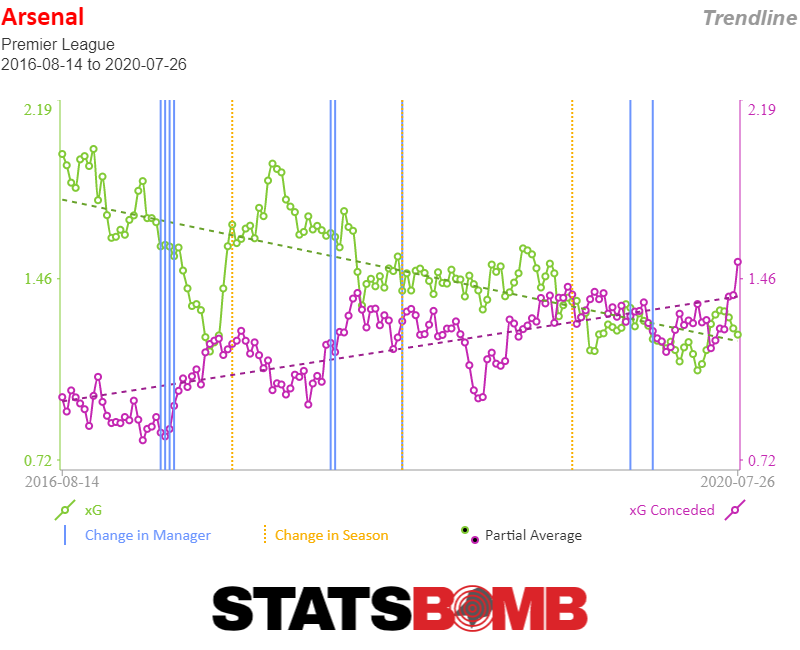
What did happen is that Arsenal suffered a rash of injuries right when it appeared things might be coming together and that’s all it took. The beauty of using regression as a tool is that you can be fairly confident that eventually something will go wrong, without having to predict exactly what. The beauty of sports is in the exactly what.
Across North London something similar is happening for Spurs. Spurs under Pochettino are the rare side that can claim to regularly beat their xG numbers. But there’s beating your xG and then there’s what Spurs were doing at the height of this season. It seemed like absolutely nothing was going to slow that train down.
Don’t have a midfield? No problem.
Star player after star player gets hurt? No big deal.
Even losing Harry Kane didn’t slow them down. And then, right as everybody got healthy, and it seemed like a great season was looking nailed on, bang, they’ve taken a exactly one point in the last month, a four game stretch which included losses against relegation candidates Burnley and Southampton.
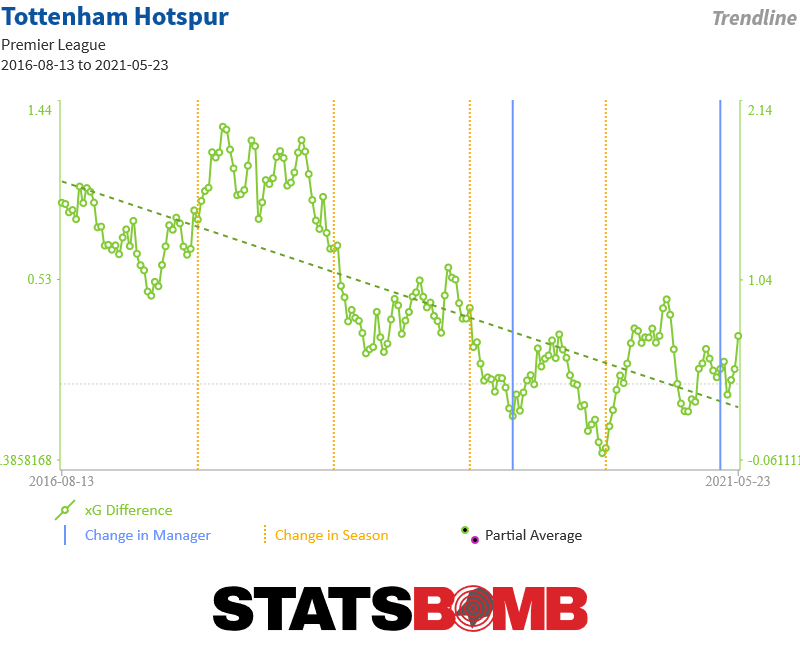
While the Arsenal story is easy to tell, the Spurs one is harder.
What exactly changed?
Maybe they were just getting lucky all along and that luck ran out at precisely the wrong moment. Maybe their short squad was fatigued and as the miles piled up they lost whatever little edge their cult leader of a manager had managed to install. For Arsenal, the story of regression obscures the story of exactly what happened this season.
For Spurs, it obscures a still unanswered question (a question which may not have an answer beyond the whims of the gods). Understanding the concept of regression to the mean is important. It’s the landscape on which the story of the season is set. But the work of analysis, of watching football and breaking it down, and mining the ins and outs in a search for the why of it all, that’s what brings the story to life.
Understanding the underlying math makes it clear that most of the things that could, in theory, happen over the course of a season will not. But some will.
And relying on regression closes off avenues of investigating what, if anything, causes those departures. Understanding why unsustainable things happen is as important as understanding that they’re unsustainable. And that’s why, while regression is important, it’s best use is in the background. The Premier League season so far has been an eventful and fascinating journey, but all that a typical regression will point out is that the destination seems pretty dull.
Why does anybody do analytics? Another Sloan Sports conference has come and gone. For those who don’t know, the conference, held annually at MIT in Boston, is basically a trade show for sports analytics. Panels abound, there is glad handing galore, resumes are passed, and on panel after panel numbers are endlessly hashed and rehashed. Oh, and also, Meek Mill was there, because reasons. There’s also math. Papers are submitted, awards are handed out, posters are posted. And the thing about the math in the modern days of analytics is that it’s really complicated. There was a time when the bulk of analytics work was doing basic math and applying it to sports. That time is not this time, at least not at Sloan. When the math gets as complicated as it has, it presents a new set of challenges for the people doing the work. Part of the reason that football analytics coalesced around expected goals is that it fits comfortably within how people, both coaches and fans, traditionally think about the game. How many chances were created? How good were those chances? Would you rather have a lot of speculative efforts or a couple of golden chances? It’s not only that the questions xG sought to answer were ones that people intimately familiar with the game were already asking, it’s that it’s methodology was fairly simple as well. Look at all the shots, factor all the things that went into them (where they were, what part of the body they were with, now increasingly where the defenders in front of them were) throw in just a little dash of math to figure out how best to weight the variables, and you have an answer that works well (but clearly not perfectly) for both descriptive and predictive purposes. But, as analytics increasingly moves into the spaces behind the shots, into they “why” of it all, the chasm gets harder to bridge. The next step, one which we’ve presented some methodology on, is building a passing model. The idea is to do for everything before the shot what xG did for shots, answer the same questions everybody is asking, but do it in a rigorous stats based manner. Who is moving the ball forward into the best areas? Who is too aggressive with their passing, or too conservative? Who uses space to spring attacks, who consistently wastes it and fails to play the ball into advantageous areas? How much credit does a player who started a move deserve? Which passes are the most important and unique ones, and which ones are the kinds of passes that most players can make? These aren’t easy questions to answer. And while xG involved taking factors that everybody understood and adding in a sprinkling of math in order to get results, passing models are the opposite. Because, from a stats standpoint, the problem is so hard, the math to try and solve it becomes, well, a whole lot more mathy. There’s no avoiding the fact that building a passing model involves doing a lot of work that people will have neither the inclination nor the training to unpack. So, why do it? For people working inside the game that’s an easy answer. To get an edge. The hope is that a good passing model well implemented will turn up players that other methodologies miss. With limited time and limited scouting budgets, the ability to use numbers to unearth a handful of hidden gems to then send your scouts off to further investigate provides great value for teams. It’s hard to access that value of course. The process needs to run smoothly. A manager needs to communicate what he needs from a potential new player, the scouts and analytics department have to work together to unearth possible players that fit the bill, and then everybody has to crosscheck, see where their Venn diagrams overlap, and finally the business people need to execute the deal on any gems you may find. It’s hard to do it well, but it’s easy to explain why you’d go about that task. It’s a little bit harder when that task moves over to the media side of the game. On one level, I, as managing editor of an analytics website, find the process of analysis itself interesting. There is clearly some degree of public interest in how teams try and improve themselves, and what they could be doing better as they try and get a leg up on their competitors. Whether it’s youth systems, or set piece coaches, or state of the art medical facilities, or any of a million other little edges teams pursue, it’s interesting to supporters to report on what teams are doing to try and get better. But, at a more basic level, using analytics is also supposed to help us understand the game we’re covering better. Using xG helps people covering the game explain what’s happening. It’s easier now to pinpoint which teams good results are coming from a streak of hot finishing that’s unlikely to continue (think Arsenal earlier this year for example) or which struggling goal scorer is likely to come good. It will be more challenging for analytics writers to do the same with passing models. That’s not to say it’s impossible, but the added layer of math abstraction requires more translation. It’s not enough to say that a model demonstrates a player being good, it’s important to understand the model well enough to understand in football terms what he or she is good at. Similarly, if a model doesn’t rate a player, but that player seems to do some obvious things well, it’s incumbent upon the person citing the model to be able to explain in football terms what they’re taking off the table. Complex modeling is valuable. It will often pick up on things that the human eye does not. Used in concert with other tools it makes scouting and understanding the game easier. But modeling doesn’t explain itself. It’s never enough to shrug and defer to the model. Model’s, for them to work, must be integrated into a fundamental understanding of the game they’re modeling. When the models are relatively simple, like with xG, that’s a small hurdle to overcome. As the math gets more complex, the explanations get harder. That doesn’t make them any less important. Header image courtesy of the Press Association
How do you replace a superstar footballer? Stars, by their very nature, are hard to replace; that’s why they’re stars. At any moment, there’s only a handful of Ballon d’Or-caliber players out there. Only some of them have their best years ahead of them. Even at a young age, these players tend to cluster at the world’s richest clubs. Only a subset of those clubs can afford to buy a superstar. Every time such a transaction occurs, the selling club must try to replace someone whose value stemmed from the absence of any comparable alternatives. This remains unfamiliar territory. The blockbuster transfer of a superstar, even in this era of TV deals and rising fees, remains a rarity. Good players are bought and sold in every window, but the transfer record has only been set seven times in this millenium. (The nominal fee for Hernan Crespo, the millennium's first record-setter, is about what Manchester City paid for Benjamin Mendy.) It’s still unusual for a club to lose a singular player and bring in the kind of money that allows for meaningful squad reconstruction. Spare a thought, then, for Tottenham Hotspur in the summer of 2013. The club had just sold Gareth Bale for a then-record €100.8 million. He really was that good, the closest thing to a one-man team and just entering his prime. Now what? In short, Spurs turned their Bale money and some spare cash into seven new signings, none of whom cost more than 30 percent of the Bale fee. Since nobody remembers what nine-figure fees meant in 2013, it’s helpful to think of what comparable fees netted in the Premier League that summer. Let’s remember some guys:
- Roberto Soldado and Erik Lamela, the two biggest purchases, each cost a bit less than Marouane Fellaini and a few million more than Stevan Jovetic and Alvaro Negredo.
- Paulinho’s transfer fee ranked between those paid by Chelsea for André Schurrle and Southampton for Dani Osvaldo.
- Christian Eriksen basically cost Spurs as much as Cardiff City spent on Gary Medel.
- Étienne Capoue’s acquisition was equivalent to Simon Mignolet’s move to Liverpool.
- Vlad Chriches cost Spurs about £500,000 more than Cardiff paid them for fellow center back Steven Caulker. His fee was tantamount to what Southampton spent on Dejan Lovren and Norwich spent on Ricky van Wolfswinkel.
- Nacer Chadli’s price matched what Liverpool spent on each of Tiago Ilori and Iago Aspas and Aston Villa spent on *squints at notes* Libor Kozák.
Nearly six years later, as various mega-clubs look set for serious rebuilds, it’s worth revisiting the strategies implicit in that list of names. Some of Spurs’ signings may have faded from memory or become less interesting, but their stories can help us better understand the value of capital-s Stars and the challenges of replacing them. /// Spurs immediately conceded that no available player could match Bale’s production (26 goals and 15 assists in 2012-13). The club sought to spread the responsibility between a nominal replacement (Lamela) and upgrades at other positions. Clubs often tell the press — or themselves — a version of this argument when replacing a crucial player. Spurs had tried it the year before, replacing Luka Modric and Rafael van der Vaart with the likes of Hugo Lloris, Mousa Dembélé, Jan Vertonghen, Gylfi Sigurdsson, Clint Dempsey, and Emmanuel Adebayor. Bale ironically became part of a similar argument last summer, when Real Madrid claimed its squad could replace Cristiano Ronaldo’s production. Players like 2013-vintage Gareth Bale are useful in large part because they concentrate so much production in one position. The remaining ten outfield players still contributed but they benefited from the attention paid to their star teammate. Jermain Defoe’s 2012-13 tally of 15 goals was useful to a team with Gareth Bale, but would be insufficient without him. For a team that had given more than 2,000 minutes to each of Aaron Lennon, Dempsey, Michael Dawson, Sigurdsson, Adebayor, Sandro, and Scott Parker in Bale’s final season, versions of this predicament existed at most outfield positions. Signing a superstar is expensive, but upgrading multiple positions to replace the lost production isn’t exactly cheap. Discussing players’ records in absolute terms obscured the cost of replacing all this production. Roberto Soldado arrived in London talking about scoring 20 goals. The number sounded impressive: 20 goals is a lot more than none and a lot more than what you or I could score. It is not, however, that much more than Defoe’s 15. A five-goal upgrade at striker was not going to make up for the very serious downgrade at Bale’s winger-ish position. What really mattered was the new signings production relative to the players they displaced. A club like Tottenham can buy a 10 goal player. Buying a ten-more-goals player is much harder — and Spurs needed more than one such player. It’s worth considering something approaching the best-case scenario for this strategy: Lamela contributes half of what Bale did, Soldado scores 20 goals, every signing starts and improves on an incumbent, nobody regresses. Forget for a second that most of these things did not happen. What reason was there to believe that buying two players from the part of the transfer market where title-chasing clubs purchased marginal starters and a handful of squad players would do the trick? This was akin to fielding Manchester City’s weakened team for cup ties for and expecting to compete for fourth. The players were not unusual flops. With the possible exception of Chiriches, who cost as much as Dejan Lovren (but also Ricky van Wolfswinkel), all of these signings performed about as well as comparable ones made by other clubs. They were improvements on an unimpressive squad, but that’s not all Spurs had hoped for. The strategy of spreading out production, as implemented by Spurs, could only have worked if multiple players improved in unexpected and unusual ways. In that respect, it was less of a strategy than it was an act of faith. Since the summer of 2013, teams have tended to follow the sale of a superstar with their own near-record purchases. Juventus spent the bulk of its Paul Pogba money on the bulk that is Gonzalo Higuain. Barcelona spent most of its Neymar money on Ousmane Dembélé and Coutinho. Those three replacements rank among the ten most expensive transfers in footballing history. Liverpool, in turn, spent the bulk of its Coutinho money on Virgil Van Dijk, who is also on that list. (These clubs were all richer than Spurs and had more talented squads when making these purchases.) Teams with policies of only buying young prospects have stuck to their guns, as Monaco and Borussia Dortmund did after selling Kylian Mbappé and Dembélé, respectively. Otherwise clubs have behaved as if buying one or two really good players — even if they’re at different positions — can better replace an outgoing superstar than a bevy of marginal upgrades. /// Time is rarely kind to transfers. The reality of a player — even a good one — can struggle to live up to the anticipation and techno-scored highlight clips that presaged their signing. Players age, get injured, and suddenly it’s easy to question the process that led to their acquisition. Tottenham’s post-Bale spending spree, on the other hand, has benefitted from the passage of time. What looked like a disaster in 2013 and 2014 has developed redeeming qualities. It might even be good. Christian Eriksen is the most obvious point in favour of that transfer window. Eriksen’s goodness is the least contentious part of this argument so it needn’t be belaboured. You can read StatsBomb supremo Ted Knutson’s praise of Eriksen from his first season with Spurs, which he recently told me “was SO LONG ago.” He’s still good, by the way: he leads the team in xG assisted per 90 minutes while also doing lots of central midfielder work like progressing the ball from deep and pressuring opponents. Once again, he was purchased at 21 in the same window Cardiff spent a comparable fee on 26-year-old Gary Medel. After six seasons at the club, he will either see out the rest of his prime or be sold for a princely sum. Spurs fans would obviously prefer the former, but either outcome would represent tremendous return on the original investment. 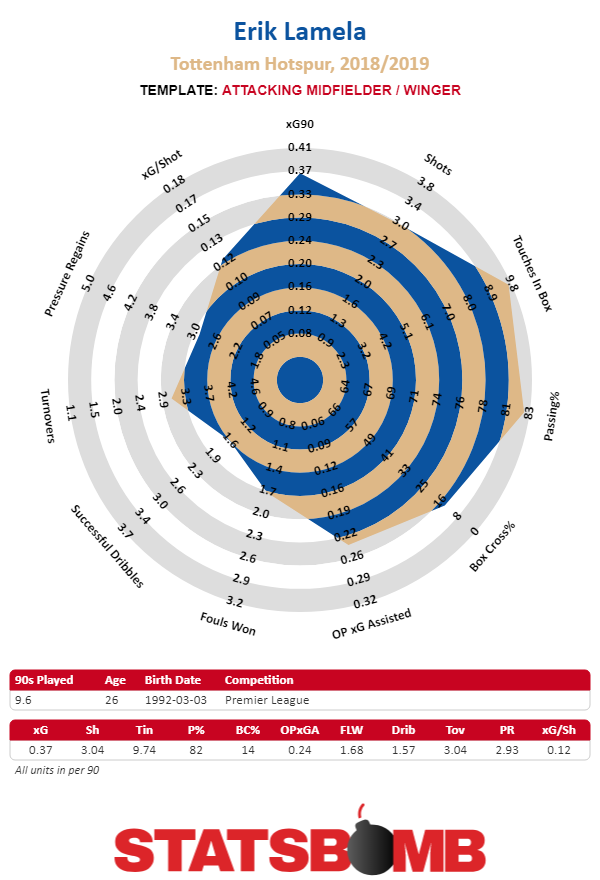 Then there’s Erik Lamela. Sometimes you buy a promising young winger — for argument’s sake, let’s call the selling club Roma — and they suddenly take the leap into Ballon d’Or contention. Other times you buy buy a promising young winger — once again let’s call the selling club Roma — and they turn out to be...pretty useful? Obviously you’d prefer the first outcome, but that doesn’t make the second one bad. Lamela has suffered from the expectation that he, of all the signings, would be Bale’s true successor and blossom into a goalscorer. That hasn’t really happened. But judged on his own term, as a tryhard who creates more than he scores while also fouling and pressing everyone in sight, he’s a good player. The caveat here is that Lamela’s per-90 statistics flatter a frequent substitute. Looking at Lamela’s unadjusted season totals, though, just drops him from being the second-best player in a variety of creative metrics to a decent fourth. (He still has the team’s second most throughballs, ranks fourth in expected goals, and a joint fourth with Dele Alli in scoring contribution.) The suboptimal outcome for a good, young player purchased for £27m, even in 2013, can still be quite good. Roberto Soldado, who showed some promise under Andre Villas Boas, was the most obvious flop. He was the oldest and most expensive player Spurs signed in 2013, never came close to scoring his promised 20 goals despite being in his prime, and lost much of his value in his two years with the club before being sold at a substantial loss. Negredo and Jovetic — the other strikers who came into the league for similar money that summer — weren’t great either, but Soldado was genuinely bad. There not being an obviously better option doesn’t change that fact. The other players at least took minutes away from some of the duds in the squad before being sold on at minor losses after a couple years. Nacer Chadli, the pick of that bunch, was a competent player who was sold on for basically the same nominal fee Spurs had spent in 2013. In the case of the more aged Paulinho, Spurs were bailed out by the existence of the Chinese Super League, but that’s what it’s there for. Chadli and Capoue went on to have useful careers lower down the Premier League table. Chiriches offers some depth at Napoli. Other than Paulinho, whose career is decidedly weird, these players appear to have found their levels. A buying club might want more Eriksen-style hits, but the “more is more” portion of the transfer list generally performed as you’d expect. Spurs, in other words, signed one of the midfield bargains of the decade in Eriksen, a promising young attacker who turned out fine, a dud of a striker, and some squad players who did squad player things before being sold on. One can credibly argue that they more than broke even on the summer’s business. And it was nowhere close to enough. Sixth place flattered Spurs in 2013-14. The new players were supposed to at least competently eat up minutes, but Nabil Bentaleb played more than 1,000 league minutes in that first post-Bale season. Both Bentaleb and Ryan Mason topped the 2,000 league minute mark in Mauricio Pochettino’s first season despite being, well, not very good at midfield things. You can, it turns out, get decent returns on your spending spree to replace a superstar and still end up much worse off. More than anything else, the lesson of Tottenham’s 2013 transfer travails may be that elite players — even the ones who bring in record fees — can be undervalued. Bale was known to make up for Tottenham’s talent deficit, but the extent of that deficit only became clear after he left. (This is likely less of an issue for other record sellers like Barcelona or Juventus, who have more talented squads.) Spurs made out okay with their Bale money, and it still took a major managerial upgrade, multiple good signings in subsequent windows, and the elevation of one of the league’s best strikers from the youth ranks for them to return to competitive relevance. A club can’t count on a grab bag of signings to replace the production of a superstar in the best of circumstances, but when those signings are purchased with a windfall that doesn’t reflect the lost star’s value the whole undertaking is basically impossible. Header image courtesy of the Press Association
Then there’s Erik Lamela. Sometimes you buy a promising young winger — for argument’s sake, let’s call the selling club Roma — and they suddenly take the leap into Ballon d’Or contention. Other times you buy buy a promising young winger — once again let’s call the selling club Roma — and they turn out to be...pretty useful? Obviously you’d prefer the first outcome, but that doesn’t make the second one bad. Lamela has suffered from the expectation that he, of all the signings, would be Bale’s true successor and blossom into a goalscorer. That hasn’t really happened. But judged on his own term, as a tryhard who creates more than he scores while also fouling and pressing everyone in sight, he’s a good player. The caveat here is that Lamela’s per-90 statistics flatter a frequent substitute. Looking at Lamela’s unadjusted season totals, though, just drops him from being the second-best player in a variety of creative metrics to a decent fourth. (He still has the team’s second most throughballs, ranks fourth in expected goals, and a joint fourth with Dele Alli in scoring contribution.) The suboptimal outcome for a good, young player purchased for £27m, even in 2013, can still be quite good. Roberto Soldado, who showed some promise under Andre Villas Boas, was the most obvious flop. He was the oldest and most expensive player Spurs signed in 2013, never came close to scoring his promised 20 goals despite being in his prime, and lost much of his value in his two years with the club before being sold at a substantial loss. Negredo and Jovetic — the other strikers who came into the league for similar money that summer — weren’t great either, but Soldado was genuinely bad. There not being an obviously better option doesn’t change that fact. The other players at least took minutes away from some of the duds in the squad before being sold on at minor losses after a couple years. Nacer Chadli, the pick of that bunch, was a competent player who was sold on for basically the same nominal fee Spurs had spent in 2013. In the case of the more aged Paulinho, Spurs were bailed out by the existence of the Chinese Super League, but that’s what it’s there for. Chadli and Capoue went on to have useful careers lower down the Premier League table. Chiriches offers some depth at Napoli. Other than Paulinho, whose career is decidedly weird, these players appear to have found their levels. A buying club might want more Eriksen-style hits, but the “more is more” portion of the transfer list generally performed as you’d expect. Spurs, in other words, signed one of the midfield bargains of the decade in Eriksen, a promising young attacker who turned out fine, a dud of a striker, and some squad players who did squad player things before being sold on. One can credibly argue that they more than broke even on the summer’s business. And it was nowhere close to enough. Sixth place flattered Spurs in 2013-14. The new players were supposed to at least competently eat up minutes, but Nabil Bentaleb played more than 1,000 league minutes in that first post-Bale season. Both Bentaleb and Ryan Mason topped the 2,000 league minute mark in Mauricio Pochettino’s first season despite being, well, not very good at midfield things. You can, it turns out, get decent returns on your spending spree to replace a superstar and still end up much worse off. More than anything else, the lesson of Tottenham’s 2013 transfer travails may be that elite players — even the ones who bring in record fees — can be undervalued. Bale was known to make up for Tottenham’s talent deficit, but the extent of that deficit only became clear after he left. (This is likely less of an issue for other record sellers like Barcelona or Juventus, who have more talented squads.) Spurs made out okay with their Bale money, and it still took a major managerial upgrade, multiple good signings in subsequent windows, and the elevation of one of the league’s best strikers from the youth ranks for them to return to competitive relevance. A club can’t count on a grab bag of signings to replace the production of a superstar in the best of circumstances, but when those signings are purchased with a windfall that doesn’t reflect the lost star’s value the whole undertaking is basically impossible. Header image courtesy of the Press Association
